Paul Finch's Blog, page 7
December 17, 2020
Anyone up for another seasonal screamer?
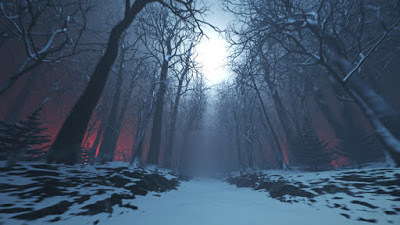
Christmas seems to have come astonishingly quickly this year. Too quickly, alas, for the vaccine to really save it. Unfortunately, we’re going to have a very stripped-down version of the festive season in 2020. However, there’s one tradition you can rely on as much this year as in all those past. And that is my annual posting of a seasonal horror story on this blog.
I must admit that 2020 has been an unusually busy year for me on the short story-writing front. Though I’ve been eyebrows deep in my novels as well (ONE EYE OPEN came out in August), I’ve somehow managed to find the time to bring out a new collection of Christmas ghost stories, THE CHRISTMAS YOU DESERVE, to re-issue an older collection and an older novella, IN A DEEP, DARK DECEMBER and SPARROWHAWK, and to publish via SAROB PRESS a hardback collection of four brand-new folk horror novellas, ILL MET BY DARKNESS.
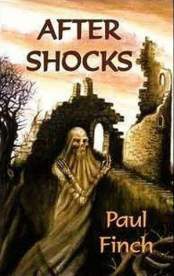 The upshot of all this is that the short story I’ve posted on here today is a reprint. However, it’s an old and venerable one. It’s only seen the light of day once before, and that was in my first collection, AFTER SHOCKS (from Ash-Tree Press), which won the British Fantasy Award for Best Collection in 2002. Several clues as to the story’s age should reveal themselves as the narrative progresses. For that same reason, I’m confident there’ll be a considerable number of people to whom this tale is completely new.
The upshot of all this is that the short story I’ve posted on here today is a reprint. However, it’s an old and venerable one. It’s only seen the light of day once before, and that was in my first collection, AFTER SHOCKS (from Ash-Tree Press), which won the British Fantasy Award for Best Collection in 2002. Several clues as to the story’s age should reveal themselves as the narrative progresses. For that same reason, I’m confident there’ll be a considerable number of people to whom this tale is completely new. It’s called THE FIMBULWINTER, and while I wouldn’t call it a Christmas story per se, it’s set deep in a very dark December indeed, and hopefully can be categorised as one of my scariest stories of the wintertime.
So, we’ll get straight to it this year. I won’t bore you with any lectures about why we love spooky stories at Christmas. There’s an awful lot of stuff on that subject already out there, I’ve noticed; something to do with this grimmest of all years, I suspect. But before we get going, I’ve at least got time to wish you all a very Merry Christmas and, in case we don’t have contact again before 2021, a Happy New Year (certainly a much happier one than many folk had in 2020).
Hope you enjoy the story …
THE FIMBULWINTER
Manning first suspected there was something wrong when snow fell in mid-October.
Had it fluttered down for an hour and melted, he’d probably have forgotten about it by the following morning. But as it came down thick and heavy, smothering the hills of northern England and continuing uninterrupted for day after day, week after week, his misgivings grew. By November, it covered the entire country and what felt like polar winds were blowing. Bonfire Night was unofficially cancelled; a few hardy souls chanced it, but temperatures were six below that day and it was blizzarding again, so scarcely a firework was seen. Come December, the dales around Heatherby, the Yorkshire town where Manning and his two constables ran the sub-divisional police station, were more like the Russian Steppe. The wolds were wind-blasted tundra; rivers and streams had lain frozen for longer than anyone could remember; climbers and walkers were lost on a daily basis. Things were no better in the town itself: there was traffic chaos, pipes and cisterns broke, power lines came down.
The weather people remained cheerful about it. It was the same all over Europe, Asia and North America, they said. Even Africa was having its coldest spell this century. And anyway, Britain was long overdue a hard winter. We’d been spoiled in previous years. The Met Office admitted some surprise at the protracted severity of the weather, but blamed it on a high pressure system sitting stubbornly over Scandinavia and pulling cold air down from the Arctic. Opinions were divided among Greenhouse Effect theorists, some concerned that it discredited their viewpoint, though as one frizzy-haired, jumper-clad professor insisted on a TV chat show, it could also be considered proof positive that things were “going wrong”, many of his colleagues fearful that the first casualty of global warming was always going to be the Gulf Steam, which tended to keep Britain warm and moist during all but the deepest months of the winter.
Sergeant Manning didn’t know much about the Gulf Stream, but he did know that something was “going wrong”. As he guided his police Range Rover up the precarious road to the Mawby Hill estate on the afternoon of December 13, his wheels crunching and sliding in deep snow, he thought about Geraldine’s odd mood that morning. His wife taught at Heatherby Juniors, and had been working with her pupils on Norse myths. Thus, when she’d drawn back the curtains that day on a world yet again blanked-out, she’d spoken about the legendary winter-of-winters, and how it was supposed to herald the destruction of the world. She’d tried to laugh about it, but only in a sombre way.
Manning hadn’t been listening. Instead, he’d grabbed her from behind, kneading her breasts through her nightie, nuzzling her neck, hoping for a spot of nookie before work. But Geraldine hadn’t responded. The same despondency had settled on her recently that had affected so many others over the last few weeks. Her handsome features were morose and drawn; there were dark circles under her eyes. She wasn’t at school that day; the plumbing was down and they were waiting for engineers to arrive from Huddersfield to fix it, but normally she’d still be up and about. On this occasion, she didn’t even get dressed, let alone start the day’s routine of tidying-up and marking.
Manning wished he had time for such fancies. He didn’t say it openly, but civies made him laugh. There hadn’t been a single day in his entire working life when something as mundane as fractured plumbing had sent him home early. And on a day like this, it was a good thing. Harsh weather kept the criminals at bay, but it brought in a rash of other irritations. There were frequent road accidents for example, not to mention regular checks to make on the district’s more remote hamlets.
On top of all that, a fissure had appeared alongside the trunk road leading south to the M62, and another at the bottom of the seventy-foot escarpment at the top of which sat Mawby Hill. They’d been impressive to look at: yawning cracks in the ground, perhaps a metre or so across and in both cases of indefinite length. He wasn’t sure how deep they were, either, but the snow was pouring in and showing no sign of filling them up. Born and raised in the West Yorkshire coalfields, Manning had seen this sort of thing before and it disturbed him. Heatherby had originally been a farming village located at the confluence of several high valleys. However, it had expanded and changed over the centuries to meet the demands of industry and parts of it, especially those residential districts along its southern edge, had been built on uneven coal tips now long disused. As far as he knew, these were safe, heavily compacted, while more recent and therefore looser workings were further down the valley, out of harm’s way. It was just possible though, that the extreme cold had caused some kind of subsidence. Manning wasn’t taking any chances; he’d fenced the cracks off with traffic cones and bright yellow incident tape, just about every inch he had in the station, and was now waiting for word from HQ. Inevitably, in this weather no one was able to do anything in a rush.
Now he had an even weirder job on. Someone on Mawby Hill had reported children frightened by “a very tall man”. As he reached the estate and slowed to a halt at the end of the first street, he wondered just how tall you had to be to frighten the kids of Mawby Hill. Since the pit closure, the estate was almost fully unemployed and what youngsters there were tended to be tearaways.
The road ahead, meanwhile, was bare of life, arrowhead flakes sweeping over it. No-one had gritted, so every surface was deeply buried. Parked cars were visible as rounded hummocks. The Pennine hills, which always made for a scenic backdrop, were indistinguishable from the sky. The few Christmas decorations sparkling from windows had a meagre, half-hearted look about them. Theoretically, white Christmases were adorable, but the weeks and weeks of persistent snow, and the endless problems it caused in a country not geared up to deal with it, were subduing everyone’s mood.
Slowly, Manning gunned the Range Rover forward, the windscreen wipers thudding. Aside from that, there was a muffled silence. He prowled the streets with painstaking slowness, but saw no-one at all, let alone “a very tall man”. He didn’t doubt that something had gone on, however. Even this weather, too cold for children to sit in class, would not be too cold for them to go out snowballing. So, it was hard to explain why they weren’t. He grabbed his radio. “Manning to Six!”
“Go ahead, sarge,” came a tinny voice from the Comms Suite at Slaithwaite.
“Yeah, Jen. I’m on the Mawby now. No trace of anything unusual. No trace of anything, in fact. I’m not happy, though. Think I might knock on a few doors.”
“Received, sarge. Listen ... before you do, can you look at a ‘vulnerable’?”
Manning groaned. Likely as not, this would mean a trip to some even more remote spot. He was glad he had his shovel in the back. “What about 1415, Jen?”
“Negative on that, sarge. I can’t raise Marty.”
“What do you mean you can’t raise him?”
“Not answering his radio, sarge. You know what he’s like.”
Manning snorted. He knew exactly. Marty Culvin was a long serving street-bobby but prone to extreme laziness. Days like this were ideal for parking up somewhere and having a snooze. He’d often turn his radio down so as not to be disturbed by static. “Keep trying him, Jen. And when you get him, tell him he’s in for a bollocking. Let’s have the details.”
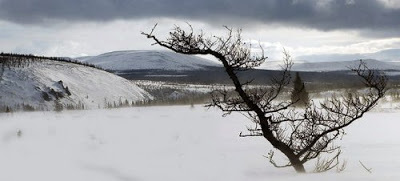
*
Charlie Hardaker had been a gamekeeper during his working life. Now he was retired. Very, very retired.
Manning stood by the broken-down door, staring at the corpse in the middle of the kitchen. He’d been in the job twenty-five years, most of it spent in inner city areas of Bradford and Leeds, and had seen some abominations: a lonely woman who’d died from a heart attack and over the following month had been devoured by her starving Alsatian; a teenage girl raped then macheted, both arms lopped off at the elbows; a motorway crash so severe that one victim’s broken spine had come out through the side of his neck.
But nothing could have prepared him for this.
Thankfully, the snow, which had been billowing in through the open door for the last few hours, covered much of the horror, though Manning could still see enough: the iced blood coating every surface, the indescribable mutilation of the corpse. He took it in at a single glance, before turning away to vomit.
Hardaker, for whatever reason, had gone out through the rear door of his lonely cottage. Whoever he’d met out there had then thrown him back in. Possibly, the wind had closed the door behind the old man, but that hadn’t mattered, because whoever had thrown him in, had thrown him clean through it, bursting it from its hinges and bringing down huge chunks of plaster. It wasn’t clear whether the unimaginably savage beating the victim had taken had come before that or after, but old Charlie’s face was a blackened ruin, the bones smashed inward. Both eyes had ruptured, only blood-glutted sockets remaining. More horrifying than any of this, however, was the actual murder weapon.
It was Charlie’s bottom jaw.
The killer had torn it off and bludgeoned the old man to death with it. It now lay beside him, an angled piece of bone clad in crimson shreds of flesh. Three yellowing teeth were still visible in it.
Manning vomited again before he was able to muster the strength to look around outside the property. The moorland encircling it was a white wilderness, snow whistling across it in spiteful flurries. There was no trace of footprints. Manning doubted that even tracker dogs would make headway in this. He took shelter by the gable wall and tried to contact Comms, but his message broke repeatedly. He plodded back to the Range Rover, now buried to the wheel-arches, and tried to use the force radio. Even that gave out only crackles. From what he could gather, some kind of incident was going on in the neighbouring sub-division. Eventually, he re-entered the house, stepped gingerly past the body and tried to use the telephone in the old man’s hall. Inevitably, it was dead.
He stood there, darkness growing around him. Manning had attended many murder scenes before, and the usual feelings assailed him: revulsion at being there – Hardaker’s house was impeccable, but somehow these dens of death always seemed squalid; anger – the futile yearning for revenge against the faceless murderer was often overpowering; and guilt – no cop in the world could attend a murder without thinking that if he or she had been there earlier it might not have happened, that the helpless victim would not have died unprotected and alone, the law unaware they even existed.
Ordinarily, he couldn’t leave the scene, especially as the broken door meant it was impossible to secure, but this time he had no option. It was vital that CID and Forensics arrived before the evidence deteriorated. He also, laughably, needed to certify death, and that would take a doctor. He glanced around the interior of the house before leaving. Only the kitchen showed signs of physical damage. There was no indication that any other part of the building had even been touched, which suggested that robbery wasn’t the motive. That didn’t surprise Manning; he’d already marked this one as the work of a maniac.
It was only as he climbed back into the Range Rover that he thought about the “very tall man”. It was an ugly notion, but he dismissed it. Mawby Hill was over twelve miles away, which in this weather might as well have been a hundred.
However, by the time he was half way down the rough track to Heatherby, something even more worrying had happened. The swathe of snowy moorland to his left appeared to have fractured. A brand new zig-zag line bisected it in an east-west direction. Manning jammed his brakes on, skidding thirty yards and hitting the kerb before he was able to jump out. He stood gaping. Short of an earthquake, there was surely no explanation for this. He was up in the hills, here. As far as he knew, there’d never been colliery excavation on the northern side of the town.
As far as he knew.
When did that ever mean anything? Who was to say there hadn’t at least been tunnelling? Who was to say the town’s foundations weren’t riddled with galleries now in-filling one after another?
Briefly, he was beset by a nightmarish vision of Heatherby itself, the entire town, subsiding, of horrendous casualties, of a thousand people suddenly rendered homeless in the worst possible weather. He leaped into the Range Rover and set off at a reckless pace, snow spurting out to either side. This was getting way too big for the skeleton staff of a sub-divisional nick. He needed help and he needed it fast.

*
The first thing Manning saw as he approached the police station at the top of Heatherby Market Street, was PC Culvin climbing from the cabin of a farm truck. One or two other vehicles were around, all moving in a reckless hurry it seemed to Manning, but the farm vehicle stood out clearly, as always, caked in mud. It pulled slowly away as Manning drove up. Culvin was walking under the arch towards the personnel door when he glanced back. He stopped and waited. Manning had braked and climbed out before he saw that the PC had been hurt. Culvin’s uniform was dishevelled and the fluorescent green anorak he wore over it streaked with blood. He looked pale and clamped a crimson-blotted handkerchief to the side of his head.
“Have a bump?” Manning asked, keying in the access code.
The PC shook his head groggily. “Can’t remember. Was up on Pit Meadow Lane. Bert Longshaw said someone killed his sheep, battered ’em like. Whole flock.”
“What?”
Culvin shook his head again. They entered the locker room, which was dark and empty, though the central heating had been on full blast for so long that it was stultifying. They stripped off their gloves and anorak. Manning hung his hat on a hook.
“I never got there,” Culvin said. “I was half way up, when I went off the road. Bloody weird, I’ll tell you. One minute I was driving, the next my front wheels’d gone down this hole ... you know, like a crack, but straight across the tarmac. I mean right across it. All jagged.”
Manning felt a twitch at the back of his neck. Bert Longshaw’s farm was four miles east of Heatherby. So … first south, then north, now east. “Go on.”
“Like a landslip, it was. Honest sarge, I’ve been up that road fifty times this year, and I’ve never seen that before.”
Manning nodded. “Course ... if you’d been wearing a belt, it might have been less painful for you.” This was an issue they’d discussed at length several times. Manning had discussed it with many junior officers.
“I was wearing a belt.” Culvin touched the gash on the side of his head, where blood was still seeping. “This happened when I got out. Someone lobbed something at me.”
“Come again?”
“Didn’t see ’em, it was snowing that bad. When I came round, I found a piece of granite the size of a breezeblock. Must have used a bleeding ballista …”
Manning could only stare at him. He was thinking of the strength it took to throw a man through a solid wooden door.
“Good job it only glanced me,” Culvin added. “Good job I had my helmet on an’ all. Bert picked me up about ten minutes later. Reckon I’m going to need stitches and a tetanus.”
Manning nodded, but he was still thinking about Charlie Hardaker. “I can’t let you go for them yet, Marty.”
Culvin stood in amazed silence as his sergeant related what had happened. He might have been a lazy sod, but he was basically a conscientious copper. Five minutes later, he’d popped into the first aid room to get an Elastoplast and some antiseptic, and was then off to the garage at the back to check out the supervision car. He’d stand guard at the Hardaker house until someone relieved him, he said.
“And for Christ’s sake, be careful!” Manning shouted after him from the personnel door. “It’s bad news up there. I’ll be up as soon as I’ve got CID.”
Manning walked down the passage to the office, but heard someone shouting inside it before he even went in. It was Gary Parker, the youngest copper at the nick, and the shift’s front desk clerk and custody officer. When Manning entered, Parker was stripped to his shirt and tie, and trying to raise someone on one of the telephones. He glanced up with what could only be described as immense relief.
“Sarge ... thank God. I’ve been trying to get you. There’s an Operation Response!”
Manning halted mid-stride. “What?”
Parker nodded, his young face pale and bewildered. “Yeah. I don’t know the details ... the line went dead. Something’s going on at Halifax. They need every spare body they can get. A riot, or something.”
“In this weather?”
“I only heard a bit of it.”
Manning struggled to make sense of the situation. “Who were you trying to call?”
“Comms. I can’t get ’em on the radio.” The young officer seemed close to panic. “I don’t know what’s going on!”
“Just keep trying,” Manning said.
Parker did, while Manning picked up a different line and dialled Force HQ at Leeds. There was no response. The number didn’t even ring out. Manning stood back. The control he exercised daily in so smooth and professional a fashion that he barely needed to think about it anymore, was slipping away like water through his fingers. He glanced sideways, to where flakes the size of feathers tumbled past the fogged window. Darkness was falling as well. Another vehicle thundered by at what seemed like suicidal speed, swishing through the snow, headlights glaring. This was wrong ... all wrong.
Manning opened the radio cupboard, took out a new pack of recharged batteries and fitted them into his PR. Changing the frequency, he tried to contact the next division. “Sergeant 1768 Manning, Foxtrot Division to Tango control, over.”
A hiss of static erupted from the receiver, then a voice. It was not the clipped, efficient voice of the average radio-operator however, but a falsetto screech. “Urgent message, repeat, urgent message ... officer injured on ...”
With a crackle, it died away. One of the phones began to ring. Manning turned eagerly, but Parker had already grabbed it. “Hello ... West Yorkshire Police at Heatherby. Yeah ... what ... I’m sorry, love, I didn’t ... what do you mean ... no you’ve got to ... Jesus wept!” He slapped the side of the phone, knocked the receiver against the desktop, then turned to his sergeant. “You’re not going to believe this ... some woman’s just said her husband’s been murdered!”
Manning stared at him.
“Line’s gone dead,” Parker added. “Didn’t even get a name and address.”
Only after what seemed like minutes, did Manning manage to get himself together. “What ... what happened?”
“She was screaming herself hoarse, but it sounded something like the back garden. Someone came over the fence and killed him in the back garden ...”
“And we don’t know where?”
Parker shook his head.
“Dial a recall.”
The PC tried, but again slammed the phone down. “It’s dead! Totally dead. They’ve all gone dead. We’re cut off ... Christ!”
“All right!” Manning snapped. “It’s a blizzard, that’s all! Get it together!”
Parker nodded and tried to calm himself down.
“I’m going up to Charlie Hardaker’s place,” Manning said. “He’s been topped too. Hold the fort, if you think you can manage it.”
He snatched a hi-viz slicker from a row of pegs and left by the front desk; but when he reached the steps, he stopped short. The snowbound town had come alive, vehicles screaming past in both directions, their drivers apparently oblivious to the danger. Some were already showing accident damage. As Manning watched, a Ford Escort went into a horrifying skid and crashed headlong into a lamp post, knocking it backward through a shop window and buckling its own bonnet and fender. Even more astonishing, the Escort driver simply threw the car into reverse, backed up and took off again at high speed, kicking up fountains of slush.
The snow continued to cascade. Where it lay, it was banked against walls in drifts that were maybe six or seven feet deep, but it made no difference: pedestrians were out as well, racing back and forth; some weren’t even wearing coats. The deadened air rang with frantic voices. Manning heard a terrific crash, an explosion of wood and metal. It sounded like a house roof caving in, yet he stood there in a daze, barely noticing as someone approached him. Only at the last second did he turn … just as a solid fist smashed into his jaw.
The next thing he knew, he was lying face-down, his mouth full of hot, metallic fluid.
“Useless pigs!” someone hissed in his ear. A steel-toed boot whumped into his ribs. “Where’s your Orgreave army now when we need it?” The man kicked him again, before lumbering away.
It was several minutes before Manning had come round sufficiently to sit up, ten minutes before he could stand. He suspected his jaw was broken, but knew he didn’t have time to worry about it. He tottered groggily to the Range Rover and climbed inside.
Driving was a nightmare, the blizzard reducing pedestrians to vague phantoms in the murk, obscuring vehicles down to their headlamps. If it was possible, the temperature had dropped even further. The roads were rivers of ice and Manning had several minor collisions before getting out of the town centre. Ordinarily, each one would have meant a written report and probably disciplinary action. Now, he didn’t give them a second thought; he only had one interest, to get up the mountainside.
But it was too late.
He was only halfway to Charlie Hardaker’s house, when he saw the wrecked police vehicle in his headlights. It was lying on its roof, its windows shattered. Black pools of oil were visible around it.
Manning leaped out, torch in hand, and approached. The wind whipped the snowflakes at him like stinging wasps. He ignored it, circling the crashed supervision car. There was no movement from inside, only darkness. Any tell-tale tracks had already been buried.
He halted, peering around, at which point the ground began to shake.
At first, it was a rumble under his feet. He lurched backward, alarmed.
The wrecked shell of the supervision car rattled violently, and from beneath it came another fissure. Initially it was visible only as a deepening groove in the snow, but it made rapid progress, and when the snow fell into it Manning saw a deep, widening split in the road surface. It lengthened speedily, scurrying away towards the Range Rover. He bolted for the vehicle, jumped in and slammed it into reverse …
And a torn-off human head landed on the bonnet.
The first Manning knew there was a thump of metal, and then a waxy white face under a mop of blood-sodden hair was screaming silently through the windscreen. In that first second Manning didn’t recognise it; the eyes had popped out, the mouth gaped wider than was humanly possible. Then he saw the Elastoplast still fastened over the wounded temple.
“Culvin!” Manning shrieked, jamming his foot down.
The head toppled, showing a jagged stump of smoking red meat. A film of blood sprayed over the windscreen, the wipers smearing it in a livid slick. Manning reversed like a madman, the wheels losing their grip repeatedly, the vehicle careering sideways. Still that face of lunacy gaped at him through the crimson fog. Manning looked back through his rear window but saw nothing for the cake of frost. It didn’t matter. He revved harder and harder, the car, borne by its own weight and velocity, turning sideways on the double-glazed surface. Manning fought the wheel, shouting, his lips flecked with froth. He saw himself going over some precipitous edge, turning end on end, beating his cranium to sponge on the roof, engine flames searing his flesh to parchment long before the all-engulfing anaesthesia of death.
But there was no edge. There were no flames. There was only the maelstrom of snow and darkness, the treacherous road of ice, the smashed and laughing face, now pressed against the glass by G-force, imprinting its visage in gore. And something else: the figure pursuing the car down the road. Or rather … the figures.
The Range Rover turned like a top, spinning madly, bouncing kerb to kerb, the world passing it by in a blurry kaleidoscope. But with each revolution, Manning caught flickered glimpses of grey, cyclopean figures bounding down onto the road, pursuing his vehicle like maddened apes, or elephants, or rhinoceroses, or all three merged into some fevered biological blasphemy.
What could throw a man clean through a wooden door?
The ground thundered, or was that the wind, or the constant clash of bodywork on rock and kerb, or Manning’s faltering heart beating a tattoo of terror beyond imagining.
Fleetingly, the empty downward road appeared before him, and he tromped the gas. In his crazed eagerness, he almost overshot, but he righted at the last second, a wall of sparks blazing along the Range Rover’s offside as he blasted down the high verge, hubcaps shearing off like bottle-tops, and then he was moving freely, only the beautiful empty darkness in front. And the crusty gauze of blood, of course. And Culvin’s head, somehow moored to the bonnet, wagging from side to side as though in disapproval. Manning hit his brakes to try and dislodge it, skidding uncontrollably, though at the next bend it flew into the night of its own accord. It couldn’t have done so more impressively had it sprouted bat wings.
 Manning righted the wheel as he precipitated forward. His teeth chattered so savagely that he couldn’t utter a prayer of thanks. He couldn’t even check the mirror to see if those fucking hallucinations were still following him. None of that mattered. Escape was all. Escape from this Roller Coaster road. From this cursed town. From this nightmare. And then he remembered Geraldine. At home all day. On her own.
Manning righted the wheel as he precipitated forward. His teeth chattered so savagely that he couldn’t utter a prayer of thanks. He couldn’t even check the mirror to see if those fucking hallucinations were still following him. None of that mattered. Escape was all. Escape from this Roller Coaster road. From this cursed town. From this nightmare. And then he remembered Geraldine. At home all day. On her own. A moan tore from his lips.
He floored the accelerator with everything he had.
*
The Mannings lived at the end of a cul-de-sac on the southern outskirts of Heatherby. Aside from the various new housing estates being constructed atop the south bank of the M62 motorway, theirs was the last district of habitation. Nothing much happened there. The neighbours liked each other. The children were civil. There was no possible danger. Apart from the fact the entire estate was built on a wide plateau long ago reclaimed from a Coal Board slag heap. Steep slopes fell away on three sides of it.
And now they were literally falling away.
As Manning’s Range Rover skidded down the road towards his front door, he saw a gigantic fissure wriggling across the ice at the far end, saw pavement flags upending in the snow, heard the staccato crackle of rocks and boulders as they snapped like rotten bones. When, with an ear-splitting roar, the farthest house vanished from view, toppling backward into a void, it was four doors from his own.
Manning hit the brakes so hard he almost turned the car on its side. Somewhere ahead, a telephone pole came down, cables lashing and sparking like electric eels. There was another explosion of timber and the next house began to slide, its roof lopsiding, windows bursting outward. Was anyone inside it? Was anyone in the street even? Manning didn’t care so long as he found Geraldine. The road juddered beneath his feet as he ran up his drive to the front door. As it opened, cracks spider-webbed over the lintel.
“Geraldine!” he bellowed.
His wife waited in the lounge, white-faced, eyes glazed. She already wore a coat and had a bag in her hand. The television was on, but the screen was a haze of static. Vague figures moved ponderously about in it, someone was screaming. An American newscaster said something about “international calamity”. Manning didn’t care. He wasn’t listening. He took his wife by the hand and dragged her out of the house. As he did, the floor began to tilt. Boards sprang under the carpet. The burglar alarm went off.
Snowflakes danced into their eyes as they blundered towards the car. As they climbed in, Manning saw a branch-line of the fissure working its way along the centre of the street towards him. He turned the vehicle around and sped away with seconds to spare. In the wing mirror, his house distorted as it fell backward out of view. A split-second later, the fissure widened and with the cacophony of an earthquake, the entire southern side of the cul-de-sac slid away, paving, front gardens, houses, cars, all vanishing.
And then he saw something else. Just before he spun around the next corner, the copper glanced down alongside his vehicle and saw something that he simply refused to believe. Something vaguely humanoid deep down in the cleft, its back braced against one rock face, its massive feet planted on the other, its legs bent double, thighs bulging with granite muscles as it strained and heaved and pushed.
Manning tried to blot it from his mind as he drove for the M62. Everyone else had had the same idea, however. The slip-roads were chocka with vehicles packed with frightened people and travelling at furious speeds. Collisions were frequent, skids a constant hazard. Screams and curses echoed over the yowling engines, but no one stopped to swap addresses or demand restitution. No one dared. Behind them, spread in vast panorama, were the twinkling lights of Heatherby. Many of those lights now winked out, in their place the spreading crimson glare of house and shop fires, massive, lumpy figures moving among them.
“It’s the end of everything,” Geraldine said in shaking monotone.
“Don’t talk wet!” Manning spat, but he had trouble getting the words out. “Just ... just a landslide or something. You know ... an earthquake. Pits ... pits have caved in.”
They sped down the access ramp past the first of the new housing estates, onto the yellow-lit motorway, where true Pandemonium reigned. The M62 was a troubled route at the best of times, but now had to be seen to be believed. The traffic was moving, but it was solid as a log-jam, vans and trucks crammed in with the cars, many running five or six abreast, some on the hard shoulder. An unending dissonance of horns and engines raged through the frozen air. That was the west-bound carriageway. Incredibly, east-bound the lanes were deserted. Though maybe that wasn’t so incredible, Manning thought. Because if you went east on the M62, you also went north, into the teeth of the storm ... and whatever it had brought with it.
He pushed his way out onto the crowded motorway, only to be buffeted repeatedly.
“I don’t know where they’re running to,” Geraldine muttered. “There’s no escape ...”
“For Christ’s sake!”
“It’s the Fimbulwinter. It’s happened like the legend said. And now they’ve come back. To reap the discord and reclaim the world.”
She sounded as if she was quoting something, but Manning was too distracted to wonder what. He swore loudly as they crashed into a car in front and then were jolted from behind. Amazingly, the log-jam continued to move, totalled vehicles dragged along with the rest. “What … what’re you gibbering about?” he shouted.
“What I say,” she said. “Them. The giants.”
Manning wanted to slap her and shout at her, tell her that the last thing he needed now was for his wife to go crazy on him. But he’d already seen things that day that defied explanation. That surely couldn’t exist in the world of law, order and science, where up until this morning he had spent his entire life.
That was when the first missile hit the car.
Initially they thought it another collision. Then the second missile struck, crashing over the bonnet with terrific violence. Geraldine screamed. Manning swore.
A house-brick. A full-sized house-brick flung from the embankment like a tennis ball. Two others hit home in quick succession, sending shockwaves through the chassis. By now, missiles were striking other vehicles too, raining down all along the motorway, smashing on roofs and bonnets. As far as the eye could see, snowflakes billowed in the yellow glare of the street-lights, but showers of a more terrible sort were falling with them. Projected from the embankment.
Only then did it dawn on Manning what was happening.
This was an attack. A full-scale, preplanned attack.
An army had emerged from the tempest and overrun him and his people in their own encampment. Then it had herded them down into this narrow gully where their vast numbers were a disadvantage. That army was now deployed alongside, hidden by the driving snow and thanks to those miles and miles of half-built houses on the new estates, provided with stockpiles of ammunition.
He got his foot down hard, but only succeeded in shunting the Jaguar in front. It scarcely mattered, for one second later the black blur of a twirling brick swooped on the Jaguar’s windscreen, staving it in like paper. The Jag went wildly out of control, skidding sideways and flipping onto its side. Manning swerved around it as it exploded. In his rearview mirror, orange flames mushroomed into the air, but still the missiles came down, thrown with horrendous force by the unseen foe, sleeting into the sea of headlights, shattering windows, gashing bodywork. It was the same directly ahead. Bricks, stones, breeze-blocks, girders even, bounced from the roofs and flanks of the sliding cars. Sparks flashed from repeated impacts. There were further detonations, plumes of flame and smoke. Dams of crumpled metal appeared as vehicles, filled only with the dead and battered, careered into one another, tangling wheels and bumpers, losing speed, slithering upside-down. In many places, people were getting out and trying to run, though swarms of missiles felled them. Either that, or other cars cut them down. Broken bodies flew ragged in the air, or rolled in the gutters between grinding, slewing wheels. The stink of petrol was everywhere, the screams and shouts deafening. Manning screamed along with them. He’d long forgotten that he was a policeman. He forced Geraldine down into the foot-space, then ducked himself as a doorstep-sized chunk of brick and ice came glittering at his windshield. By a miracle, the glass held, though it frosted with cracks. He drove on regardless, hitting and knocking things, keeping as low as he could, cringing with every shuddering blow.
A piece of paving stone skittered across his roof, slamming through the front passenger window of an Audi on his right, crushing the skull of whoever was sitting there, spraying the inside of its windscreen scarlet. Even in his dazed condition, Manning heard a male voice going hysterical, the driver maybe, and the howls of what sounded like children from the back. Then the Audi front-ended the rear of a stationary HGV, and fragmented with the force of its erupting fuel tank.
Manning stomped his pedal to the floor to escape the blast, unable to look at the writhing, blazing figures in his rear-view mirror, only to run aground himself, bullocked sideways by an out-of-control van. Another vehicle hit him, this time from behind, spinning him. A second later the Range Rover was stationary, hemmed between smoking wrecks, the icy air seeping into it. Then the driver’s window imploded, and what felt like a fist in a mailed glove hammered into Manning’s cheek. His head flew to one side, and he heard Geraldine crying out and grabbing at him.
“I’m ... I’m all right,” he stammered, his thoughts swimming. A bloodied half-brick lay in his lap.
“Oh my God, George,” she gasped. “You’re bleeding.”
“I’m all right!” he insisted again, though he knew that he wasn’t. Loose bones ticked in the side of his face. Half of his head had gone numb. Fighting off unconsciousness, he kicked open his door and clambered out. “We’ve got ... got to get out of here.
But in both directions now, the motorway was jammed up with burning, twisted vehicles, many skew-whiff or on their sides. Hapless figures milled among the smouldering hulks, climbing over them, or lying trapped, shrieking for help. Close by, a businessman, still in his pin-striped suit but with a cut forehead and broken glasses, was trying to drag a sports bag from the boot of his Bentley.
“For Christ’s sake!” he shouted hysterically. “It’s my life’s savings ... for Christ’s sake, someone help me!”
His bag was trapped, however. Haul as he may, he couldn’t shift it. He was about to shout again when a brick impacted in his open mouth. It sounded like a hammer hitting a pumpkin. His arms flopped bonelessly as he sank to the ground, his head a pulverised mass of brick and bone. Then a missile struck Manning’s shoulder. He went down with a gasp, falling over a mangled car bonnet. He knew instantly that his shoulder was broken. The pain was nauseating.
Black moments passed before he realised that Geraldine was tugging at him. In a daze, he levered himself up and walked. Like a stumbling, drunken man, he allowed his wife to lead him across the motorway, threading through the debris. Behind them, voices still moaned and wept, the deluge of missiles still beat a thunderous tattoo on chrome and concrete. When they reached the north side of the motorway, the unbroken snow on the embankment was too deep for them to make any headway. It was several feet in places, and as they ploughed into it, simply swallowed them to the waist. Sapped of strength, it became a futile battle. They attempted to struggle up anyway, the slope rearing above them like the south face of Everest. Manning, one side of his body leaden and useless, leaking blood by the pint from his slashed-open face, was the first of the two to collapse. He toppled forward, half-burying himself. Compared to the ice-edged wind, the enveloping snow was warm as a blanket.
Slowly and awkwardly, he rolled onto his back, gradually becoming aware of Geraldine hunched down beside him. Somewhere below, the streetlamps winked off post by post. Darkness spread, only islands of flame holding it at bay. The crashing and banging endured with renewed intensity, for tall shadows were now slinking down from the snows, carrying cudgels. Where the rain of bricks ceased, the slamming of clubs – scaffolding pipes, football goalposts, the stems of traffic lights – commenced.
Manning wasn’t interested. He wasn’t cold any more. He couldn’t even feel his broken shoulder. He sensed Geraldine lying down with her head on his chest, her thin, shivering form coating over with flakes.
“How ... many of them, I wonder?” he stammered. “How many rocks in the earth?” she replied.
If Manning could have nodded, he would. “Better ... this way, then.”
“Better this way,” she said.
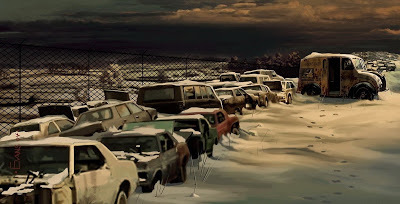
A quick reminder that, if you enjoyed this story today, there are more Christmas and winter-time ghost and horror stories available in my two collections: THE CHRISTMAS YOU DESERVE and IN A DEEP, DARK DECEMBER .
(PS: None of the ARTWORK used in today’s blog was commissioned for this story. All of it I found floating around online with no names attached. If any of the creators want to get in touch with me, I will happily add their credits to this post. Or, if they’d rather, I can always take the images down).
December 6, 2020
Darker crimes to chill you this Christmas
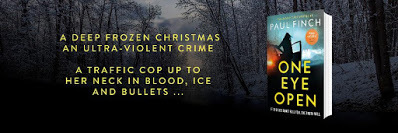
Well, we’re finally into December, so we can at last start talking all things Christmas again. Not that I haven’t been doing this already, I freely admit. But it occurred to me the other day that there is plenty of Christmas stuff to be discussed where my main novel of 2020, ONE EYE OPEN, is concerned (even though it was published during the summer). It’s set over Christmas after all, and packed with midwinter predicaments.
You’ll hopefully recall that it was a hardcase crime thriller, and in keeping with that dark and dangerous tone, I’ll also today be reviewing the rather excellent THE DARK INSIDE by Rod Reynolds, the fictionalisation of a very dramatic real-life murder case, which makes for a superb suspense novel.
If you’re only here for the Rod Reynolds review, I’ve got no problem with that. Just zoom on down to the lower end of today’s post, and you’ll find it, as always, in the Thrillers, Chillers section. If, on the other hand, you’ve got a bit more time, we can first chat a little about …
A Christmas caper
ONE EYE OPEN, my first crime novel for Orion, was published last August, and while the average man on the street might assume this meant it was going to be a summer read (and I wouldn’t argue with that as I consider it a real page-flipper), it is set during a deep-frozen Christmas and so ought to be a damn good read for the festive season too.
 The story itself takes place between mid-December and early January, the centrepiece of it a well-planned but brutal armed robbery, which occurs on Christmas Eve itself. It all happens in the Essex and Suffolk countryside, a part of Britain perhaps not renowned for its plunges into Arctic weather, though this is exactly what occurs on this occasion, and it focusses not on some ace detective or specialist Major Investigation unit, but on a Traffic officer, Lynda Hagen, who, as well as having various lesser enquiries to put to bed, must also look after her demanding family during the Christmas season and take care of her husband, who’s still not fully recovered from a nervous breakdown.
The story itself takes place between mid-December and early January, the centrepiece of it a well-planned but brutal armed robbery, which occurs on Christmas Eve itself. It all happens in the Essex and Suffolk countryside, a part of Britain perhaps not renowned for its plunges into Arctic weather, though this is exactly what occurs on this occasion, and it focusses not on some ace detective or specialist Major Investigation unit, but on a Traffic officer, Lynda Hagen, who, as well as having various lesser enquiries to put to bed, must also look after her demanding family during the Christmas season and take care of her husband, who’s still not fully recovered from a nervous breakdown. The last thing she really needs, of course, is to be dragged into the world of organised crime, multi-million pound heists and gangland shootings.
I’m not going to say any more about ONE EYE OPEN, but will add that, at the time of this writing, it has over 500 glowing reviews on Amazon (but is still there, waiting for more
November 22, 2020
Where lies the future for TERROR TALES?

Today, I’ll be asking the question what does the future hold for my TERROR TALES series? Now, before some smart Alec says ‘you need to ask your publisher, surely?’, I’m talking purely in the aesthetic sense.
Yes, whatever happens with the TERROR TALES series, however long it’s destined to last in its current format, will be entirely down to TELOS PUBLISHING, who’ve done such an amazing job with the last three volumes. The last one in particular, TERROR TALES OF THE HOME COUNTIES, seems to be attracting huge interest online.
But what I’m pondering today is where to go with the substance of the series. Those who follow it will have realised that we are now past halfway in our round-tour of mainland Britain. Okay, we’re not going to complete it in the next year or so. There are still plenty of places to visit here in Blighty. But it will happen eventually, so where do we take TERROR TALES after that?
I have rafts of ideas, but there are lots of issues to talk about.
In addition today, and it’s very in keeping with the main theme, because this is one author whose stories have featured regularly in TERROR TALES, I’ll be reviewing THE BALLET OF DR CALIGARI, Reggie Oliver’s seventh collection of horror stories under the Tartarus Press banner.
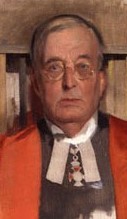 For those who don’t know him, Reggie Oliver has often been referred to as the best kept secret in British horror and as the heir-apparent to both MR James (left) and Robert Aickman ... imagine that combination, if you can. He’s also known worldwide for his endlessly inventive scenarios and for the eloquence of his nightmarish prose.
For those who don’t know him, Reggie Oliver has often been referred to as the best kept secret in British horror and as the heir-apparent to both MR James (left) and Robert Aickman ... imagine that combination, if you can. He’s also known worldwide for his endlessly inventive scenarios and for the eloquence of his nightmarish prose. If you’re only here for that review, you can find it at the bottom of today’s blog, as usual, in the Thrillers, Chillers section.
If that’s your main interest today, shoot on down there straight away. However, those with a little more time on their hands, may also be interested in …
Terror Tales from everywhere
I don’t want to get repetitive on you and go again through the whole story behind my TERROR TALES series (in which we’ve so far published twelve titles). Suffice to say that it was inspired by the Fontana Tales of Terror series of the 1970s, which was mostly helmed by Ron Chetwynd-Hayes, and which selected one specific region per volume and would then tell horror stories about it, snippets of true terror interspersing with great works of fiction, some of these old and well-known, others brand new but commissioned from some of the best authors around.
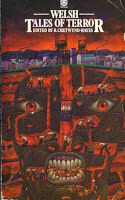 I’ve adopted exactly the same format with the TERROR TALESseries, though whereas Fontana had broader targets:
Welsh Tales of Terror
,
Irish Tales of Terror
,
Scottish Tales of Terror
for example, we’ve narrowed things done a little. Yes, we too have done
TERROR TALES OF WALES
and
CORNWALL
, as Fontana did, but we started with
TERROR TALES OF THE LAKE DISTRICT
, and went on to do
TERROR TALES OF THE COTSWOLDS
,
EAST ANGLIA
,
LONDON
,
YORKSHIRE
etc etc.
I’ve adopted exactly the same format with the TERROR TALESseries, though whereas Fontana had broader targets:
Welsh Tales of Terror
,
Irish Tales of Terror
,
Scottish Tales of Terror
for example, we’ve narrowed things done a little. Yes, we too have done
TERROR TALES OF WALES
and
CORNWALL
, as Fontana did, but we started with
TERROR TALES OF THE LAKE DISTRICT
, and went on to do
TERROR TALES OF THE COTSWOLDS
,
EAST ANGLIA
,
LONDON
,
YORKSHIRE
etc etc. The big question now, having covered roughly half of the mainland UK, is where do we go once we’ve finished with this little island?
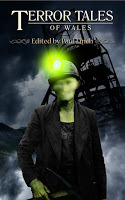 Well, before that, I’d be lying if I didn’t admit that I’ve got firm plans for the immediate future. For example, to compliment
TERROR TALES OF THE SCOTTISH HIGHLANDS
, we simply must, at some point, publish TERROR TALES OF THE SCOTTISH LOWLANDS. Other British districts that we must go to include THE WEST COUNTRY, THE ENGLISH MIDLANDS, and to balance out
TERROR TALES OF NOTHWEST ENGLAND
, there has to be a TERROR TALES OF NORTHEAST ENGLAND.
Well, before that, I’d be lying if I didn’t admit that I’ve got firm plans for the immediate future. For example, to compliment
TERROR TALES OF THE SCOTTISH HIGHLANDS
, we simply must, at some point, publish TERROR TALES OF THE SCOTTISH LOWLANDS. Other British districts that we must go to include THE WEST COUNTRY, THE ENGLISH MIDLANDS, and to balance out
TERROR TALES OF NOTHWEST ENGLAND
, there has to be a TERROR TALES OF NORTHEAST ENGLAND. At the other end of the country, meanwhile, THE SOUTH COAST would also be worth a book.
By the way, the reason behind these relatively small target areas is quite simple. Having extensively researched the folklore and mythology that provides the factual palate-cleansers located between the works of fiction in these anthologies, I’ve uncovered vast amounts of scary material, chilling tales purporting to be true and located in all these different regions of the country. It would have been a crying shame to throw much of it away simply because we were taking too large a scope and therefore couldn’t fit it in.
But still we get back to that nagging question: where do we go when mainland Britain is done?
Terror overseas
I’ve never worked on the basis that the writers who produce fiction for these books need to be ‘ethnically correct’ for the region under examination, but I’ve always been insistent that each story must be relevant to that region. However, once you’ve gone overseas, the ethics of this approach become murkier.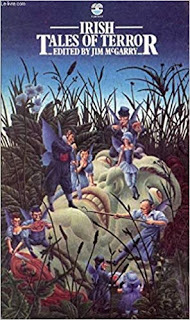 I’d certainly like to do TERROR TALES OF IRELAND (again, as Fontana did back in the day). I pride myself on knowing plenty of Irish writers. On top of that, Britain and Ireland enjoy a close friendship these days, with much cultural exchange. I strongly doubt that anyone would object if there were one or two British (or American authors) in there as well … so it really wouldn’t be a problem putting this one together.
I’d certainly like to do TERROR TALES OF IRELAND (again, as Fontana did back in the day). I pride myself on knowing plenty of Irish writers. On top of that, Britain and Ireland enjoy a close friendship these days, with much cultural exchange. I strongly doubt that anyone would object if there were one or two British (or American authors) in there as well … so it really wouldn’t be a problem putting this one together. But then, when we go further afield into Europe, it might become more of an issue. I have optimistic plans to take the TERROR TALESseries around the European continent, from the MEDITERRANEAN to SCANDINAVIA, from WESTERN EUROPE to EASTERN EUROPE. I reckon those are four potentially delightful books that I wish I could start editing right now. But the problem is that I don’t know many authors from the countries we would cover. In fact, in most cases, none at all.
I’ve no doubt that I could safely commission a whole bunch of superb fictional horror stories set in all of these lands, but they would be by English-speaking authors, and even though said Brits might know these places inside out, would that be the correct thing to do?
I’d genuinely value opinions on this.
Personally, I’d be inclined to say ‘yes it would’ given that the only other alternative would be not doing these books at all.
However, once you’ve cleared that hurdle, and are looking to take the series even further afield, other complexities arise.
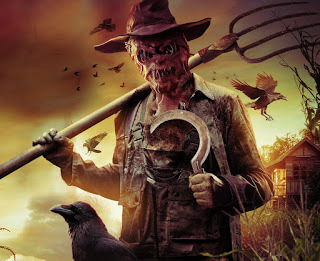 The Americas, you might think, would be the obvious next place for the series to pitch up, North America in particular: it’s primarily English-speaking, plus I know many writers from the US and Canada.
The Americas, you might think, would be the obvious next place for the series to pitch up, North America in particular: it’s primarily English-speaking, plus I know many writers from the US and Canada. What a laugh we’d have with that. Imagine it: TERROR TALES OF THE DEEP SOUTH, TERROR TALES OF THE GREAT PLAINS, TERROR TALES OF NEW YORK, TERROR TALES OF THE WHITE NORTH etc etc etc.
Except that how could I, an Englishman, who has only ever visited the North American continent twice in his entire life, possibly have the temerity to set myself up as editor for an American folklore-based anthology? Surely, it would have to be another American? I mean, don’t get me wrong … I would love to have a go, but I would only attempt this with the tacit permission of the American horror fiction community.
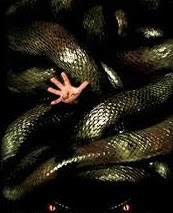 Consider this, and then imagine the even more immense problems if I was to try my hand at editing
Consider this, and then imagine the even more immense problems if I was to try my hand at editing TERROR TALES OF CENTRAL AMERICA or TERROR TALES OF SOUTH AMERICA.
Both those regions have wonderful literary traditions, and again, strong horror-writing communities … but alas, I’d be a total stranger in their eyes (and largely ignorant of their expertise).
The same issues would apply to TERROR TALES OF THE CARIBBEAN, TERROR TALES OF THE MIDDLE EAST or TERROR TALES OF THE FAR EAST. In the latter case, when JJ Strating edited Fontana’s Oriental Tales of Terror back in 1971, at least half the stories were provided by authors of Oriental origin or western writers who were living there. I wouldn’t have the contacts or knowledge to even commence compiling an anthology of that sort.
A better option might be, once we have covered Britain and Europe, to move out of the realm of specifics.
 So, for example, TERROR TALES OF THE TROPICS would sit very nicely alongside TERROR TALES OF THE TUNDRA. I couldn’t see that there’d be much controversy there.
So, for example, TERROR TALES OF THE TROPICS would sit very nicely alongside TERROR TALES OF THE TUNDRA. I couldn’t see that there’d be much controversy there.
TERROR TALES OF OUTER SPACE has to be done at some point, if for no other reason than to honour Fontana’s Tales of Terror from Outer Space (I’ve already done TERROR TALES OF THE OCEAN and TERROR TALES OF THE SEASIDE in tribute to Fontana’s original Sea Tales of Terror ).
Beyond that, we could move onto society itself. How about TERROR TALES OF THE INNER CITY, TERROR TALES OF THE SUBURBS, TERROR TALES OF THE COUNTRYSIDE and TERROR TALES OF THE WILDERNESS …?
We could even start looking at the calendar.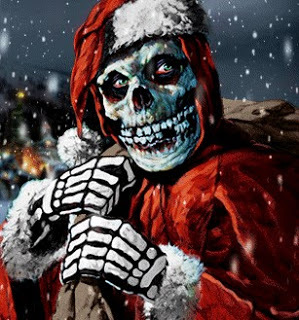 TERROR TALES OF CHRISTMAS would be an obvious one. Likewise, TERROR TALES OF
TERROR TALES OF CHRISTMAS would be an obvious one. Likewise, TERROR TALES OF HALLOWEEN. But what about TERROR TALES OF SPRING, TERROR TALES OF SUMMER, AUTUMN, WINTER … ? I know what you’re thinking. At the rate we produce these books, which is roughly one a year, we’d all be pushing Zimmer frames before we got even half way through a list like this. But should that stop us trying?
Perhaps our final pursuit, after all this, as the series gradually winds its way towards a stately and inevitable end, is horror culture itself.
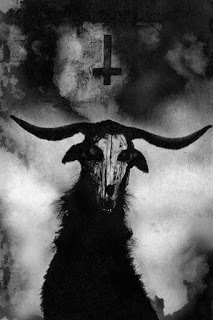 These titles would round it all off nicely: TERROR TALES OF THE OCCULT, TERROR TALES OF THE SUPERNATURAL, TERROR TALES OF MONSTERS, TERROR TALES OF FOLKLORE, and finishing it all off maybe, TERROR TALES OF MANIACS.
These titles would round it all off nicely: TERROR TALES OF THE OCCULT, TERROR TALES OF THE SUPERNATURAL, TERROR TALES OF MONSTERS, TERROR TALES OF FOLKLORE, and finishing it all off maybe, TERROR TALES OF MANIACS. Please forgive me for thinking aloud today. That’s often all I do on this blog, if I’m honest. Though I make no apology for dreaming these dreams.
Maybe we’ve been a little bit ambitious, but if anyone has any better ideas, feel free to let me know. You can rest assured, any that are really good will be freely pinched.
THRILLERS, CHILLERS, SHOCKERS AND KILLERS …
An ongoing series of reviews of dark fiction (crime, thriller, horror and sci-fi) – both old and new – that I have recently read and enjoyed. I’ll endeavour to keep the SPOILERS to a minimum; there will certainly be no given-away denouements or exposed twists-in-the-tail, but by the definition of the word ‘review’, I’m going to be talking about these books in more than just thumbnail detail, extolling the aspects that I particularly enjoyed … so I guess if you’d rather not know anything at all about these pieces of work in advance of reading them yourself, then these particular posts will not be your thing.
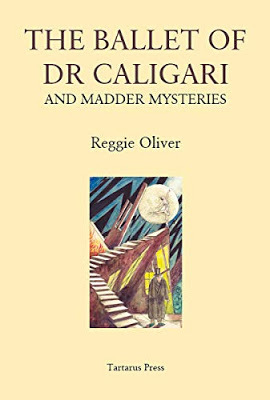 THE BALLET OF DR CALIGARI
THE BALLET OF DR CALIGARI
by Reggie Oliver (2018)
Reggie Oliver is one of the most readable and elegant purveyors of supernatural fiction working today, and yet his reputation in that field continues to elude many out there in the wider world. This is a minor tragedy in my view because, on merit alone, Oliver deserves to be a household name. At least he is well-recognised within the genre itself, a cause served admirably by Tartarus Press, who to date have brought out seven collections of his stories.
The Ballet of Dr Caligari is the most recent on the list, but is something of an oddity in that it incorporates the best of Madder Mysteries, a much earlier Oliver collection, put out in 2009 in fact but which for various reasons was read by almost nobody. The opportunity to get hold of older material that almost sank without trace through no fault of the author gives added value to this particular collection, of course, though there are many more recent stories in here as well, these congregated in the second half of the book, which makes for a most satisfying whole.
When Reggie Oliver first burst onto the ghost story scene in the early 2000s, he was viewed by many as the heir to MR James, his preferred subject the traditional English supernatural tale though with more than a hint of danger in it. Since then, however, and this is excellently illustrated in The Ballet of Dr Caligari, his style has moved more towards the realms of Arthur Machen and Robert Aickman in that he favours strangeness over the straightforwardly ghostly. And yet Oliver’s work is just as frightening now as it ever was, even if he does tend to tackle slightly more complex subject-matter.
Things that have never changed, however, include his eloquent writing style, his scholarly tone, his mordant wit, his effortless evocation of different times and places and his skilled creation of sad, lost characters, all of it coming neatly packaged in deceptively gentle prose.
Another trademark of Oliver’s are his regular trips down memory lane where his own theatrical career was concerned. Oliver was a successful actor, theatre director, playwright and biographer before he moved into a darker literary world, his supernatural canon subsequently making many visits to Britain’s provincial theatre-land of former decades, the majority of these stories steeped in melancholy, though not always because the author is bemoaning the loss of something wonderful. Oliver never skimps on detail when it comes to the tawdriness of some of the experiences he had back then, be it damp dressing rooms, dingy backstage corridors, unpleasant and even predatory fellow professionals, or maybe just second rate accommodation in seaside towns that time forgot.
The Final Stage is a perfect example in this particular collection. It sees an arrogant young actor injured during rehearsal, knocked unconscious and plunged into a theatrical hell of his own making. Another powerful tale of this ilk, less disturbing but dark and foggy nonetheless, is The Vampyre Trap, an atmospheric murder mystery set in Bradford’s Victorian era theatre district, complete with ghosts, arson and multiple deaths by strychnine poisoning. Though by far the most intriguing and yet repellent study of theatre life in times gone by is Baskerville’s Midgets. Read in the age of diversity, it walks the line somewhat, but like many of these stories, it comes to us from another era, when sensibilities were significantly different. I consider this one quite a special piece as low-key horror stories go, so more about this one later.
Reggie Oliver could never really be regarded as an experimental author, but there are three particular stories in The Ballet of Dr Caligari that are fascinatingly off-the-wall compared to his normal output. The first of these, Tawny, you probably would have to classify as experimental fiction, because the story is told entirely in dialogue between characters who are never formally introduced. Such is Oliver’s skill, however, that this never becomes a problem. It concerns an upper class christening, which is interrupted by the arrival of a huge, shaggy animal, which might be a local farm dog gone astray, or something much more sinister.
The two other stories in the trio, while not what I’d regard as experimental, certainly belong in the school of weird fiction rather than the overtly supernatural, though both are deeply macabre. Probably the more lauded of the two, and probably the most Aickmanesque tale in the whole of this collection, if not the most Aickmanesque tale that Oliver has ever written, is A Donkey at the Mysteries, which tells the story of an adventurous undergraduate who makes a one-man tour of Ancient Greek sites, only to arrive on the island of Thrakonisos, where his investigation of the mysterious Sanctuary of the Great Gods invokes an ancient and malignant power. The third story in this small group, The Head, is equally difficult to categorise, but no less unnerving and no less morbidly chilling. In this one, an eccentric art-dealer receives a terminal diagnosis, and so plans to commit suicide with the assistance of an amoral young taxi driver he takes a fancy to, though it won’t be as easy as either of them expects.
Oliver aficionados may consider that more familiar territory is to be found in Love and Death. In this one we’re firmly back in the world of the recognisably supernatural, but it’s a slower burn than usual, and laced with academic interest. It takes place in Victorian London, where it sees Martin Isaacs, an unsuccessful artist, commissioned to recover a missing work of genius, Love and Death, as painted by Basil Hallward, his former mentor, who has now mysteriously disappeared. But the painting, a classical image in the Renaissance style, is misleadingly beautiful. In reality, it destroys all that it touches. A similar tone is struck by Lady With a Rose, in which a young British artist sets up shop in Rome of the 1960s, where he struggles to make a living until he is summoned to the grand home of Prince Valerio Grandoni, who has an unusual and potentially very dangerous commission for him.
Both of these arts-themed tales are intriguing rather than out-and-out frightening, but they hint at extreme darkness and will keep you glued to the page.
Possibly the dreamiest (and perhaps most meaningful) story in the book, and certainly the most folk-horrorish (if such a word exists), is Porson’s Piece, another deceptively gentle fable. It centres on Jane, an Oxford scholar, who seeks an interview with Bernard Wilkes, a former professor of philosophy now in his 80s. She finds him living in a quaint Cotswolds village, but though he’s still an avowed atheist, he now lives in fear of a nearby strip of land called Porson’s Piece, on which the dead are said to dance.
Of course, no Reggie Oliver collection would ever be worthy of the name if it didn’t contain at least a bunch of Gothic horror stories penned with the sole intention of instilling terror in the reader. This, for me, is where the great man really excels, and The Ballet of Dr Caligari is no exception.
First up is The Game of Bear, co-written with MR James himself, though obviously Oliver added his bit long after Dr James had died, the story at that point incomplete.
It centres on Henry Pardue, fortunate heir to a vast country estate, though endless problems are caused for him by his cousin, Caroline, who feels that with her own small inheritance, she has been ill-treated. When Caroline dies, Pardue hopes the matter is over, but it isn’t … as he will learn for himself that following Christmas Day, during the infamous Game of Bear.
Three other tales, owing purely to the imagination of Reggie Oliver, are worthy to stand alongside this one in terms of how genuinely hair-raising they become: The Devil’s Funeral, which I seriously believe is one of the best and eeriest horror stories of modern times, even though it’s set in a distinctly Jamesian past; The Endless Corridor, an uber-Gothic terror tale reminiscent of the great horror writers of earlier eras, Poe, Shelley, Stevenson and so on; and the titular story, The Ballet of Dr Caligari, a phenomenal piece of dark fiction, which though it draws heavily on the original classic tale, is possibly even more crammed with madness and obsession and certainly no less chilling.
I’ve not even hinted at the synopses behind these three final stories simply because I’ll deal with those in the next section. In the meantime, all fans of short eerie fiction should get hold of The Ballet of Dr Caligari. It’s a mixed bag for sure, but the writing is of the highest quality (as are the illustrations, which are provided by the author himself), and it amply demonstrates what a fine and versatile writer Reggie Oliver is.
And now …
THE BALLET OF DR CALIGARI – the movie.
Okay, no film maker has optioned this book yet (as far as I’m aware). So as always, part of this review will involve me non-too-seriously casting this beast before someone with enough development money comes along and does it for real. Here are my thoughts.
Note: these four stories are NOT the ones I necessarily consider to be the best in the book, but these are the four I perceive as most filmic and most right for adaptation in a compendium horror. Of course, no such horror film can happen without a central thread, and this is where you guys, the audience, come in. Just accept that four strangers have been thrown together in unusual circumstances that require them to relate spooky stories.
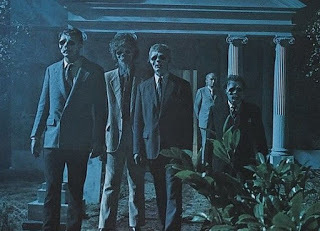 It could be that they are trapped in a cellar by a broken lift and are awaiting rescue (a la Vault of
It could be that they are trapped in a cellar by a broken lift and are awaiting rescue (a la Vault of Horror), or maybe they find themselves in an idyllic country home, where a nervous renovator needs reassurance about his various nightmares (al la Dead of Night).
Without further messing about, here are the stories and the casts I would choose:
(It may look like I’ve spent a fortune on these actors, but remember, for portmanteau horrors they only usually have to work for one day each
November 1, 2020
ILL MET BY DARKNESS - coming your way

I’ve got a little surprise today. Hopefully, readers of this column will consider it a pleasant one. It’s an imminent new publication of mine, which I haven’t mentioned at all until this moment, and which, with any luck, will fit in nicely with everyone’s reading habits as we enter this dark and ghostly time of year. It’s being published by the inexhaustible SAROB PRESS, and is called ILL MET BY DARKNESS. It will only be available as a hardback limited edition and contains four completely new horror novellas of mine, all of which have a distinctly folklorish vibe.
Even if I say so myself, I’ve been busy during this pandemic. Very, very busy in fact. But I’m reasonably optimistic (and praying) that you’ll consider this effort worthwhile.
A bit more about ILL MET BY DARKNESS shortly. In addition today, also on the subject of supernatural horror, I’ll be reviewing and discussing yet another of Michelle Paver’s exceptionally frightening novels of the uncanny, THIN AIR .
If you’re only here for the Michelle Paver review, that’s fine. Just head on down to the bottom of today’s blogpost, where, as usual, you’ll find it in the Thrillers, Killers section. But before we do any of that, here are a couple of items of …
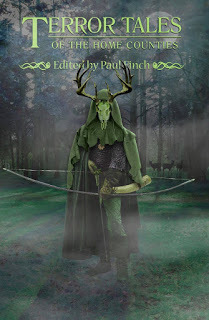 Other news
Other news
Firstly, an update on TERROR TALES OF THE HOME COUNTIES, the latest volume in my Terror Tales series, which you may now be aware is available to order (both electronically and in paperback) either from the publisher, TELOS, or from AMAZON. Watch this space for further info regarding other retailers.
I should also remind you that SPARROWHAWK, my Christmas ghost novella of 2010, which has had a recent makeover, is also available both as an ebook and paperback (again) and is now out on Audible too.
 On top of that, two other collections of my Christmas-themed ghost and horror stories are newly out in paperback and on Kindle. They are
THE CHRISTMAS YOU DESERVE
and
IN A DEEP, DARK DECEMBER
.
On top of that, two other collections of my Christmas-themed ghost and horror stories are newly out in paperback and on Kindle. They are
THE CHRISTMAS YOU DESERVE
and
IN A DEEP, DARK DECEMBER
. And now for today’s big new item of interest …
Ill Met by Darkness
A few months ago, I was approached by Rob Morgan, that fine gentleman at SAROB PRESS, who, if you’re not familiar with them, specialise in publishing collections of supernatural tales, primarily in deluxe, hand-numbered, limited, hardcover editions, and was asked if I’d be interested in writing an all-new collection of folk-horror(ish) fiction; specifically, Sarob were looking at four novellas.
Now, that’s not the kind of offer a writer receives every day. So, even though I was not entirely sure my schedule would permit it, I said yes. That was one of the few good things that happened to me during last summer’s national lockdown, the imposition of which gave me more time to play with than usual, which in its turn enabled me to write ILL MET BY DARKNESS alongside my regular crime novel commitments
I think the thing that really swung it for me was the folk-horror element. For those not in the know (and surely there’s no one left on Earth by now?), folk-horror is a subgenre of horror fiction in which the focus rests on the British ‘old and wyrd’, particularly that half-forgotten world of ancient ritual and arcane belief.
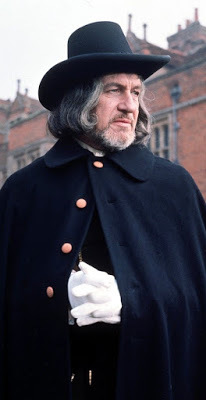 It came to the attention of the wider public in the early 1970s with a famous unholy trinity of British horror movies,
Witchfinder General
(1968),
Blood on Satan’s Claw
(1971) and
The Wicker Man
(1973). With the exception of BOSC director, Piers Haggard, who is alleged to have coined the phrase, it’s unlikely that anyone involved at the time was aware that they were creating folk-horror. Most probably felt they were channelling traditional occult and witchcraft tropes, and weaving them into authentically grimy and realistic British rural backdrops (which was a worthy enough ambition).
It came to the attention of the wider public in the early 1970s with a famous unholy trinity of British horror movies,
Witchfinder General
(1968),
Blood on Satan’s Claw
(1971) and
The Wicker Man
(1973). With the exception of BOSC director, Piers Haggard, who is alleged to have coined the phrase, it’s unlikely that anyone involved at the time was aware that they were creating folk-horror. Most probably felt they were channelling traditional occult and witchcraft tropes, and weaving them into authentically grimy and realistic British rural backdrops (which was a worthy enough ambition). At the risk of sounding ludicrously big-headed, I like to think that I personally carried the folk-horror candle for quite a while after these films were long done and dusted, and well before the subgenre became as widely popular as it is now. Not just because of my own short horror fiction, which has often drawn on British folklore, but through the Terror Tales series I’ve been editing since 2011, an anthology round-trip of the British Isles, each volume attached to one particular region, the stories within (both the fictional and factual) drawing heavily and purposely on the lore and mythology of that region.
Okay, I’m not going to claim that I’m somehow responsible for the resurgence of interest in folk-horror; that would be palpable nonsense. But I’ve long been a fan, and am totally delighted to see it now getting the attention it deserves.
Which brings me back to SAROB PRESS and ILL MET BY DARKNESS. It was not a difficult thing for me to get stuck into. My top drawer has been crammed with folk-horror(ish) ideas for quite a while, and the four that I finally selected I penned in double-quick time, even though, as I say, these are novellas and novelettes rather than short stories. Sarob, I am glad to say, were very happy with them, and the finished result can be ordered right now.
For those who don’t mind their appetites being whetted, here’s a list of the stories included, each one accompanied by a tiny teaser ….
SNICKER-SNACK
One summer evening, Gilpin sets out across London, intending to get his hands on a semi-mythical piece of artwork, a picture once associated with a terrifying monster that no one ever sees and lives. He doesn’t even know if the image really exists, but he is absolutely determined. He will have what he wants, whatever the consequence, no matter how dire …
DOWN TO A SUNLESS SEA
The idyllic island of Crete. Azure seas washing rocky, sun-bleached shores. Inland vistas of vineyards and olive groves. A landscape steeped in myth. Anyone can enjoy themselves here, so long as they don’t delve too deeply behind the party island facade; so long as the distant past is left to rest, and its treasures remain untouched …
THE HELL WAIN
The Forest of Bowland. Lancashire’s best-kept secret. A pristine realm of hilltop, moor and fathomless woodland. When two London gangsters arrive there one Bonfire Night, at the remote village of Hackenthorpe, they have murder in mind. But immediately they’re uneasy. Why is it so quiet? Why is no one around? And yet why do they feel that they aren’t quite alone?
SPIRIT OF THE SEASON
Father Christmas lurks in our consciousness all the year round, not just in December. But his origins are mysterious, enigmatic, almost eerie. When a folklorist sets out to discover the truth behind the jovial myth, it leads him to Wenlock Castle in Oxfordshire, and a Christmas Eve that he and his companions will never forget, assuming they survive it …
THRILLERS, CHILLERS, SHOCKERS AND KILLERS …
An ongoing series of reviews of dark fiction (crime, thriller, horror and sci-fi) – both old and new – that I have recently read and enjoyed. I’ll endeavour to keep the SPOILERS to a minimum; there will certainly be no given-away denouements or exposed twists-in-the-tail, but by the definition of the word ‘review’, I’m going to be talking about these books in more than just thumbnail detail, extolling the aspects that I particularly enjoyed (I’ll outline the plot first, and follow it with my opinions) … so I guess if you’d rather not know anything at all about these pieces of work in advance of reading them yourself, then these particular posts will not be your thing.
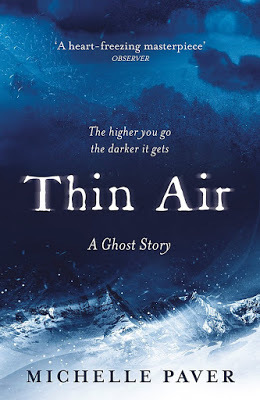 THIN AIR
THIN AIR by Michelle Paver (2013)
OutlineIt’s 1935, the British Empire is still a thing, and the Raj is the jewel in its crown. It’s also the age of men, a time when adventurous chaps with public school backgrounds must all do their bit to enhance their country’s reputation, which often translates into having dangerous escapades in remote overseas locations (usually after leaving their compliant wives and sweethearts behind to worry bravely and quietly on their own).
Perhaps inevitably, mountaineering scores high on this agenda.
On this particular occasion, the object of the exercise is Mount Kangchenjunga in the Himalayas. At 28,169 feet, it’s the third highest mountain in the world, but easily the most difficult climb, and the worst killer of climbers by a long chalk. Even experienced teams are wary of it as so many who have attempted the peak previously have met with disaster.
We follow the story of this latest attempt through the journal-type memoirs of Dr Stephen Pearce, who is very much a part of that fearless set, though a likeable and unassuming man who is privately tormented by self-doubt. Pearce wasn’t originally supposed to be part of this expedition; he was shortly due to marry into a respected and well-connected family, though uncertainty about the future of ‘domestic bliss’ that apparently faced him led him to break things off, which overnight has made him the talk of London society.
Eager to get away from this febrile atmosphere, Pearce, an accomplished mountaineer already – though he’s never tackled anything like Kangchenjunga – eagerly accepts when his older brother, Christopher, or Kits, offers him the role of chief medical officer on the forthcoming trip.
Kits, though outwardly he is all things to all men, has not acted entirely out of generosity. The Pearce brothers have existed in a state of sibling rivalry for many years now, which on occasion has threatened to get out of hand. Kits, who is constantly out for personal glory, is particularly domineering in his manner, and inclined to sulk and shamelessly complain if he ever imagines that his ‘little brother’ (or anyone, in fact) has beaten him to the prize. However, the expedition needs a medic.
Despite this, the mission’s team-leader, Major Cotterell, a World War One veteran, hell-bent on beating the Germans to the summit of Kangchenjunga, is an affable man, who is more than welcoming, even if the others are much more ambivalent.
From the beginning, however, there is an ominous air about the coming trip, which Pearce, who is prone to nightmares, seems to sense more than the others.
He is not at all sure how he feels about Cotterell’s plan to follow the exact same path taken by the Edwardian adventurer, Edmund Lyell, whose 1905 expedition was a catastrophe, five members of his party dying, the remainder all critically injured. And his misgivings about this are in no way allayed when the team finally convenes in Darjeeling, and Pearce inadvertently meets Captain Charles Tennant, the sole crippled survivor of the Lyell ascent, and a man seemingly so deranged by his experiences on Mount Kangchenjunga that his warnings about the dangers facing them, while mostly incoherent, are apocalyptically dire.
Even when the expedition gets under way, the men initially traversing a dreamy landscape of lush rainforest, deep gorges and gliding jade rivers, the coolies are also uneasy about attempting to climb the sacred mountain in the footsteps of Lyell, and this includes Nima, the Sherpa who becomes Pearce’s personal manservant and is easily one of the sturdiest and most reliable men on the expedition.
In due course, the lower valleys fall behind, and the team commences the arduous climb. Even in the foothills there are problems, but Pearce is steadily more oppressed about what lies further ahead. And that isn’t just the sub-zero temperatures and paper-thin air, it is the unmistakeable feeling that something terrible is watching from far above, just waiting for them to stray into its forbidden territory …
Review
Michelle Paver’s Dark Matter, which was published in 2011, was a hypnotically frightening ghost story about an ill-fated expedition to the High Arctic made back during the days of exploration by a well-heeled bunch of chaps looking to make their mark in a world still dominated by Great Britain. Horrors befell them from every side, both of the natural variety, the sort you’d expect during a trip to the ends of the Earth armed with little more than pluck, and of the infinitely more awful supernatural variety.
I was hugely impressed by the tale; not just by how unashamedly scary it was, but by how it captured a unique moment in time: the vast complexities of the undertaking and the personal makeup of those individuals actually taking part, the class system that had created them, the imperialist outlook and so forth. For all these reasons, Dark Matter was a roaring success.
And now Michelle Paver has done it again.
Thin Air may not sound massively different, and it certainly isn’t in terms of its tone. It’s not even especially different in terms of the actual story. But though most of the characters are cut from the same cloth as those in Dark Matter , they are all new, and each one of them, in his own right, is vivid and real. Also, while there are clear similarities between the narratives (I really can’t pretend that there aren’t!), I never felt that I was reading the same thing all over again.Okay, that’s a personal viewpoint, which others have disagreed with, but I can only tell you what I myself thought.
At the forefront of the novel, of course, lies a terrifying ghost story.
It features an arduous journey into an unknown realm, which even the locals are wary of, a place abounding with creatures from both reality, even if semi-mythical, like the snow leopard and the blue sheep, and from mythology, such as the yeti and the mountain spirits that the Sherpa people are so enthralled by. Almost from the beginning, though, there is an aura of impending but unknowable doom. And this doesn’t just stem from Captain Tennant’s demented rantings, alarming though that scene in the book is. So many previous missions have met catastrophe on this mountain that expecting the worst is perhaps the wisest course.
Both Stephen Pearce and his brother knew all about the Lyell expedition from childhood, from reading about it in books and sitting at their aunt’s knee as she regaled them with the story, sparing no lurid detail. And yet Stephen in particular is convinced that they’ve never been given the full terrible facts. Of course, when they finally get up there, the more fanciful legends concerning Kangchenjunga seem a world away for the majority of the party. Initially, it’s just about survival. And yet, still those unspecified concerns that something lurks up here, something malevolent, race through Stephen Pearce’s mind, and through the reader’s.
The tension grows steadily as, in the best fashion of MR James, we think we start to glimpse whatever it is, always just ahead of them, or sometimes behind, or maybe off to the side, but never far away.
It’s certainly the case that fans of classic ghost stories should gobble this one up. It satisfies every requirement of that genre. It’s also impeccably researched. Michelle Paver has visited the Himalayas in real life, but she’s clearly immersed herself in the climbing lore of an earlier age too, because this book really takes you back to the 1930s, and the much rougher and readier methods used to undertake what were genuinely heroic endeavours.
But again, I reiterate, that this isn’t just a ghost story. I don’t want to give much more away but the subtext to Thin Air , as with Dark Matter , is much concerned with the class system of that era and what was a routinely colonialist outlook, a mindset so cast in stone that it even extends into the frozen Hell at the top of Mount Kangchenjunga.
But it’s all done subtly. This isn’t a book about villainous Brits and the poor, put-upon natives. It isn’t even a story about the self-perceived masters of the world proving themselves to be anything but, though it does illustrate, in the most succinct way, how attitudes of superiority can often come with a price … much more of a price than even its hardiest practitioners might be willing to pay. Not that they’ll have much choice.
This brings me onto the characters in Thin Air , at which Michelle Paver yet again excels herself. Even the lesser personalities, McLellan and Garrard, the former a pompous, upper-class Scot, the latter Kits’s eager-to-please ‘yes’ man, while typical examples of the sorts you’d find out there in the Empire in those days, both are clearly and individually drawn.
Again, Michelle Paver does not club her subject-matter here. Cotterell, for example, is a war hero and a true gentleman. Stephen Pearce himself, though very much a product of his time, is a sympathetic figure: the overlooked younger son, the batman to his betters even though he’s a fully qualified doctor (years of derogation by his ‘hero’ older brother have reduced him to this status even in his own eyes). Kits himself, while he’s an archetypical public school brat, a man whose brash over-confidence owes to his having everything he’s ever wanted laid on for him on a plate, does not consider that he’s doing evil. He’s top-dog, and that’s just the way it is; his constant belittling of Stephen is nothing more, in his mind at least, than gentle ribbing.
Thin Air , while it might be a nice metaphor for the unhealthily rarefied atmosphere that certain types of imperialists inhabited back in those days, is not an anti-British polemic. The innate jingoism is presented to us as an everyday thing back then, even the Sherpas, expert mountaineers, accepting their subservient place as part of the natural order. The message that this was all terribly wrong (and highly likely to backfire) seeps through gradually, via the interactions of the characters and the emergence of ghastly revelations.
For all these reasons, Thin Air’s appeal should reach far beyond ghost fiction fandom. But whoever you are, however deep and non-genre you prefer your literature to be, be prepared to be scared. The terror builds slowly but from the very first page, and it doesn’t let up.
And now the fun bit. Or rather, the bit where I embarrass myself by trying to cast this work as if it was about to be translated to film or TV and I had the job of choosing the actors. Here we go:
Stephen Pearce – George MacKay
Christopher ‘Kits’ Pearce – Charlie Hunnam
Major Cotterell – Ralph Ineson
Charles Tennant – David Bradley
Nima – Rajesh Hamal
October 23, 2020
New Christmas terrors now ready to order
 More Christmas goodies are coming your way this week. Okay, I know it’s still only autumn, but as I’ve mentioned a couple of times on here, I’m bringing out two collections of festive-themed horror stories this year, and the sooner the better I reckon, now that the days are shortening, the nights lengthening and the rolling winter fog lurking just off-stage.
More Christmas goodies are coming your way this week. Okay, I know it’s still only autumn, but as I’ve mentioned a couple of times on here, I’m bringing out two collections of festive-themed horror stories this year, and the sooner the better I reckon, now that the days are shortening, the nights lengthening and the rolling winter fog lurking just off-stage.
They are, as I promised you all quite a few weeks ago: THE CHRISTMAS YOU DESERVE and IN A DEEP, DARK DECEMBER.
While we’re talking scary short stories, I’ll also be taking the opportunity today to review and discuss Mariana Enriquez’s quite remarkable debut collection in English, THINGS WE LOST IN THE FIRE.
For any of you Brits who don’t know Argentine author Enriquez’s work – and why would you as, previously, she’s mostly been published in her native Spanish? – this is horror with a conscience. But it’s still horror, trust me.
If you’re only here for the Mariana Enriquez review, that’s fine as always. Scoot on down to the lower end of today’s post, and you’ll find it in the Thrillers, Chillers section. However, if you’re also interested in spooky tales of the Yuletide variety, then stick around here for a bit first, while we get stuck into some …
Seasonal ghosts
First things first. My apologies for hitting you with Christmas stuff when it’s still only October. I know it’s a pain. I, like everyone else, find it bewildering and irritating to see Christmas movies on television when there is still two and a half months to go. But the reality is that if I want people just to know about this stuff, never mind buy it in time to be able to read it, I’ve got to put the info out there well in advance. Contrary to popular belief, bringing Christmas fiction out in Christmas week itself doesn’t really work. In that case, it most likely wouldn’t be looked at until January at the earliest, and let’s be honest, how many of us are ready to deal with anything concerning Christmas in the drab, dreary days following New Year?
 Anyway, back to business.
Anyway, back to business.As already mentioned, the two new titles are: THE CHRISTMAS YOU DESERVE and IN A DEEP, DARK DECEMBER.
Before we look at them individually, I should add that very soon we’ll be bringing both these titles out in Audible as well, read by actor Greg Patmore, who did such a sterling job with last year’s big autumn publication, SEASON OF MIST . All info on that will be posted on here as soon as it’s available.
The first of the two new books is called THE CHRISTMAS YOU DESERVE and it’s a completely new collection, which comprises four stories and a novella. Some are reprints, obviously, but one story, The Tenth Lesson , will be published for the very first time. It is available to order right now, in both Kindle and paperback. Just follow the links. You’ll find a full Table of Contents and a few brief trailers a bit further down.
 The second of the two new books, meanwhile, IN A DEEP, DARK DECEMBER, may sound vaguely familiar. That’s because it was first published as an e-book several years ago. On that front, nothing has changed. The e-book remains as it always was, and is still available to purchase. Just follow the link. The real development with IN A DEEP, DARK DECEMBER is that it’s also, at long last, coming out in paperback. Yes, those of you who don’t have e-readers will be able to give it a whirl too, in your case in the good old-fashioned way by flipping pages while seated comfortably, malt whisky in hand, next to a crackling winter fire.
The second of the two new books, meanwhile, IN A DEEP, DARK DECEMBER, may sound vaguely familiar. That’s because it was first published as an e-book several years ago. On that front, nothing has changed. The e-book remains as it always was, and is still available to purchase. Just follow the link. The real development with IN A DEEP, DARK DECEMBER is that it’s also, at long last, coming out in paperback. Yes, those of you who don’t have e-readers will be able to give it a whirl too, in your case in the good old-fashioned way by flipping pages while seated comfortably, malt whisky in hand, next to a crackling winter fire.Festive treats
Both these titles, THE CHRISTMAS YOU DESERVE and IN A DEEP, DARK DECEMBER, sprang from my lifelong love affair with Christmas ghost stories. Regular followers of this blog will know that I write new ones annually, and often post them on here. But even before the days of the Internet, I was a student of that unique subgenre, and penned seasonal spook tales regularly, many seeing publication in magazines and anthologies on both sides of the Atlantic.
 Of course, I’m not being particularly original in having done this. Both MR James and Charles Dickens got there well ahead of me, and even Shakespeare references the tradition, mentioning in
A Winter’s Tale
the Old English custom of telling ghost stories communally around the roaring flames of the manor house hearth.
Of course, I’m not being particularly original in having done this. Both MR James and Charles Dickens got there well ahead of me, and even Shakespeare references the tradition, mentioning in
A Winter’s Tale
the Old English custom of telling ghost stories communally around the roaring flames of the manor house hearth.I’m not putting myself in that august category, by the way, but I always like to point out that I’m ploughing a time-honoured furrow, so that you hopefully won’t think me too much of an eccentric.
And now, enough gabble. Time for some …
Trailers
THE CHRISTMAS YOU DESERVE is specifically designed to put the chill back into the coldest part of the year. Here is the full list of contents, and some choice snippets:
The Merry Makers The walls were stone, but hung with sumptuous, brightly coloured tapestries. The roof, far overhead, was vaulted, supported by great oaken hammer-beams, and now crisscrossed with swags of evergreen. At the far end towered a colossal Christmas tree, perhaps twenty-five feet tall; I imagined that it had been hewn down in some frosty Norwegian forest and brought over here especially. It reached as high as a stained-glass skylight in a slanted section of ceiling, and was hung with ribbons and ornaments, and glowed with myriad electric lights. Down the centre of the room lay a vast banquet table laid with all kinds of festive delicacies. My eyes skated perplexedly over yet more pies, puddings and pastries, over roasted fowl and baked fish, over dates, sweet meats and fat German sausages. More important than any of this, there were guests. Guests the like of which I had never seen; eight seated one side of the table, eight on the other. Life size effigies, I realised, my blood chilling, lumpen papier-mâché monstrosities clad in gaudy robes. Sinterklass in his bishop’s garb and mitre, a crozier clamped in his gloved, ring-covered hand. Krampus, with his humped back and shaggy goat’s head. Belsnickel, with his bearskin cloak and cap, his Mr Punch features, and his vicious, many-tailed whip …
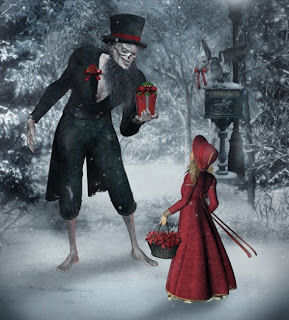 The Unreal
Before sitting and making himself comfortable, Hetherington scrutinised the life-size Scrooge puppet standing up close. Less detail was visible in the night-vision’s green mist. With head drooped, its face was completely indistinguishable aside from its long, tapering nose. In terms of shape, the figure was bone-thin – almost emaciated, like a suspended corpse. The fact it would be hanging just behind and to his left was added unpleasantness. Determined to push such nonsense from his mind, he shoved his chair backward a few feet, so that at least it hung in his eye-line. Then he settled down. The chair, which was hard and stiff-backed, was uncomfortable, but that was good – the last thing he wanted was to drop off to sleep. Murmuring these thoughts to his viewers, he appraised the auditorium as it stood empty in front of him. Night-vision wasn’t perfect; but at least he could distinguish its basic dimensions; the rows of seating, and the two downstairs aisles. It was only when he glanced up to the balcony that he glimpsed what he thought was a person. Hetherington blinked once, twice – then stood up and walked to the front of the stage. He had to be mistaken. Perhaps the fogginess of his vision was playing tricks on him? But it definitely looked as if someone was sitting in one of the seats up there. In the extreme right-hand block, three rows up from the front barrier. “Hello?” he called hesitantly. “Mr Lampwick?” But it surely couldn’t be Lampwick. He’d left, and the whole place was locked up. And there was nobody else here, or there wasn’t supposed to be. The shape on the balcony didn’t respond, or even move, but the more Hetherington stared up at it, the more it resembled a seated figure, possibly wearing a heavy overcoat. “Hello!” he shouted again, more belligerently, his voice echoing to the high ceiling. Still the figure sat motionless …
The Unreal
Before sitting and making himself comfortable, Hetherington scrutinised the life-size Scrooge puppet standing up close. Less detail was visible in the night-vision’s green mist. With head drooped, its face was completely indistinguishable aside from its long, tapering nose. In terms of shape, the figure was bone-thin – almost emaciated, like a suspended corpse. The fact it would be hanging just behind and to his left was added unpleasantness. Determined to push such nonsense from his mind, he shoved his chair backward a few feet, so that at least it hung in his eye-line. Then he settled down. The chair, which was hard and stiff-backed, was uncomfortable, but that was good – the last thing he wanted was to drop off to sleep. Murmuring these thoughts to his viewers, he appraised the auditorium as it stood empty in front of him. Night-vision wasn’t perfect; but at least he could distinguish its basic dimensions; the rows of seating, and the two downstairs aisles. It was only when he glanced up to the balcony that he glimpsed what he thought was a person. Hetherington blinked once, twice – then stood up and walked to the front of the stage. He had to be mistaken. Perhaps the fogginess of his vision was playing tricks on him? But it definitely looked as if someone was sitting in one of the seats up there. In the extreme right-hand block, three rows up from the front barrier. “Hello?” he called hesitantly. “Mr Lampwick?” But it surely couldn’t be Lampwick. He’d left, and the whole place was locked up. And there was nobody else here, or there wasn’t supposed to be. The shape on the balcony didn’t respond, or even move, but the more Hetherington stared up at it, the more it resembled a seated figure, possibly wearing a heavy overcoat. “Hello!” he shouted again, more belligerently, his voice echoing to the high ceiling. Still the figure sat motionless …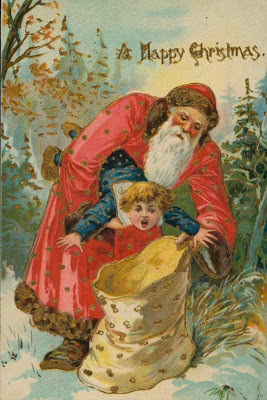 Krampus
I yanked off my balaclava, my hair soaked with icy sweat – and heard a distinctive clank as the front gate banged open again. Incredulously, I listened to the progression of heavy misshapen feet along our snowy front path, and then into the alley beside the house, whereupon they abruptly stopped. I was now listening so intently that I fancied I could hear the whispering of the snowflakes outside, but apart from that there was only silence. Torturous, prolonged silence. It is almost impossible to convey the horror and isolation I felt at that moment, even though I was ensconced in my own home. I stared fixedly at the kitchen door. For a time, there was nothing else in the world but that door – and what I suspected lurked just beyond it. I was unable to move; I didn’t dare move, terrified that if my feet scuffed on the floor they would alert the thing to my presence, even though such thoughts were patently ludicrous – it had followed me all the way home. Even if it hadn’t, it knew where I lived; according to our myths, it knew where every child lived. There was a soft crunch of snow, this directly on the other side of the door, and then a further pause. Was it listening in through the planks as I was listening out? We had a telephone – I don’t know why it never occurred to me to run and dial 999. I suspect I was simply too mesmerised by events. My nerves were taut as cello strings, my hair standing on end. But I quickly broke from this stupor when the door-handle started to turn …
Krampus
I yanked off my balaclava, my hair soaked with icy sweat – and heard a distinctive clank as the front gate banged open again. Incredulously, I listened to the progression of heavy misshapen feet along our snowy front path, and then into the alley beside the house, whereupon they abruptly stopped. I was now listening so intently that I fancied I could hear the whispering of the snowflakes outside, but apart from that there was only silence. Torturous, prolonged silence. It is almost impossible to convey the horror and isolation I felt at that moment, even though I was ensconced in my own home. I stared fixedly at the kitchen door. For a time, there was nothing else in the world but that door – and what I suspected lurked just beyond it. I was unable to move; I didn’t dare move, terrified that if my feet scuffed on the floor they would alert the thing to my presence, even though such thoughts were patently ludicrous – it had followed me all the way home. Even if it hadn’t, it knew where I lived; according to our myths, it knew where every child lived. There was a soft crunch of snow, this directly on the other side of the door, and then a further pause. Was it listening in through the planks as I was listening out? We had a telephone – I don’t know why it never occurred to me to run and dial 999. I suspect I was simply too mesmerised by events. My nerves were taut as cello strings, my hair standing on end. But I quickly broke from this stupor when the door-handle started to turn … The Tenth Lesson
Tregarron came to an abrupt halt at the top, eyes scanning the darkened passage ahead, along which several bedroom doors stood open, each one shedding even darker darkness. “I’m warning you,” he shouted, hefting the poker. “Don’t make the mistake of thinking that just because I write children’s books, I’m some kind of sissy.” There was no response. He advanced a few yards, eyeing the carpet. But if there’d been any snow left on the intruder’s boots by the time he’d arrived up here, there was no trace of it now. “Look, if this is just a joke … if you work for someone who thinks he’s found something out about my real attitude to Christmas, maybe I can live with that. Maybe there won’t be any need for rough stuff. But you’ve got to step out where I can see you.” In direct response to this, he heard a sudden whirring and clicking, as if gears and wheels had gone into motion, and a steady repeated creak: the sound of timber under pressure. And then it appeared, at the far end of the passage, from a bedroom on the right. The soldier. Initially he saw it only in profile. Until it swung about to face him. Tregarron insisted to himself again that it was someone inside a suit. And yet the inflexibility of its painted grinning face, the jerkiness of its movements, the ramrod stiffness of its posture made this seem incredibly unlikely. Abruptly, the soldier went on en garde, tilting sharply forward, musket levelled at waist-height. To Tregarron’s even greater incredulity, he now saw a glint of steel at the weapon’s tip …
The Tenth Lesson
Tregarron came to an abrupt halt at the top, eyes scanning the darkened passage ahead, along which several bedroom doors stood open, each one shedding even darker darkness. “I’m warning you,” he shouted, hefting the poker. “Don’t make the mistake of thinking that just because I write children’s books, I’m some kind of sissy.” There was no response. He advanced a few yards, eyeing the carpet. But if there’d been any snow left on the intruder’s boots by the time he’d arrived up here, there was no trace of it now. “Look, if this is just a joke … if you work for someone who thinks he’s found something out about my real attitude to Christmas, maybe I can live with that. Maybe there won’t be any need for rough stuff. But you’ve got to step out where I can see you.” In direct response to this, he heard a sudden whirring and clicking, as if gears and wheels had gone into motion, and a steady repeated creak: the sound of timber under pressure. And then it appeared, at the far end of the passage, from a bedroom on the right. The soldier. Initially he saw it only in profile. Until it swung about to face him. Tregarron insisted to himself again that it was someone inside a suit. And yet the inflexibility of its painted grinning face, the jerkiness of its movements, the ramrod stiffness of its posture made this seem incredibly unlikely. Abruptly, the soldier went on en garde, tilting sharply forward, musket levelled at waist-height. To Tregarron’s even greater incredulity, he now saw a glint of steel at the weapon’s tip …The Stain The observatory was accessible by a narrow, winding stairway, which during daytime would be bathed in sunshine from an overhead skylight, but at night was a black spiral. Nevertheless, they proceeded up it, silent and bunched together. At the top, the doorway to the observatory stood wide open. Frosted moonlight filled the spacious room beyond it from the overhead dome. At this ungodly hour it didn’t reveal a great deal, though one thing was quite clear: the observatory had been trashed. Broken ornaments lay scattered on the carpet. Every item of furniture, even the heavy four-posted bed, had been overturned. At last, Wilkes found the light switch and turned it on, which brought additional macabre detail to their attention. Previously plump upholstery had been slashed and gutted. There were daubings on the walls in some vile black substance: to Rick they resembled the runic symbols from Night Of The Demon, though they were so crude and unclear they could also have been attempted recreations of the devil-figures painted on the floor for Wilkes’ original Black Mass scene. More worrying than any of this, though, were the shapes laid out in the centre of the room. These had been formed from folded bedsheets. The sheets themselves were pristine, not damaged in any way. But it was the shapes they made that were so significant. They were human coffins. And there were seven of them: one for each person present …
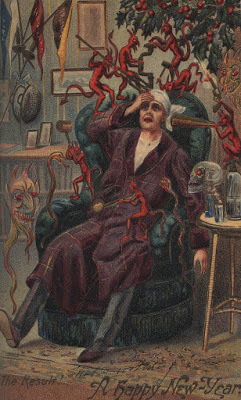 IN A DEEP, DARK DECEMBER is published in paperback for the first time today, (but as previously mentioned, has already been available for some time in ebook form). Here are some short whistle-wetters:
IN A DEEP, DARK DECEMBER is published in paperback for the first time today, (but as previously mentioned, has already been available for some time in ebook form). Here are some short whistle-wetters:The Christmas Toys In the very centre, on a raised mound, there was a stable, its front section removed, revealing a baby in a manger and toy soldier-sized figures of Mary and Joseph kneeling one to either side. Above them, a single star was suspended. Somewhere on the floor one of the wires to the fallen Christmas trees sparked, and the star began to shine with a pale, silvery luminescence. At the same time figures started moving in the town. Tookey watched in fascination as three or four men, again no more than toy soldier size but distinctly sinister in hoods and cloaks, and with curved daggers, roved up and down the narrow streets, moving along electric runners that he hadn’t noticed previously. One by one they visited each house, the internal light to which would then turn blood-red – to the accompaniment of tinny shrieks. “What the …?” Tookey breathed. He had some vague memory of a school lesson during which he’d been told about that bad-tempered bastard – wasn’t his name ‘Herod’? – having all the babies killed to try and get to Jesus. But Christ, you didn’t put something like that in a Christmas decoration!
Midnight Service “Can I help?” came a voice from behind. Capstick spun around. A tall, lean figure in a gray suit and clerical collar, with a pale face and short sandy hair, had entered the hall behind him. “Oh, I’m sorry …” Capstick stammered, not sure whether to address the man as ‘Father’ or ‘Reverend’. “But, well, this may sound a bit ridiculous …” “Gentleman of the road, are you?” “What?” Capstick was startled. Surely he didn’t look that bad? He brushed self-consciously at his beard. “Erm … no, though I will admit to being lost.” “So many do at this festive time of year.” As the vicar wove his way forward through the seats, Capstick saw that he was actually quite old, his face wrinkled with a yellowish tinge, his eyes rheumy. His hair, which was colourless, was extraordinarily thin; it looked sandy from a distance because he’d greased the few lank strands of it that remained backward over his liver-spotted scalp. His suit, once smart, was dusty and crumpled. “I’m stuck in town by accident,” Capstick added, slightly distracted by this. “Trying to find some … well, first of all, some accommodation. And secondly, some transport out of here.” “The first of those we can help you with ... of course we can.” The vicar smiled, his bloodless lips drawn back on brownish pegs, and laced his fingers together. “The second, alas, no.”
The Faerie “It’s a grand-looking place,” Arthur said. “Can’t think what it’s doing all the way out here in the wilds of Derbyshire.” He reached for the knocker, but the door creaked open as soon as he touched it. They glanced through, and saw an arched stone passage with low wooden beams across its ceiling. It ended at a flight of four broad steps, which led up into a living area. A rosy flush of firelight was visible up there, and a pleasant scent struck their nostrils, a combination of oranges and cinnamon, and something else: evergreens. The reason for that soon became obvious. The beams in the entrance hall had been decked for Christmas: alternating strands of ivy and holly had been woven around them. The only sound was a distant crackle of flames.
 To Arthur it was extremely welcoming, but Gabby had different ideas. Oddly, she began to tug on his arm, trying to draw him away. “We should go, Daddy. We should go right now.” He glanced down at her, puzzled. “What’re you talking about?” “I bet it’s the furry house,” she said. “What?” “It was in that book you got me. It said that out on the moors, when people are lost, the furry house comes and the people go inside and think they’re safe. And the furry house disappears, and they go with it. And they’re never seen again.” Arthur chuckled and tapped on the door-jamb with his knuckles. “Darling, this isn’t a fairy house. Look, it’s as solid as you and me.” “That doesn’t mean anything. They have to look real to trap people.”
To Arthur it was extremely welcoming, but Gabby had different ideas. Oddly, she began to tug on his arm, trying to draw him away. “We should go, Daddy. We should go right now.” He glanced down at her, puzzled. “What’re you talking about?” “I bet it’s the furry house,” she said. “What?” “It was in that book you got me. It said that out on the moors, when people are lost, the furry house comes and the people go inside and think they’re safe. And the furry house disappears, and they go with it. And they’re never seen again.” Arthur chuckled and tapped on the door-jamb with his knuckles. “Darling, this isn’t a fairy house. Look, it’s as solid as you and me.” “That doesn’t mean anything. They have to look real to trap people.”The Mummers It was Eric Hazelwood who’d first told Phil about the mummers of Holker Hall. This had been several years before, in the halcyon days when the Mercury had been the plain old Mercury. At the time, they were discussing a possible centrespread on local ghosts. Eric had long been a student of the supernatural, but he wasn’t keen on using the Holker Hall mystery. After all, this wasn’t some spectral pussy cat with a cute purr, or a thirsty pub ghost who drew himself generous measures after hours and in so doing helped drum up custom. There was little to snigger at in this tale, and those members of the Bradleigh public who knew about it responded accordingly. The myth wasn’t known widely enough for the hall to be shunned; the Groves still played host to adventurous children and picnicking families, especially in summer, while the ornate old building was a source of architectural interest, but that was about it. Few went near the place at night, and none on Christmas Eve. These spooks didn’t just scare you; they signed your death warrant. It was only a story of course, but why take the chance? Phil still wasn’t sure if he believed it, though now, as eight o’clock came and went, then nine and finally ten, he was increasingly distracted from the drunken frolics in the banquet lounge to the opaque winter darkness outside. He could well imagine the miles and miles of frozen, unlit woodland lying between himself and civilisation. Once or twice, he thought vague forms were cavorting out there, though that was unlikely. It was way too early yet; the mummers were only supposed to emerge from the Groves at midnight. Of course, no-one could say for sure, because allegedly no-one had lived to tell …
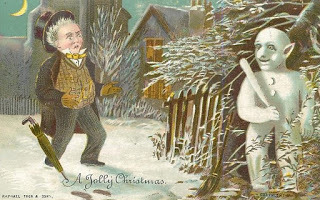 The Killing Ground
And then the moon slipped out again, and thirty yards to his right he saw a ruined building. When he ventured towards it, he did so slowly. It sat on top of a small hillock and was maybe fifteen feet tall at its apex. It was built from pale stone, but as Alec got closer and saw veins and greenish stains all over it, he realised that this was marble. The building was a folly, or at least that was the impression it gave. It was octagonal in shape, but in each section of wall there was an open entranceway, all equidistant from each other, all upright and perfectly rectangular. He ascended the hill and when he reached the building, halted warily. The entrance directly in front of him seemed more like a doorway than the others, which perhaps were merely windows. This one had a lintel, and above that an engraving: a triangle with some kind of astrological symbol in the middle, possibly the Eye of Horus, though it was difficult to tell. Definitely a folly though. Alec poked his head inside and sniffed. Compared to the fresh tang of the snowy wood this place smelled damp, mildewed. He hesitated before entering, but the other seven apertures allowed in sufficient moonlight to show that the place was empty, even derelict, so he proceeded. He saw that each one of the other entrances, or windows, had a stump of broken, eroded stonework set into its base. The remnants of statues, he realised, though now that his eyes were attuning to the dimness, he spotted that one of them remained intact. It occupied an aperture on the north side, but though human in outline and roughly Alec’s height, none of its features were visible because it was covered with ivy …
The Killing Ground
And then the moon slipped out again, and thirty yards to his right he saw a ruined building. When he ventured towards it, he did so slowly. It sat on top of a small hillock and was maybe fifteen feet tall at its apex. It was built from pale stone, but as Alec got closer and saw veins and greenish stains all over it, he realised that this was marble. The building was a folly, or at least that was the impression it gave. It was octagonal in shape, but in each section of wall there was an open entranceway, all equidistant from each other, all upright and perfectly rectangular. He ascended the hill and when he reached the building, halted warily. The entrance directly in front of him seemed more like a doorway than the others, which perhaps were merely windows. This one had a lintel, and above that an engraving: a triangle with some kind of astrological symbol in the middle, possibly the Eye of Horus, though it was difficult to tell. Definitely a folly though. Alec poked his head inside and sniffed. Compared to the fresh tang of the snowy wood this place smelled damp, mildewed. He hesitated before entering, but the other seven apertures allowed in sufficient moonlight to show that the place was empty, even derelict, so he proceeded. He saw that each one of the other entrances, or windows, had a stump of broken, eroded stonework set into its base. The remnants of statues, he realised, though now that his eyes were attuning to the dimness, he spotted that one of them remained intact. It occupied an aperture on the north side, but though human in outline and roughly Alec’s height, none of its features were visible because it was covered with ivy …
Apologies by the way for the title of the first book, THE CHRISTMAS YOU DESERVE . Whatever happens at the end of this year, it certainly won’t be the Christmas any of you deserve after the difficulties you’ve had to put up with during 2020. But don’t read too much into that. Here’s hoping you enjoy these festive forays into the world of sprites, ghouls and winter demons. It’s just a bit of fun, a diversion for the holiday, but one that, with luck, will also leave you so discombobulated that phrases like ‘spirit of the season’ will never mean the same thing again.
(By the way, you’ll probably have realised by now that many of the festive horror images I’ve stuck in here and there have no actual connection to either of the two books, but are generic representations of Christmas nastiness. I located them amid a bunch of images depicting scary Victorian Christmas cards, so theoretically there shouldn’t be any copyright issues. But if there are, the owners need only to let me know and I will happily give credits or take down straight away if that is required).
***
THRILLERS, CHILLERS, SHOCKERS AND KILLERS …
An ongoing series of reviews of dark fiction (crime, thriller, horror and sci-fi) – both old and new – that I have recently read and enjoyed. I’ll endeavour to keep the SPOILERS to a minimum; there will certainly be no given-away denouements or exposed twists-in-the-tail, but by the definition of the word ‘review’, I’m going to be talking about these books in more than just thumbnail detail, extolling the aspects that I particularly enjoyed … so I guess if you’d rather not know anything at all about these pieces of work in advance of reading them yourself, then these particular posts will not be your thing.
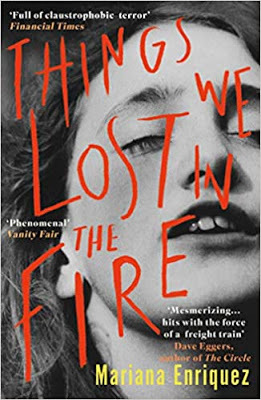 THINGS WE LOST IN THE FIRE
by Mariana Enriquez (2016)
THINGS WE LOST IN THE FIRE
by Mariana Enriquez (2016)
As a writer, journalist and respected social commentator, Mariana Enriquez is widely published in her home country of Argentina, but this is the first English translation of one of her books, and it’s to the immense good fortune of all genre fans that it’s a collection of horror stories cut from some of the darkest cloth imaginable.
Before we get into it, here’s the publisher’s own official blurb:
Twelve stories of ghosts, demons and wild women; of sharp-toothed children and stolen skulls. In this sleep-stealing collection, Enriquez transports the reader to the crime-ridden streets of post-dictatorship Buenos Aires, where exhausted fathers conjure up child-killers, and young women, tired of suffering in silence, decide there’s nothing left to do but set themselves on fire.
The first thing I really noticed about this in-your-face collection of succinctly-written but hugely effective horror stories, as translated (crisply and beautifully, I have to say) by Megan McDowell, was the complexity of ways in which the horror comes to us. Even though this is a strange, dark world filled with surreal twists and endless visitations by the supernatural, it’s also a circus of real-life urban horrors.
All the way through the book, in one form or another, Mariana Enriquez soliluquizes on the deep scars her country has suffered in recent history, not just during the days of the military junta, but throughout the cash-strapped aftermath that followed. So, while we have demons and spectres, we also have feminicide and malnourished children. The bizarrely grotesque, goblins and devils, jockey for attention alongside more commonplace killers, maniacs and torturers. It’s a place where the villainies of the undead and the evils of injustice are evenly matched, where haunted houses stand amid the appalling squalour of slum neighbourhoods, meaning there is no refuge either inside of them or out.
One of the most obvious shadows that lies over Mariana Enriquez’s world is that of the well documented ‘Dirty War’, the period of repression suffered by her countrymen between 1976 and 1983, when the ruling military power imposed state terrorism on its own people, thousands who were considered a political or ideological threat kidnapped and murdered, and countless others imprisoned without trial or driven into lifelong exile.
Simply writing about this period as it happened, providing an eye-witness account of the many brutalities, would be one way to respond. But Mariana Enriquez, who was a child through most of this period, has instead chosen a more subtle approach, portraying the darkness through the prism of ghost stories and Gothic horror.
The Inn is an excellent example. In this elegant tale, schoolgirl Florencia doesn’t much care for her family’s summer home in the country, though when she’s there, she does enjoy the company of village girl, Rocio, who, in her turn, despises Elena, owner of the village hotel, ‘The Inn’. One year, when the place is empty of guests, the two girls force entry, looking to cause mischief, neither paying any attention to the fact that the fine old building was once a police training school, or that during the dictatorship, people were tortured and murdered there. You won’t need to be a student of supernatural fiction to deduce what is going to happen next, though it’s still very delicately done.
Even more subtle, is Spiderweb , in which a young woman, her objectionable husband and her beautiful cousin enjoy the country’s new-found freedoms by taking a road-trip to the border, briefly crossing over from Argentina into Paraguay, which is still a police state under the iron control of Alfredo Stroessner. Here, they are menaced by drunken soldiers, but worse is to come on the way back, when they stop at a run-down wayside hotel, for there is much that is strange on the borderland between one world and the next …
Of course, it isn’t just the dictatorship itself that haunts these pages. Following the junta’s downfall, the country entered a period of democracy, which still exists today, but happiness didn’t immediately follow as the Argentine people were dogged by corruption, hyperinflation and economic instability, and a subsequent proliferation of drugs and crime, particularly in the major urban centres.
None of the stories in Things We Lost in the Fire better illustrate this new darkness than Under the Black Water , which again examines its subject through the lens of traditional horror, even adding a Lovecraftian vibe in this instance (in fact, this is probably the most ‘horror’ of all the horror stories in this collection, so more about this one later).
The social commentary continues with The Dirty Kid , in which a middle-class woman insists on staying in her family home in Constitucion, Buenos Aires, even though the area has now gone to seed. She worries endlessly about the dirty homeless boy across the street, especially when there is a child murder in the district, the victim mutilated in a ghastly Satanic ritual.
This is typical of many of Mariana Enriquez’s tales, which are strictly adult-reading but in which the youthfulness of the protagonists is a highly worrying factor. Many are female, but at least an equal number are also children, and their vulnerability in the face of unknowable and uncontrollable forces is skin-crawling, especially in a society so deeply damaged by events that occurred before most of them were even born.
In The Intoxicated Years , a trio of rebel girls from poor backgrounds grow up drinking and taking drugs at every opportunity. They are impressed one night when they see what they believe is a ghost girl in a local park, even though for a ghost she was giving off a distinct aura of evil. When one of them finds the ghost’s ribbon, the evil starts to infect them too. A similar note of darkness and despair is struck by End of Term , the focus of which is schoolgirl who continually self-harms until she is forced to leave school. All the way through, she insists that she isn’t ill and that a man who no one else can see is instructing her to do it. She also says that this man is now taking a clear interest in her best friend …
But this disturbing combo of social blight and innocence marred is never more searingly told than in the title story, Things We Lost in the Fire , which is really one of the most horrible tales I’ve ever read, uber-dark in tone and concept, but undeniably, astonishingly effective (more details about this one later).
I don’t wish to give the wrong impression, though. While many of these stories are ‘activist’ tales, the author using fiction as the tool by which she examines and criticises her malfunctioning world, the fantasy-horror is nearly always there. Readers purely looking for a good old-fashioned scare will not go wrong with this one.
Adela’s House and The Neighbour’s Courtyard are deeply chilling ghost stories in their own right; I’d go as far as to say that the former is actually terrifying, probably the most frightening story in the book (much more about these two later). But it doesn’t stop there. In Green Red Orange , Enriquez swoops through the ‘slipstream’ school with the psychological terror tale of manic depressive Marco, who locks himself into his bedroom, from then on living only through the Internet, where he is so captivated by the sordid secrets of the Deep Web that even his ex-girlfriend can’t get through to him …
More traditional but no less alarming (so much so on both scores that this one could easily date back to the nastiest days of the Pan Horror series) is the mock-amusingly titled Invocation of the Big-Eared Runt , in which a Buenos Aires murder tour guide, increasingly frustrated by his wife’s fawning over their new child while he himself is ignored, cheerfully informs tourists about the atrocities committed by serial child killer, Santos Godino. When the murderer’s hideous apparition suddenly appears to him (and to him alone), it weaves a strange and hypnotic spell …
Overall, Things We Lost in the Fire is a fascinating, multi-layered horror collection, and one which, because it was only translated into English relatively recently, may well have slipped under the radars of many UK and US-based horror fiction fans. Well, hopefully it won’t do for much longer. Check it out now. It gets my strongest recommendation.
And now, as usual …
THINGS WE LOST IN THE FIRE – the movie.
Okay, no film maker has optioned this book yet (as far as I’m aware), and to be fair, if they did, they’d be undertaking the production of one very dark and grown-up horror movie. However, this part of the review is always the fun part, so I’m going to crack on with it anyway, though I’m not going to be so bold as to try to cast this one. To do this project justice, it would need to be Argentinian from start to finish, and my knowledge of Argentina’s current hottest film and TV stars is non-existent, so I have nothing of value to offer. That aside, here are my thoughts in anticipation of someone loaded with cash deciding that this radical little bunch of Latin American terror tales should immediately be adapted for the screen.
Note: As always, these four stories are NOT the ones I necessarily consider to be the best in the book, but these are the four I perceive as most filmic and most right for adaptation in a compendium horror. Of course, no such horror film can happen without a central thread, and this is where you guys, the audience, come in. Just accept that four different women have been thrown together in unusual circumstances that require them to relate spooky stories relating to modern-day Argentina.
Without further messing about, here are the stories I would choose:
Adela’s House: Teenagers Clara and Pablo are best friends with one-armed Adela. The threesome love horror films and scary stories, and when they learn that there is an abandoned, bricked-up house in their town centre, they know they must find a way to get inside. It proves to be easier than they expected, but is still a terrible, terrible mistake …
Under the Black Water: Crusading DA, Marina, is trying to implicate a corrupt cop in the murders of two teenagers who were thrown into the industrially polluted River Riachuelo, which encircles Villa Moreno, the worst slum in Buenos Aires. When she learns that one of the dead boys has been seen walking the district, she heads over there to investigate. Alone, of course. Because no one else will go there with her …
The Neighbour’s Courtyard: Paula, an ex-charity worker disgraced by her failure to save a homeless child from serious injury, moves to a new house to try to restore her failing marriage. But husband Miguel’s intolerance of her ever-deepening depression only gets worse when she starts to suspect that a little boy, whom Miguel never sees or hears, is being abused in the mysterious house next door …
Things We Lost in the Fire: When a radical feminist movement adopts self-immolation as a form of extreme protest, young Silvina is inspired to join the group and films all the ‘bonfires’ as they occur. These aren’t suicides, however, the survivors afterwards walking proudly (and hideously) scarred among their fellow citizens. Silvina is awe-stricken by them, and wonders at what point she too will be chosen …
October 15, 2020
Christmas chiller is back out in paperback
 Okay, well it’s still a few weeks off Christmas, but the year is definitely waning, and for this reason I want to talk a little bit today about SPARROWHAWK, a festive novella of mine: a ghost story, needless to say, set in the depths of snowy Victorian Britain. It was first published back in 2010, but as you can see from the image on your right, it’s now out again, both in paperback and ebook, having been given a complete makeover. On top of all that, there’s an Audible version as well, coming out very soon.
Okay, well it’s still a few weeks off Christmas, but the year is definitely waning, and for this reason I want to talk a little bit today about SPARROWHAWK, a festive novella of mine: a ghost story, needless to say, set in the depths of snowy Victorian Britain. It was first published back in 2010, but as you can see from the image on your right, it’s now out again, both in paperback and ebook, having been given a complete makeover. On top of all that, there’s an Audible version as well, coming out very soon.
In addition today, because we’re talking a period piece with strong horror elements, I thought this might also be the appropriate time for me to review and discuss Kate Ellis’s ultra-spooky WW1 era serial killer thriller, A HIGH MORTALITY OF DOVES.
If you’re only here for the Kate Ellis review, that’s fine as always. And, as usual, you’ll find it in the Thrillers, Chillers section at the lower end of today’s blogpost. Speed right down there now, if that’s your choice.
But first, as promised above, it’s time for my own personal …
Winter soldier
You may recall that towards the end of the 2000s, we had a succession of very cold and snowy winters here in the UK. At the time, these inspired me to fully develop a novella idea I’d been playing about with for some time, though the actual core of the story was influenced – very mysteriously, I now feel – by an inexplicable dream I had concerning a Victorian soldier called John Sparrowhawk (yes, the name was given to me too!), who returns home from war traumatised and alone, only to find himself embroiled in a chilling Christmas mystery.
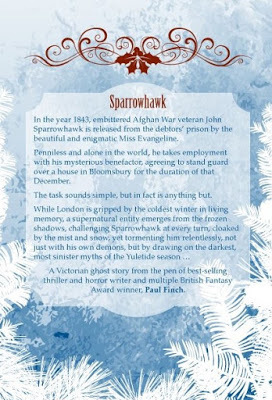 I finally started sketching things out in November 2009, during which month it was already snowing here in Lancashire and what increasingly looked as if it was going to be a very traditional Christmas was almost upon us. From there on, everything seemed to fall into place, the whole storyline spinning itself out in front of me, the characters dropping into the plot one by one of their own volition.
I finally started sketching things out in November 2009, during which month it was already snowing here in Lancashire and what increasingly looked as if it was going to be a very traditional Christmas was almost upon us. From there on, everything seemed to fall into place, the whole storyline spinning itself out in front of me, the characters dropping into the plot one by one of their own volition.I’d always felt that, while writing a Victorian-era Christmas ghost story would be following a well-worn path – there are so many prototypes, after all – what might be a little different would be trying to create one that spoke genuinely of its period and of the festive season and, at the same time, had a relevance for today. And somehow, I felt in myself – and okay, I know I’m the author so obviously I was biased – that SPARROWHAWK might just do that.
Inevitably, as it was scheduled to run to 40,000 words, it wasn’t finished in time for that Christmas. In fact, I was still writing it at Easter 2010, which fell during a gloriously warm and sunny April (and that increased the challenge dramatically, trust me) but the novella was ready by the following autumn, and picked up by independent publisher, Pendragon Press, who, adorning it with a splendidly spectral cover by artist, James Higgins, published it the following December, which, again as fortune would have it, was very cold and very snowy.
The book seemed to do well. The paperback edition sold out quickly, while the ebook version just went on and on. In 2011, it was shortlisted for the British Fantasy Award in the capacity of Best Novella, but lost out to Simon Clark’s excellent HUMPTY’S BONES (if you’re going to lose out, you might as well lose out to something that’s really good, I always say). Only a year after that did its shelf life begin to wind down.
 So why, you may wonder, a decade later, am I bringing out this completely new paperback edition of
SPARROWHAWK
complete with a snazzy new cover courtesy of the inexhaustible Neil Williams, and not only that, putting out an original Audible version too (as narrated by Greg Patmore, who did such an amazing job with my autumnal horror / thriller of 2019,
SEASON OF MIST
)?
So why, you may wonder, a decade later, am I bringing out this completely new paperback edition of
SPARROWHAWK
complete with a snazzy new cover courtesy of the inexhaustible Neil Williams, and not only that, putting out an original Audible version too (as narrated by Greg Patmore, who did such an amazing job with my autumnal horror / thriller of 2019,
SEASON OF MIST
)?Well, it’s simple. On a personal front, I may be better known these days as a writer of crime thrillers than ghost and horror stories, but I like to think that I still have a foot in both camps and I want my new readers to know about this and to read SPARROWHAWK . But at the same time, we can’t pretend that period supernatural thrillers are not back in a big way. In these final years of the 2010s, authors like Laura Purcell, Michelle Paver and Diane Setterfield have forged a dynamic new path for the period chiller subgenre, weaving in gothic and darkly romantic elements alongside vivid historical detail and of course that invaluable 21st century social relevance, to create an entirely new experience for ghost story fans.
Does SPARROWHAWK hit these same buttons?
I’d like to think so, but as I’ve already said, I’m biased. It’s up to you guys, really.
The Kindle edition is still available now as it always was, but the new-look paperback version is out as of yesterday, the Audible due in the next couple of weeks.
And now, just in case you need your appetites whetting even more, here’s a handful of brief trailers:
He approached it, frightened but at the same time fascinated. The elf made no move, and when he got close, he saw why. It wasn’t a real man, but a marionette. It was life-size, but its face and hands were carved from jointed wood and had been crudely painted. Its body and limbs were suspended by strings, which rose towards the ceiling but there were lost in dimness. It was also – and this was perhaps the most disquieting thing of all – a close representation of his father. It seemed that Doctor Joseph Sparrowhawk, the one-time academic, philosopher, publisher and pamphleteer, was now little more than a comic mannequin. Its head lay to one side, its eyes glass baubles containing beads designed to roll crazily around. Its chin and nose were exaggerated, Punch-like, in the tradition of the season, but the lank white hair was the same, the white side-whiskers were the same, the prominent brow, the small, firm mouth …
Despite the intense cold, the mob was in full strength and voice, all classes and creeds represented, the coster folk eagerly supplying them with wintry consumables, everything from boiled puddings to roast chestnuts and hot coffee. Excitable urchins darted back and forth; occasionally a beadle or constable managed to get hold of one and whipped him until he yowled, before kicking him on his way. A tall placard revealed the presence of a long-song seller. “Three yards a yenep, three a yenep!” he shouted hoarsely, as he told the ghoulish tale of James Keggs, a buckle-maker from Southwark, who had lured four unfortunate women back to his cellar room, and there throttled them and raped their corpses. Several well-to-do ladies did the honourable thing by fainting in their carriages. “Four victims,” Miss Evangeline said. “That’s two short of your tally.” “Hardly,” Sparrowhawk replied. “My full tally would make your toes curl.” With another low growl, this one mewling and prolonged, the lion-thing tore off its dress shirt. The naked torso beneath was massive of shoulder and chest, padded all over with muscle, rich with thick, tawny fur. The monster hunched low, the entire room reverberating to its growls. Fleetingly Sparrowhawk saw its eyes again: pits of molten gold. With an ear-splitting roar, it charged, still on two legs but in a stooped, gambolling run, swerving in and out of the moonlight. Sparrowhawk knew that it would leap on him and tear him apart, snap his limbs, flay the flesh from his ribs, clamp his skull with its colossal jaws, its ivory teeth sinking like bayonets through skin and bone ...
THRILLERS, CHILLERS, SHOCKERS AND KILLERS …
An ongoing series of reviews of dark fiction (crime, thriller, horror and sci-fi) – both old and new – that I have recently read and enjoyed. I’ll endeavour to keep the SPOILERS to a minimum; there will certainly be no given-away denouements or exposed twists-in-the-tail, but by the definition of the word ‘review’, I’m going to be talking about these books in more than just thumbnail detail, extolling the aspects that I particularly enjoyed (I’ll outline the plot first, and follow it with my opinions) … so I guess if you’d rather not know anything at all about these pieces of work in advance of reading them yourself, then these particular posts will not be your thing.
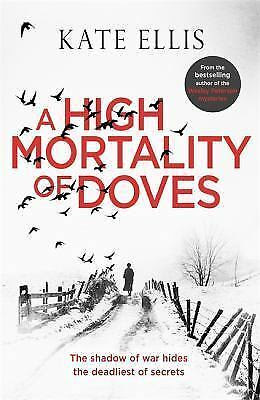 A HIGH MORTALITY OF DOVES
by Kate Ellis (2017)
A HIGH MORTALITY OF DOVES
by Kate Ellis (2017)
OutlineIt’s 1919, and Britain is still reeling from the horrors of the trenches. But the village of Wenfield in Derbyshire appears to have suffered more than most. Numerous of its young men failed to return, while others have only done so after being horribly wounded or shellshocked, many of their families broken as a result. As if this isn’t difficult enough for the grief-stricken local population, a bizarre series of crimes now commences.
It begins with Myrtle Bligh, a young woman who volunteered at the wartime hospital set up in the nearby stately home, Tarnhey Court. Though she believes her fiancé, Stanley, killed on the Somme, she is stunned to suddenly receive a letter from him explaining that he is alive but in trouble, and that he needs to have a secret meeting with her out in nearby Pooley Woods. Excited beyond belief, Myrtle rushes out there, but when Stanley confronts her in the shadow of the trees, he is nothing like the man she remembers. He is nothing like any man at all.
A short time later, Myrtle is found murdered, ripped apart by a military bayonet, her mouth slit to the ears, with a dead dove shoved inside it.
The investigation is initially undertaken by the local constabulary, led by the stolid but unimaginative Sergeant Teague, while the medical examination is spearheaded by local GP, the cold and rather reserved Dr Winsmore. Fascinated by this ghoulish turn of events is Winsmore’s daughter, Flora, who served alongside the deceased Myrtle as a nurse at Tarnhey Court, and thanks to this experience, is disturbed neither by gruesome injuries nor the fast-spreading rumour that a ghostly soldier with a nightmarish face has been seen lurking on the outskirts of the village.
Flora’s father disapproves of his daughter’s involvement. In fact, even though she helps out at his surgery, he even tries to dissuade her from applying to nursing college so that she can take up the profession full-time, seemingly determined to maintain her sheltered existence in the village and keep her under his benign but firm control.
However, this becomes increasingly difficult for him when there is another identical murder, Annie Dryden, whose son went missing in action years ago, summoned to meet him by anonymous letter, her butchered body subsequently found off an overgrown country lane.
Flora – despite being affected by her own personal loss, her brother having died in Flanders (or maybe because of this!) – determines to be useful and continues to attempt to inject herself into the investigation, though nothing about the case is simple. Wenfield is not just a village of gossip and backbiting, it’s also a village of secrets. Most people here resent someone or other among their neighbours, and almost everyone has something to hide. Even Flora’s own father has a murky past; his wife (Flora’s mother) supposedly ran off with a ‘fancy man’ some time ago, leaving him to enter into an unspecified relationship with his beautiful housekeeper, Edith, who became like a second mother to the young Flora until she left the family’s service during the war. Even the local landowner, Sir William Cartwright, and his son, Roderick – an old friend of Flora’s – have secrets, and not of the edifying kind. It isn’t even as if there aren’t other potential culprits. For example, Winsmore’s colleague, Dr Bone, is a handsome but superficially charming man, though Flora happens to know from personal experience that has an unhealthy appetite for young girls.
As such, it all seems too simple to Flora when the murder spree is blamed on a local simpleton, Jack Blemthwaite (mainly because he is the one who discovered Myrtle’s body). Inevitably, the charges don’t stick, but even then it takes a third murder, while Jack is in prison, for the case against him to be dropped.
Flora is mightily relieved when an experienced murder detective, Inspector Albert Lincoln, is at last sent up from Scotland Yard. Though battle-scarred himself and, thanks to great unhappiness at home, something of an introverted character, Lincoln is a clear-headed, analytical investigator, who immediately brings in a more professional approach, an aspect of his character that Flora finds instantly attractive.
She is also fascinated by his observations that, though all the female victims here were brutally murdered, there was never a sexual assault, suggesting that this isn’t just a rampaging lust killer. The so-called phantom soldier roaming the village outskirts is also significant, he feels, as is the symbolic insertion of a white dove – normally a sign of peace – into each of the corpses.
Gradually, under Lincoln’s (ever closer) guidance, Flora comes to realise that the killings in Wenfield, which are not necessarily over yet, are part of a complex web of malice and deceit, and that there are actually a great number of very viable suspects …
ReviewWhen I first commenced reading A High Mortality of Doves , I wasn’t sure what to expect. The promotional material was intriguing, describing a series of murders occurring in a small rural community immediately following World War One, the chief suspect a phantom soldier with a painted, doll-like face. It promised all kinds of interest, hinting at everything from the historical novel to the village green murder mystery, from a spine-chilling MR James-type ghost story to the suspense-laden tale of a serial predator.
And indeed, in due course, the book ticks all of these boxes.
The immediate thing that struck me is how well Kate Ellis goes about recreating the immediate post-war atmosphere of small-town England in 1919, by which point, of course, the country hasn’t had anything like enough time to recover. Disproportionate numbers of young men never came home from the Front, while the ones who did carry hideous scars, either physically or mentally, or both.
This part of the book is particularly vividly done (without being heavy-handed), bringing it home to the reader with a bump just what it would have meant to live in a community like this, where the numbers of menfolk have been so cruelly depleted, where so many of the womenfolk, young and old alike, are bereaved. Inevitably, Wenfield is not a happy place, though concerted efforts are made by all to be ‘stiff upper lip’ about it, put on a brave face and get on with their lives (though already there are hints of the terrible Spanish Flu scourge that followed so quickly after World War One and also killed millions).
That’s the backdrop to the narrative, which is unique enough, though the story itself is more than a little bit compelling.
With Wenfield in mourning, and hardly a prosperous village anyway (this is industrial Derbyshire, not the leafy Home Counties), the mood is already very different from anything you’d find in the more typical cosy murder mystery, and yet now we have a brutal slayer and mutilator on the loose rather than a straightforward murderer, and if that isn’t horrific enough, evidence that he may or may not be supernatural in origin. It’s no spoiler to reveal that early on in the text, we see the killer for ourselves as he approaches his victims in lonely places, and he is indeed frightening, a ghastly apparition – ‘human yet not human,’ as the author describes him – someone you’d run a mile from even if he wasn’t about to carve you up with his bayonet. That doesn’t mean that A High Mortality of Doves is a horror story, but it certainly adds more than a frisson of fear to proceedings, particularly whenever another poor woman receives an anonymous message to go and meet a relative she’d thought lost in the mud and blood of the trenches.
Ultimately, of course, despite all these extra trappings, A High Mortality of Doves is still a whodunnit, Kate Ellis cleverly sprinkling her plot with a host of potential suspects … like Sydney Pepper and David Eames, who came back from war disfigured and possibly demented, or Roderick Cartwright, who signed up willingly but was kept out of harm’s way and now resents the hostility of the town’s widows, or like Dr Winsmore, who still can’t (or won’t) account for his wife’s absence, or, more than anyone else, like Dr Bone, who already has a history of sexual predation against women and girls (even though no one knows about this, or at least they don’t dare repeat the rumour because after all, it’s still the Age of Men).
In classic Midsomer Murders fashion, all of these individuals, and others like them, become feasible suspects, the focus of the investigation shifting back and forth between them as the plot twists and loops, the tide of suspicion turning constantly, Kate Ellis keeping the reader guessing right to its final pages, maintaining the satisfaction level throughout (though by the end, it feels like a very different story from the one you started, and I mean that in in a good way).
Another of the book’s strengths is its characters. Flora Winsmore makes for a spirited and likeable lead, and is nicely illustrative of the young women of that era, when World War One changed society and enabled the rise of the suffragette movement. The preceding years have allowed Flora to prove that she is as good and conscientious a worker as any of her male colleagues, having enjoyed the useful independence she found while nursing the wounded, and now keen to take it on full-time. The deep frustration she feels about her father’s refusal to accept this is understandable, and if she at times seems a little eager to thrust herself into the investigation, it’s forgivable given her proactive nature and the relationship she embarks on with Albert Lincoln.
Lincoln himself is an equally complex character, though he owes a little more to that golden age of fictional but sharp-eyed detectives who are invariably imported from outside the murder-stricken community to resolve a case quickly and with minimum fuss while all the locals remain flummoxed. Okay, it isn’t quite that simple, but Lincoln is a familiar figure to us, despite his various scars, though that doesn’t make him any the less reassuring a presence at the heart of this dark tale.
I will admit to having some doubts about the burgeoning romance between Lincoln and Flora, and couldn’t help wondering if it felt a little bit forced. Both characters at least appear to have solid moral centres, and while Flora’s desire to make a new life for herself in the modern world naturally leads her into the arms of a city man with real-life experience, Lincoln’s response appears to be rather callous considering that he’s already married and, though it’s a loveless match, the deep depression that his wife is entrapped in. Lincoln is a sad, rather noble figure, and his dalliance with the feisty Flora feels like a bit of a misstep to me, but that’s only one viewpoint, and lots of others have disagreed.
A High Mortality of Doves remains an engaging and atmospheric mystery, set against the authentically turbulent background of a nation in mourning and in flux. Scary and intriguing in equal parts, while the final devastating denouement is worth the price alone.
And now, the moment you’ve been waiting for. My attempt to cast A High Mortality of Doves. Don’t worry, I’ve not been given that actual task. Should we ever be fortunate enough to see this novel be adapted for film or TV, someone who knows what they’re doing will get the gig. This is just a bit of fun (as you’ll realise when you see how much money I’ve spent on the actors).
Flora Winsmore – Lucy BoyntonDI Albert Lincoln – Dominic CooperRoderick Cartwright – Aneurin BarnardDr Winsmore – Ian HartDr Bone – Rory KinnearSir William Cartwright – Guy PearceEdith Barton – Alison PargeterSydney Pepper – Adrian BowerDavid Eames – Jamie Bell
September 17, 2020
Terror Tales of the Home Counties is here
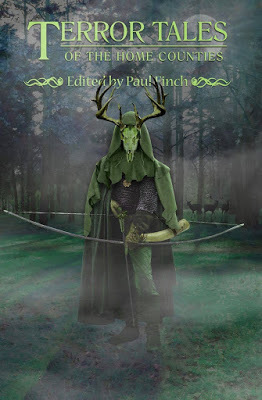 Okay, it’s here. After much trumpeting online this week, TERROR TALES OF THE HOME COUNTIES is finally available for pre-order. In addition, I’m at last able to reveal its TABLE OF CONTENTS.
Okay, it’s here. After much trumpeting online this week, TERROR TALES OF THE HOME COUNTIES is finally available for pre-order. In addition, I’m at last able to reveal its TABLE OF CONTENTS.
You’ve already seen the artwork. Now check out the list of authors who’ll be gracing our pages, along with a few juicy snippets and a bit of back-story to this publication and others like it.
On top of all that, in the same ‘Mysterious Britain’ vein, I’ll be offering a detailed review and discussion of another British folk-horror collection, THIS DREAMING ISLE, as edited by Dan Coxon, which again brings you a package of original fiction written by a host of horror stars.
If you’re only here because you’re interested in the Coxon antho, that’s fine (Grrr!). As usual, all you need to do is zoom on down to the final section of today’s blog, Thrillers, Chillers , where you can read it straight away. However, before then – just stay awhile – and let’s talk about the …
Home Counties
I like to think that my back-cover blurb to this new book (below) says it all. But just in case you’re still unsure, the Home Counties have to be one of the most bucolic regions of the UK.
 Suburban and semi-rural, they have long possessed the aura of agricultural heartland, and yet they are close enough to London to participate in its buoyant economic life.
Suburban and semi-rural, they have long possessed the aura of agricultural heartland, and yet they are close enough to London to participate in its buoyant economic life. Oh yes, the Home Counties are a tale of prettiness and prosperity. It’s as tranquil as England gets, and as picturesque. Nothing ever goes wrong in this neck of the woods.
You reckon?
Think again.
There’s a dark side to everywhere, even here. And this little lot will leave you in no doubt of that:
CONTENTS
In the English Rain by Steve DuffyDevils in the CountrysideMonkey’s by Reggie OliverThe Ostrich InnThe Old, Cold Clay by Gail-Nina AndersonThe Buckland ShagBetween by Sam DawsonThree More for the HangmanMy Somnambulant Heart – Andrew HookThe Horned HuntsmanThe Gravedigger of Witchfield by Steven J DinesThe Naphill Death OmenWhere are they Now? by Tina RathLand of Dark ArtsThe Doom by Paul FinchLord Stanhope’s HomonculiSummer Holiday by John Llewellyn Probert The Coldest Christmas of AllChesham by Helen GrantThe RavenLove Leaves Last by Mick SimsThe Thing by the RoadsideThe Topsy Turvy Ones by Tom JohnstoneKnocking KnollTaking Tusk Mountain by Allen AshleyThe DrownedMoses by David J HoweEerie in OilThe Old Man in Apartment Ninety by Jason Gould
And for your further delectation, here are a few short clips, just to whet your appetites further:
A man lay on a king-sized bed with his hands behind his neck. He wore a full black-devil mask with gold paint around the eyes and running down either side of the face like tears. The horns and lips were painted red. Like everyone else at the party, he was naked except for the mask he wore. His body was muscular and hairy … The Gravedigger of Witchfield by Steven J Dines
She would never have got into a car with a perfect stranger, on a sunny day, when she knew a bus would be along in a few minutes. It’s not as if it was pouring with rain … I mean, she wasn’t an idiot. Sharp as a tack … and they never found anything. Not a trace of her or her belongings. Her bank card’s never been used, her phone wasn’t recycled … Nothing. Where Are They Now? by Tina Rath
The Spanish director José Larraz had filmed his extremely low budget ‘Vampyres’ at Oakley Court. While there was no specific death scene that one could identify with that film, Aunt Agatha certainly liked her wine (there is a prolonged segment featuring wine tasting in the movie) and she was thin enough that her veins would be easily accessible for a neat and hopefully fuss-free exsanguination … Summer Holiday by John Llewellyn Probert
My mind is populated with scraps of memory intertwined with what can only be nightmares. From those taboo spaces, the abandoned mansion, the lonely copse, the mouldering shelters, things not distinctly seen come creeping. Something shifts stealthily within the empty house. A child wanders into the copse and does not come out again. A Silver Cross pram stands in the shade under a tree in the park – the mother returns with an ice cream, gazes inside, and screams and screams … Chesham by Helen Grant
TERROR TALES OF THE HOME COUNTIES is the 12th in a series of horror anthologies I’ve been editing since 2011 (firstly through Gray Friar Press and now through TELOS PUBLISHING , my overarching aim to create a vivid picture of my homeland through the prism of its folklore and mystery, its diversity of landscape and legend.
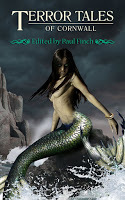 For this reason, in each volume I intersperse the fiction with snippets of true terror, i.e. non-fictional accounts of scary rumours and eerie fables connected to the districts in question. The actual fiction I elicit for these books MUST be localised. Whatever part of the country we are talking about, it’s not good enough just to have a story that happens to be set there. It must be relevant to that region, either through history, geography or lore.
For this reason, in each volume I intersperse the fiction with snippets of true terror, i.e. non-fictional accounts of scary rumours and eerie fables connected to the districts in question. The actual fiction I elicit for these books MUST be localised. Whatever part of the country we are talking about, it’s not good enough just to have a story that happens to be set there. It must be relevant to that region, either through history, geography or lore.To date, as you’re no doubt aware, we’ve covered about half of the UK. The full list of titles is as follows: TERROR TALES OF THE HOME COUNTIES … THE SCOTTISH HIGHLANDS, NORTHWEST ENGLAND , CORNWALL , YORKSHIRE , WALES , LONDON , EAST ANGLIA , THE COTSWOLDS , THE LAKE DISTRICT, THE OCEAN, THE SEASIDE.
And it’s my absolute intention to continue, and when the tapestry is complete, perhaps to venture beyond our shores. You may have already noticed that in 2015 we published TERROR TALES OFTHE OCEAN .
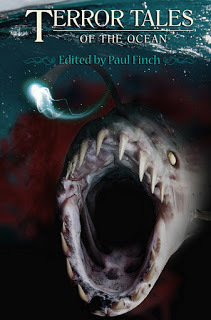 Don’t ask me why I took a break from our round-Britain trip to produce that particular book. I simply can’t remember. But it contains stories set on and beneath oceans as far afield as the Pacific, the Indian and the Antarctic. And yes, there’ll be more of that in due course. There are many locations around the world, both land and sea, whose terrifying traditions I am eager to investigate.
Don’t ask me why I took a break from our round-Britain trip to produce that particular book. I simply can’t remember. But it contains stories set on and beneath oceans as far afield as the Pacific, the Indian and the Antarctic. And yes, there’ll be more of that in due course. There are many locations around the world, both land and sea, whose terrifying traditions I am eager to investigate.You see, the one thing I’ve learned on this journey is that no corner of any place, no matter how placid on the outside, if you look hard enough, is free from uncanny folklore and gruesome history. But nothing, in my view, illustrates this better than TERROR TALES OF THE HOME COUNTIES .
So many folk see the Home Counties and think of a place where the GDP per capita is almost indecently high. They see a region of chocolate box villages, cosy dormer towns and blue chip company HQs set in acres of manicured parkland, every part of it offering fast, direct links to the throbbing heart of London commerce.
However, affluence is not the whole story. Pockets of deprivation exist in the HCs, while the presence of so much often-isolated wealth has regularly attracted the interest of ‘higher end’ criminals. Yep, blood has been shed in the Home Counties, and not just recently. Southeast England was always the first part of the country to be invaded. At the same time, social unrest was never far away, local folk turning violent in their resistance to tax or mechanisation. Zealous residents like John Milton and John Bunyan indicate that this was once a land of religious fervour. Heretics were pilloried, martyrs publically burned; there were witch trials and hang-fairs, while highwaymen and footpads plagued the district’s leafy lanes, at many points of which they would later be gibbeted. And then there are those even darker tales. The Home Counties boast a plethora of devilish legends: satanic cults and covens fill its mythology, while malevolent woodland beings – goblins and sprites – haunt its pools and coppices, a host of royal ghosts roams the halls of its rambling country houses, and big cats lurk in every roadside hedgerow.
Fancy hearing more? Something specific perhaps? Something that will really ice your blood?
Well, there’s only one way that’s going to happen.
TERROR TALES OF THE HOME COUNTIES is available to pre-order right now. Just follow the link.
THRILLERS, CHILLERS, SHOCKERS AND KILLERS …
An ongoing series of reviews of dark fiction (crime, thriller, horror and sci-fi) – both old and new – that I have recently read and enjoyed. I’ll endeavour to keep the SPOILERS to a minimum; there will certainly be no given-away denouements or exposed twists-in-the-tail, but by the definition of the word ‘review’, I’m going to be talking about these books in more than just thumbnail detail, extolling the aspects that I particularly enjoyed … so I guess if you’d rather not know anything at all about these pieces of work in advance of reading them yourself, then these particular posts will not be your thing.
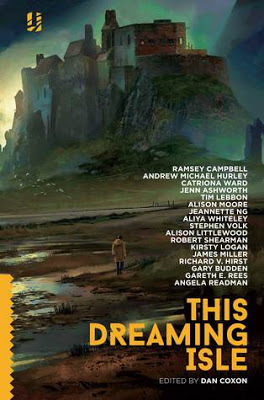 THIS DREAMING ISLE
ed by Dan Coxon (2018)
THIS DREAMING ISLE
ed by Dan Coxon (2018)
One of several recent anthologies of short stories brought out to celebrate the current and expanding interest in British folk-horror and the British folk-weird, though I think in this case the emphasis is more on the latter than the former despite editor Dan Coxon’s selection of stories by some very familiar and much-lauded horror writers. This Dreaming Isle comes to us from Unsung Stories, an independent, London-based imprint already responsible for a range of intriguing titles from a host of up-and-coming authors.
Before we get into the meat of the anthology, here’s what the publishers themselves have to say about it in their back-cover blurb:
Britain’s long history of folk tales, ghost stories and other uncanny fictions shimmers beneath the surface of this green and pleasant land. Every few generations the strangeness crawls out from the dark places of the British imagination, along literary ley lines, seeping into our art and culture. We are living through such a time.
This collection of seventeen new horror stories and weird fictions draws upon the landscape and history of the British Isles. They walk the realms of folklore and legend but are firmly rooted in the present, calling to the country’s forgotten spaces. The ghostly figures half-hidden by mist, the shadows in city corners, and the violence of the sea, battering the coastline relentlessly. The land dreams them all.
Featuring exclusive stories from Ramsey Campbell and Tim Lebbon, Jenn Ashworth and Andrew Michael Hurley, join us as we reclaim the dark heart of Britain’s literary legacy.
Unsung Stories have a self-stated aim to focus on literary fiction, and there’s no doubt with The Dreaming Isle that they’ve hit that target from the start. There is some immensely high quality writing on show here along with some very subtle story-telling. Whether the tales themselves will all be to everyone’s taste is another matter, but the technical skills of the authors Dan Coxon has brought together are beyond doubt. There isn’t a clunker in the book, every contribution a smooth and well-crafted piece of speculative fiction and a pleasure to read.
The folk aspect is also heavily to the fore, the book set now, in contemporary Britain, with all the bleak ugliness that sometimes entails, and yet is richly atmospheric of an ancient land steeped in mystery and tradition, so much of it drawn from the landscape itself and the seasons and customs that continuously transform it.
Whether it’s classifiable as ‘horror’ is, as I say, up for debate. But we are firmly in the realm of the weird, and there is much here that will disturb and unnerve the average reader even if it doesn’t necessarily terrify them.
Rather oddly, I thought, the book is divided up along geographic lines. We have a rural section, an urban section and then a coastal section. To me, though I wouldn’t be so bold as to try to establish the criteria for what folk-horror is or must be, I’ve always thought that one aspect of it at least is a concern about what lies just below the surface of modern society. Therefore, cities and towns are not special cases. Just because all the henges, holy wells and green ways that once occupied their sites have now been swept away by conurbation, that doesn’t mean the latent powers aren’t still there. But this is really a minor quibble. It’s the editor’s choice and it doesn’t really spoil anything, so I’m probably being pedantic just mentioning it.
Of the stories themselves, several from all these sections I can comfortably categorise as traditional spook stories, albeit spook stories written with panache … and though the horrors aren’t always subtle, they don’t bludgeon the reader either.
Possibly the best example of this is the first story in the book, The Pier at Ardentinny by Catriona Ward. This is an excellent piece all-round and ticks every box for me personally. It’s also the most typically horrorish in the book (for want of a better term) in that it features a disturbed central character being taken away from a terrible past to an apparent place of safety, only to be confronted by something even worse. (More about this one later).
Even more traditional than this in that it’s immersed in a more familiar legend, Alison Littlewood hits us with The Headland of Black Rock , in which a past-it actor who has used and abused women all his life takes a solo holiday on the Cornish coast and is immediately bewitched by a beautiful girl he sees strolling in the surf. It’s a well-trodden horror path, but as always with Littlewood, the quality of the prose carries you through at speed.
A similar theme of deserved comeuppance lurks in James Miller’s Not All Right , the first story in the book to take us into the city. In this one, a right-wing agitator and general layabout comes to London to look for a top job and while he does, stays in his powerbroker uncle’s posh flat. But the building is eerie as well as swish, and he never feels quite alone while he’s there. A slick, exquisite tale of creeping paranoia.
Back to the countryside again, and two more tales displaying classic supernatural tropes.
The ever-reliable Stephen Volk’s Cold Ashton is laced with righteous fury about bigotry and ignorance, but it doesn’t forget that it’s a horror story either, so it doesn’t completely dismiss the worries and concerns of the uneducated past, and ends on an intensely televisual (and rather spine-chilling) note. (More about this one later too). Then we have Kirsty Logan’s Domestic Magic , which gives us our second Scottish Highlands setting of the anthology, and evokes another ancient and unnerving piece of local mythology, the gradual emergence of which becomes progressively scarier. (More about this one later as well).
Over to the coast now, where one of the true masters of modern horror, Ramsey Campbell spins another of his unapologetically terrifying psychological yarns, The Devil in the Details . As always with Campbell, though there are snippets of local folklore embedded in this tale, the nightmarish qualities owe more to the inner demons of its disturbed and isolated characters, but the quality of the work, as ever, is supreme. (Yes … more about this one later too).
On the subject of damaged psychology, speculative fiction, by its very nature, is an art form made-to-measure for addressing the human condition, and This Dreaming Isle doesn’t let us down on that score.
Jenn Ashworth’s Old Trash maintains a semblance of the classic mythological horror story, but is ultimately more interested in the interplay of its juxtaposed characters as a tired but concerned mother struggles to get her wayward daughter out of an inappropriate relationship by treating her to a camping trip in the wilds around Pendle Hill, at the same time trying to ignore the local myths about roaming devil dog, Old Trash. You’ll never look at a tent the same way again.
Another dysfunctional mother/daughter relationship is on show in Alison Moore’s The Stone Dead , which sees recently separated mum, Lesley, living in an isolated coastal house where she is regularly visited and tormented by her own disapproving mother. It’s a truly agonising scenario, and something, you feel certain, is eventually going to give.
Perhaps the subtlest tale in the book, though, comes from Aliya Whiteley. In Dark Shells , she takes the guise of an OAP whose mind is now drifting, and yet who is able to relate disjointed stories from her past to an interested researcher. There are eerie secrets buried in these tales of course, but the story’s greatest strength, for me at least, stems from its completely authentic portrayal of an aged person struggling to recollect, link and articulate the key events in her life.
Now, from the personal canvas of the inner self to the much broader canvas of the land.
It’s surprised me in recent years how much the folk-horror subgenre has become fixated on ‘the land’. But that is just me being unimaginative. The notion that everything about us is written there, our hopes, our dreams, our fears, is increasingly a subject of analysis in this field. And let’s be honest, the idea that the land itself – the rock forms, the forest, the marsh, the windswept coastline – is the key to our existence is hardly new. Throughout all of human history, we’ve worshipped it, we’ve fought over it, we’ve ruined it, we’ve regenerated it, we’ve played out every drama in our lives across every part of it. No wonder it’s fuelled so many of our fantasies and dreams. While we’ve changed as the millennia have rolled by, the land itself hasn’t, apart from superficially. We shouldn’t be surprised if everything about us, including everything we’ve ever believed, is somehow recorded there, layer upon layer. Not all of it, of course, good.
Inevitably, this key note is hit several times in This Dreaming Isle , though always in different, imaginative ways. The most startling example for me is surely Gareth E Rees’s very clever The Knucker , which sees different strands of history entwine to create the legend of the Knucker, a terrifying sea-dragon said to have terrorised England’s South Coast during the Dark Ages, and at the same time provide a ‘locked room’ mystery for 21st century cops when two travellers are found drowned miles from the nearest water-source. Meanwhile, another master of the lyrical horror story, Tim Lebbon, brings us his own unique take in Land of Many Seasons . Here, a lonely artist paints various aspects of a rugged Welsh mountainside at different times of year. Increasingly though, a strange figure keeps appearing on the canvas, which he has no memory of painting. The only explanation may lie in the eerie local legend of ‘the walker’.
Less spooky but no less disturbing, top-stylist Andrew Michael Hurley chips in with In My Father’s House , which also presents us with some very neat character work. In this one, Lancashire lad, Mike, isn’t keen to build bridges with his grumpy old dad, but after the aged parent gets a beating from someone, they reluctantly try to reconnect. Dad is a strange one, these days, though, as Mike discovers one night just before Christmas, on the wide, snowy moors.
Perhaps the most land-oriented of them all, however, comes in the shape of Gary Budden’s melancholy Hovering , in which the central character, Iain, while struggling to recover after the end of a long-term relationship, moves to Pegwell Bay in Kent, a deceptively dreary place, where the ghosts of many different pasts are soon congregating around him.
Of course, none of these affecting stories would pack an nth of the power they do if it wasn’t also for that inner landscape of the human mind, which they each evoke and examine in just as much detail as they do the wild spaces of forgotten Britain.
I haven’t talked about every story in This Dreaming Isle . That’s not because they didn’t all work for me, though inevitably one or two didn’t, but simply because I have to leave some of it to the imagination. But it would remiss of me not to at least mention in passing Robert Shearman’s astonishing contribution, The Cocktail Party in Kensington Gets Out of Hand .
Shearman is nothing if not an expert surrealist, and in this tale takes it to new extremes, the central plank of it seeing a male escort hired to lie naked on the floor as a human rug during a decadent Kensington cocktail party, though at no stage is he given a firm answer as to when the ordeal will end. My initial thought after this was that it wasn’t folk-horror, and yet, in truth, I’d never be so bold as to proclaim that. There are multiple meanings to Shearman’s crisply-written and never-less-than-disturbing urban fiction – it’s down to all of us to get what we can out of it. Be warned, though: this tale is more distressing than most.
And now …
THIS DREAMING ISLE – the movie.
Okay, no film maker has optioned this book yet (as far as I’m aware). But you never know. Until that happy time comes, here – purely in the spirit of having a bit of fun – are my thoughts on how it should look and feel were it ever to finish up on the big screen.
Note: these four stories are NOT the ones I necessarily consider to be the best in the book, but these are the four I perceive as most filmic and most right for adaptation in a compendium horror. Of course, no such movie can happen without a central thread, and this is where you guys, the audience, come in. Just accept that four strangers have been thrown together in unusual circumstances which require them to relate strange and eerie tales (with more of an emphasis on strangeness and dreaminess than usual, in this one, I think).
 It could be that each segment is an unsolved paranormal case, as handed by one retired and decrepit investigator to a young up-n-comer (al la Ghost Stories, right), or maybe their stories are all connected to various items available in a backstreet trinket shop (such as in From Beyond the Grave).
It could be that each segment is an unsolved paranormal case, as handed by one retired and decrepit investigator to a young up-n-comer (al la Ghost Stories, right), or maybe their stories are all connected to various items available in a backstreet trinket shop (such as in From Beyond the Grave).Without further messing about, here are the stories and the casts I would choose:
The Pier at Ardentinny (by Catriona Ward): Irene’s beauty protected her during her abusive childhood, but she still did bad things. Later, as a repressed adult, she potentially finds love with elderly and respectable Anthony, who takes her home to Scotland. But she’s worried, because rumour holds that if you look into the loch at Ardentinny, the reflection in the waters will reveal your true self …
Irene – Anya Taylor JoyAnthony – Dougray Scott
Cold Ashton (by Stephen Volk): A Cotswolds scholar investigates a bunch of village documents detailing a 16th century witch trial. He is appalled by the injustice and cruelty meted out to the suspect, Joan Goodchyld, but chilled by the suggestion that whatever dark magic was woven all those centuries ago, the terrible results might still be in the village…
The Investigator– Jason WatkinsJoan Goodchyld – Katheryn Winnick
Domestic Magic (by Kirsty Logan): Same sex couple, Rain and Alison, inherit a tumbledown cottage in the Scottish Highlands. It’s a mess and needs much work, but more worrying than this are the many clues they find seemingly proving the family fable that Alison’s ambitious and ruthless grandma once trapped a kelpie here, and killed it …
Alison – Rose LeslieRain – Betty Gabriel
The Devil in the Details (by Ramsey Campbell): Young Brian and his family take newly divorced Aunt Leonie to a drab seaside town on the Northwest coast. But after witnessing a fatal accident, Brian becomes terrified of the mysteriously angelic murals, painted by a renownedly evil man, that seem to cover the interiors of the local stately buildings ...
Aunt Leonie – Annabel ScholeyBrian – All suggestions welcome. I don’t know too many child actors.
September 13, 2020
When Britain turns dark, drear and spooky
 Well, no one expected the COVID crisis to last as long as it has, certainly not into the autumn, which is where we are now. But life must go on as much as it can, and one of the best ways I find not to ponder the depressing and seemingly intangible issue of Coronavirus is to treat each new week as a separate entity and enjoy it for itself, and now, because we’re finally into the waning of the year, there are suddenly lots of new ways to do this.
Well, no one expected the COVID crisis to last as long as it has, certainly not into the autumn, which is where we are now. But life must go on as much as it can, and one of the best ways I find not to ponder the depressing and seemingly intangible issue of Coronavirus is to treat each new week as a separate entity and enjoy it for itself, and now, because we’re finally into the waning of the year, there are suddenly lots of new ways to do this.Invariably, on this blog at least, that means appreciation of the dark side.
Yes. It’s cooler and duller now, and the nights are growing longer, the chill of winter looming. It’s the time for bonfires, conkers and, most important of all, ghost stories. For this reason, I’m going to be talking a bit today about SEASON OF MIST, the autumnal ghost/horror/serial killer novella of mine, which was published this time last year, and in that same vein – the flipside of Merrie England – we’ll be reviewing and discussing BEST BRITISH HORROR 2018, as edited by Johnny Mains.
If you’re only here to read today’s book review, that’s fine. Feel free to zoom on down to the lower end of the blog. As usual, you’ll find it in the THRILLERS, CHILLERS section. But if you’ve got a bit more time first, there are a couple of other minor things.
Riding high
First of all, ONE EYE OPEN has been my main novel release this year. Regular readers will probably know that it was published in August.
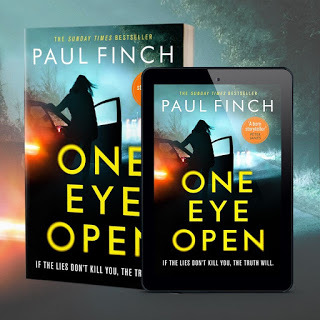 Well … the good news is that, despite a very crammed September, which saw such mega-tomes as Richard Osman’s
The Thursday Murder Club
, Margaret Atwood’s
The Testaments
and Robert Harris’s
V2
, all published, along with hundreds and hundreds of others,
ONE EYE OPEN
is still riding high in the charts. It reached something of a watermark last week when it arrived at #66 in the Kindle Top 100. (Okay, that’s not #1, but when you consider all the millions and millions of other e-titles out there, I can hardly complain). So, I’d like to take this opportunity to thank everyone who’s so far bought a copy along with those who are planning to but haven’t done it quite yet (don’t worry, there’s still time).
Well … the good news is that, despite a very crammed September, which saw such mega-tomes as Richard Osman’s
The Thursday Murder Club
, Margaret Atwood’s
The Testaments
and Robert Harris’s
V2
, all published, along with hundreds and hundreds of others,
ONE EYE OPEN
is still riding high in the charts. It reached something of a watermark last week when it arrived at #66 in the Kindle Top 100. (Okay, that’s not #1, but when you consider all the millions and millions of other e-titles out there, I can hardly complain). So, I’d like to take this opportunity to thank everyone who’s so far bought a copy along with those who are planning to but haven’t done it quite yet (don’t worry, there’s still time).While we authors tend not to be affected by reviews, either good or bad (we can’t afford to be – it’s only ever one person’s opinion), we cannot fail to be hugely gratified when we see our books rocket up the charts. If nothing else, that means word of mouth is spreading that lots of people like what we’ve written. It’s never less than lovely to know that your work is hitting the spot widely.
So, thanks again to everyone who has purchased ONE EYE OPEN . I hope you are finding it a rewarding experience. And now, the not insignificant matter of …
The mist
My novella, SEASON OF MIST , was published this time last year in paperback, on Kindle and on Audible, where it was narrated by the actor Greg Patmore, who put a voice to it that I could not have hoped for in my wildest dreams.
 It first appeared as part of the collection,
WALKERS IN THE DARK
, which was published in 2010 and launched in Brighton at the World Horror Convention. That original piece of work, like so many other publications from one-time supernatural powerhouse, Ash-Tree Press, had been long, long out of print by 2019. And of course, it predated the new audience I’ve managed to gain for myself through my crime and thriller writing.
It first appeared as part of the collection,
WALKERS IN THE DARK
, which was published in 2010 and launched in Brighton at the World Horror Convention. That original piece of work, like so many other publications from one-time supernatural powerhouse, Ash-Tree Press, had been long, long out of print by 2019. And of course, it predated the new audience I’ve managed to gain for myself through my crime and thriller writing.Thus, last year, it suddenly seemed very sensible to dig SEASON OF MIST up and bring it out again as a stand-alone item. Which is exactly what I did.
This particular novella had always been intended as a celebration of the autumn, particularly the British autumn, which can easily adopt a Sleepy Hollow-esque appearance - flame-red leaves on the trees, low-lying mist, and fiery jack-o-lanterns watching malevolently from doorsteps – but which has some unique attributes of its own: a deep, dank chill in the fungus-riddled depths of the woods, early winter fog and frost, fireworks exploding overhead, treacle, toffee apples.
The actual story is set during the autumn of 1974, and follows a bunch of 12 and 13-year-olds, whose happy preparations for Halloween and Bonfire Night, and then afterwards, Christmas, are massively disrupted when a series of child-murders occurs in their Lancashire town, the victims all beaten savagely to death.
While parents make frantic efforts to keep everyone indoors, the youngsters won’t be harnessed. This is their favourite time of year, after all, and they are eager to get out at every opportunity to find the killer themselves. The only difference is that, while the police are searching for a maniac, the youngsters know better, and they blame the felonies on Red Clogs, an infamous child-murdering demon supposedly escaped from one of the derelict collieries in the town.
By the way, despite the ages of the main protagonists, SEASON OF MIST is NOT a children’s or YA book, so please be warned about that.
From the outset, it was always intended to be a combination of crime-thriller and horror story, the pre-DNA era hunt for a serial killer continually overlapping with the folklore and mysticism of Northwest England during its heyday of soot and grime.
From reviews like these …
… took me back to my childhood in Lancashire …
… a wonderfully creepy coming-of-age story …
… really enjoyed the urban legend that ran through it …
… I like to think I succeeded, but as I mentioned before, these are no more than individual opinions. I wonder what yours might be?
THRILLERS, CHILLERS, SHOCKERS AND KILLERS …
An ongoing series of reviews of dark fiction (crime, thriller, horror and sci-fi) – both old and new – that I have recently read and enjoyed. I’ll endeavour to keep the SPOILERS to a minimum; there will certainly be no given-away denouements or exposed twists-in-the-tail, but by the definition of the word ‘review’, I’m going to be talking about these books in more than just thumbnail detail, extolling the aspects that I particularly enjoyed (I’ll outline the plot first, and follow it with my opinions) … so I guess if you’d rather not know anything at all about these pieces of work in advance of reading them yourself, then these particular posts will not be your thing.
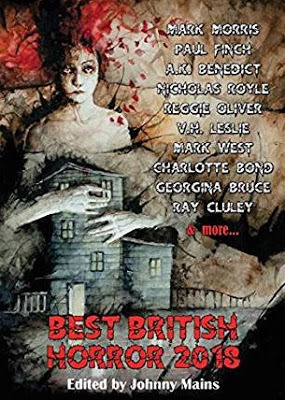 BEST BRITISH HORROR 2018 ed by Johnny Mains (2018)
BEST BRITISH HORROR 2018 ed by Johnny Mains (2018)Contrary to popular opinion, short horror fiction is in a healthy state these days. Okay, it may not appear very regularly from mass-market publishers, and in fact is scattered widely across the independent presses both here in the UK and the US and now even further afield. There is literally a vast number of practitioners. Of varying skill, admittedly, though a lot of them are very good indeed, and their work would sit comfortably back in the 1960s and 1970s, when the Pan and Fontana horror series ruled the supermarkets and railway forecourts (in fact, some of them are superior to many of that era’s routinely gruesome offerings, written with much greater care and imagination).
Of course, the quickest way to find these new stars of short-form scarefare is through the plethora of now annual Year’s Best anthologies. Unfortunately, by the nature of the beast, these books can only ever scratch the surface of what’s out there more widely. But whenever you get hold of them, they are still worth studying in detail because invariably their editors have done an awful lot of wide-ranging research before compiling their final tables of contents.
On which subject, step forward editor, Johnny Mains, a man whose knowledge of short horror fiction is surpassed only by his love for that genre and his tireless efforts to bring the very best authors, both old and new, to the attention of the broader public. One of Mains’s most heartfelt quests has been to establish a regular Best British Horror series. Through no fault of his own, and despite valiant efforts, this hasn’t yet become a reality, though he hasn’t given up so far and has brought several such titles out already.
This latest one, Best British Horror 2018 , from NewCon Press, clearly shows what the world is currently missing.
Mains certainly has an eclectic taste in horror, which is a good thing, I suppose, when you’re working on a Year’s Best volume, and it’s amply illustrated in this one, the stories ranging far across the chiller spectrum in terms of their subject-matter.
To start with, fans of traditional Gothic horror will be more than satisfied.
Mains’s choices hit this note repeatedly (though not solely). Reggie Oliver, a big favourite in the genre for his ability to elicit genuine terror with the most gentlemanly prose, hits us twice in this anthology, but most impressively with the unnerving Love and Death , which concerns a mysteriously captivating and highly dangerous work of art, while Daniel McGachey, whose reputation in the world of ‘Jamesian’ horror is growing fast, contributes Ting-A-Ling-A-Ling , the story of a magnificent but malevolent old clock, which, whenever it chimes, bodes well for no one (much more about this one and Love and Death later). Then there is Mark Morris’s flat-out horrifying We Who Sing Beneath the Ground , in which Stacy, a young teacher, relocates to Cornwall, but becomes so concerned when one of her pupils at the village school is strangely absent that she makes an ill-advised trip to the remote and dilapidated farm where he lives …
Morris’s soon-to-be-classic Cornish chiller links us nicely into the next subgenre touched on by Mains, which is surely ‘Monsters’. Not everyone goes for this kind of in-yer-face horror. Some readers consider themselves too grown-up or are convinced there should be no place for physical aberrations in modern age scare fiction, when warped psychology is known to be the root of so much fear and despair and Man himself has been exposed as the worst offender in terms of basic cruelty. But as Best British Horror 2018 shows, when done properly, and dare I say it – subtly – there can always be room for tales of nature gone mad.
For example, check out VH Leslie’s Shell Baby , in which something truly awful comes out of the Hebridean Sea (more about this one later), or Laura Mauro’s Sun Dogs , in which young Sadie, the child of misguided survivalists, now lives alone on the edge of the Nevada desert, but then takes in a ragged stranger, June, to whom she is immediately attracted even though June’s arrival seems to coincide with a recent spate of fatal animal attacks.
A different corner of creepy fiction fast-growing in terms of popularity, in fact blooming exponentially at present, is folk-horror. If you discount the Mark Morris story (which sort of fits that bill), Johnny Mains only selects one very folky story on this occasion, but it is more than satisfying, one of the best in the book in my view (not to mention most disturbing), and is probably the first story of this bunch that you may want to read twice just to make sure you haven’t missed any of its nuances. In a nutshell, in Claire Dean’s very clever The Unwish , a dysfunctional family return to their favourite holiday cottage out in the countryside, but sibling rivals, Amy and Sara, don’t get on, Amy’s new boyfriend is late arriving, while Amy herself is increasingly convinced that one time when they were here, even though no one else seems to remember it, she had a little sister …
Of course, no collection of horror stories can possibly exist in modern times without taking a couple of trips at least into the darker recesses of the human mind. Psychological horror is always a challenge to write effectively, authors who prefer it often seeking to unsettle their readers rather than petrify them, though when it’s done successfully, be prepared to be blown out of your comfort zone in a big way.
Three coldly effective examples from Best British Horror 2018 do exactly this.
Ray Cluley gives us In the Light of St Ives , in which eccentric artist, Claire, sets fire to her house in Cornwall, and is badly burned in the process, her older sister, Emily, investigating but unsure whether Claire’s incredible revelations about the light and colour in the house betray an unhinged mind or something much more sinister. Cate Gardner, meanwhile, who can always be relied on to pick at the rawest of nerves, adds Fragments of a Broken Doll , in which we meet demented OAP, Trill, who lives in a slum tenement close to a prison. When a convicted murderer escapes, he hides in her house, constantly protesting his innocence. But the real question is how innocent is Trill?
After that, we have Dispossession , which comes to us from a true master and long-term exponent of the understated psychological chiller, Nicholas Royle. In this one, a disturbed man seeks sanctuary in a new flat, but can’t escape the influence of his old one or the endless memories of his own haunted past. This is another that you might want to read twice just in case you miss something, but even if you don’t, it will still affect you in that intangibly macabre way that Nick Royle stories seem to specialise in.
Psychological horror is often twinned closely with the sort of surreal, fantastical horror that at one time used to be called ‘slipstream’ (especially when it busted the boundaries between genres). I was never the biggest fan, but that doesn’t mean I didn’t recognise the talent so regularly on show, and that is certainly the case with Georgina Bruce’s The Book of Dreems , which introduces us to Kate, who might be a real person, but might also be an android, a doll, a so-called ‘dreemy peep’. Kate herself isn’t sure. But she knows one thing: Fraser, the man who controls her, bosses her, fixes her glitches and then purposely breaks her again, is a tyrant who needs to be stopped. It’s a strange one for sure, an ugly nightmare of a story, but so engrossing that you’ll read it right to the end.
Of course, whereas horror was once seen as second rate pulp, as the naughty child of adult fiction, the bad boy who lots of people liked but wouldn’t admit to it, the reality has always been that dark tales can inform as well as entertain. Sometimes these are difficult roads to take because we don’t always like facing the sad realities of our lives, or the messed-up world we have contributed to creating. Yes, stories like these can be gloomy avenues, but they can be instructive too, even if garish and gory.
The two most serious stories in Best British Horror 2018 , aren’t especially gory (or garish, for that matter), but they are grim explorations of human frailty and are thus of high value.
In James Everington’s twisty The Affair , retired middle-aged couple, Neil and Lynda, are haunted by two dopplegangers: younger, more energised versions of themselves, whose youth and virility are a torturous reminder of all they have lost. Then we have The Lies We Tell by Charlotte Bond, in which self-centred realtor, Cathy, lies constantly to her children, who she doesn’t care for anymore, and to her husband, Vikram, who doesn’t yet know about the affair she is having. Someone knows, however. Someone who has been keeping a careful tally of every untruth that Cathy has ever uttered …
So, there we have it. That is Best British Horror 2018 . I haven’t mentioned all the stories in this book; I don’t want to spoil everything for you. Suffice to say that this is an ambitious collection of very varied tales, put together with care and loving attention. No doubt there were many other stories published in 2018 that could have been included, but there has to be a cut-off point somewhere, and editor, Johnny Mains, has done us all a great service here in trying to cast as wide a scope as possible on the work being done by Brit horror authors in contemporary times. This is an outstanding collection, which all true fans will delight in.
And now, after all that, we have …
BEST BRITISH HORROR 2018 – the movie
Okay, no film maker has optioned this book yet (as far as I’m aware). However, this part of the review is always the fun part, so I’m going to crack on with it anyway. As such, here are my thoughts in anticipation of someone loaded with cash deciding that this lovely little book should immediately be on the screen.
Note: these four stories are NOT the ones I necessarily consider to be the best in the book, but these are the four I perceive as most filmic and most right for adaptation in a compendium horror. Of course, no such horror film can happen without a central thread, and this is where you guys, the audience, come in. Just accept that four strangers have been thrown together in unusual circumstances that require them to relate spooky stories.
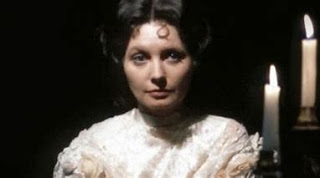 It could be that they are nervous offerings made by prospective new members to the merciless Club of the Damned (a la
Supernatural
, right) or maybe are related to us in the form of atmospheric fireside readings (a la Spine Chillers) – but basically, it’s up to you.
It could be that they are nervous offerings made by prospective new members to the merciless Club of the Damned (a la
Supernatural
, right) or maybe are related to us in the form of atmospheric fireside readings (a la Spine Chillers) – but basically, it’s up to you.Without further messing about, here are the stories and the casts I would choose (though, timewise, a couple may need updating if they are to work in this context):
Love and Death (by Reggie Oliver): In Victorian London, Martin Isaacs, an unsuccessful artist, is commissioned to recover a missing work of genius, Love and Death, as painted by Basil Hallward, his former mentor, who has now disappeared. But the painting, a classical image in the Renaissance style, is deceptively beautiful. In reality, it destroys all that it touches …
Isaacs – Jordan Patrick SmithHallward – Michael Sheen
Shell Baby (by VH Leslie): Tired of life, lonely Elspeth rents an isolated cottage in the Orkneys. She seeks complete isolation, but still yearns for the daughter she never had. On the first night, a weird experience while swimming sees her befriend an unusual baby sea creature. Delighted, Elspeth nurtures it, mothers it even, but it grows at an alarming rate, along with its voracious appetite …
Elspeth – Naomie Harris
Tools of the Trade (by Paul Finch – sorry, guys, but I’m never going to miss a chance to put my own stuff on film): A journalist and amateur medium search a derelict Lancashire hotel, which they believe houses the original knives used in the Jack the Ripper murders. They envisage wealth, but in the process awaken an ancient evil …
Adam Croaker – Robert James CollierDick Wetherby – Richard E Grant
Ting-A-Ling-A-Ling (by Daniel McGachey): Just after WWI, an antiques expert is consulted by the agent of a deceased millionaire and hears the chilling tale of a malevolent timepiece, the Awakening Clock, which, whenever it chimes the mysterious 13th hour, brings all manner of darkness upon its owner …
Lawrence – Martin FreemanFosdyke – Martin JarvisHinchcliffe – Will Poulter Shorehouse – Burn Gorman
August 25, 2020
Terror soon coming to the Home Counties

Okay, well I’ve always believed in striking while the iron’s hot, so even though the dust hasn’t yet settled following the launch of my latest crime novel, ONE EYE OPEN, I’m now going to talk about a new book I’m bringing out in the near future, though this one, even though it’s equally dark, is very different in style and subject-matter. In short, it’s the latest in my series of Terror Tales anthologies, TERROR TALES OF THE HOME COUNTIES.
I can’t talk too much about it yet, though at least, as you can see, I’ve got the artwork to brag about (courtesy of the amazing Neil Williams) and can fill you in a little bit on the background.
Also this week, maintaining that Brit folk-horror(ish) tone, I’ll be reviewing THE SEVEN DEADLY SINS by Lanyon Jones, a legendary collection of traditional ghost stories from a writer whose contribution to the genre, though always quality, has largely now been forgotten.
If you’re only here for the Lanyon Jones review, then all you need to do is zoom on down to the lower end of today’s blog, where you’ll find it, as usual, in the Thrillers, Chillers section. However, if you’ve got a bit more time, there are a couple of other things I want to mention. First off …
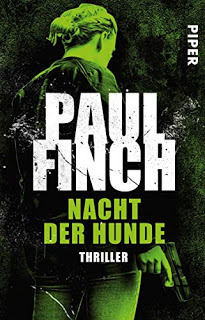 Lucy in Germany
Lucy in GermanyMy third Lucy Clayburn novel, STOLEN , will be published in Germany in approximately one year’s time, but the official cover is already being publicised, and I have to say, it’s yet another very cool piece of work from Piper Verlag, all of whose jackets for this series, and for the Heck series too, have been hugely eye-catching in my view, and have always – particularly with regard to the Lucy books – leaned strongly towards the action-thriller genre, unlike the British versions, which hinted more at domestic noir.
Anyway, here’s the latest. NACHTE DER HUNDE , which loosely translates as NIGHT OF THE DOGS. With luck, all my readers over there will enjoy it thoroughly.
And now that other thing I want to chat to you about today …
Home Counties horror
Hopefully, lots of ghost and horror story fans will now know about my Terror Tales series, which I’ve been editing – initially under the Gray Prior Press banner, but now with TELOS PUBLISHING – for the last nine years.
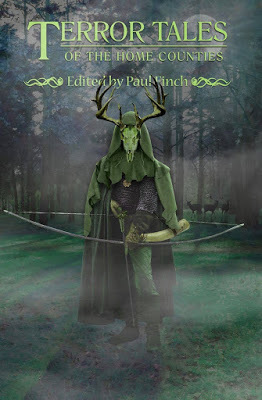 The concept behind this series was to tour the British Isles, each book focussing on a different geographic region and publishing original horror fiction related to the myths or lore of that region, interspersing it with non-fictional (i.e. real life) tales of terror and mystery. The plan was always to draw on folklore and history, to try and create as authentic an atmosphere of each book’s particular district as possible, and to use a wide range of writers (though some, inevitably, have been back for more and more). Not all of the authors had to be native to the region under consideration, but at least they needed to be familiar with it.
The concept behind this series was to tour the British Isles, each book focussing on a different geographic region and publishing original horror fiction related to the myths or lore of that region, interspersing it with non-fictional (i.e. real life) tales of terror and mystery. The plan was always to draw on folklore and history, to try and create as authentic an atmosphere of each book’s particular district as possible, and to use a wide range of writers (though some, inevitably, have been back for more and more). Not all of the authors had to be native to the region under consideration, but at least they needed to be familiar with it. TERROR TALES OF THE HOME COUNTIES is the latest in the series, and will be out this autumn. Apologies that I can’t be specific with a date of publication yet, or a full table of contents, but the book is now complete and in the process of being proof-read. All that other essential info will be posted here as soon as it’s actually available.
I assure you, contrary to a lot of opinion – and I’ve been greeted by raised eyebrows several times when mentioning this book – the Home Counties are not without their own chilling pantheon of native tales. All sorts of nasty stuff has gone on amid those well-heeled, semi-rural communities. Oh yes, the veneer of sedate prosperity can conceal a wealth of sins. But in addition to that, the Home Counties weren’t always the dormer district to London. Once, there were unbroken tracts of forest and heath where now there are suburban railway stations and blue chip company HQs. Where the stockbroker belt now flourishes, formerly there were sacred groves and woodland pools; and while the scenery might have changed, the occupants of these ancient sites haven’t necessarily gone anywhere.
But I’ll say no more about it at this stage. Hopefully, the blurb on the artwork at the top of this column will serve as a good indicator of TERROR TALES OF THE HOME COUNTIES’ flavour.
This will be the twelfth book in the series thus far. We’ve been all over the UK and even out to sea. And even if I say so myself, we’ve included some masterly pieces of fiction from recognised experts in the field like Peter James, Ramsey Campbell, Stephen Gallagher, Adam Nevill, Stephen Laws, Lynda Rucker, Carole Johnstone and Sam Stone (along with many others).
Here are several sample covers from the rest of the Terror Tales series, and the blurbs that accompanied them:
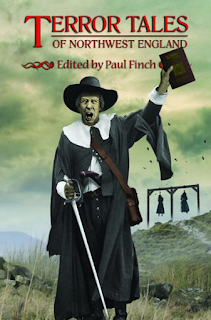 TERROR TALES OF NORTHWEST ENGLAND
TERROR TALES OF NORTHWEST ENGLAND
England’s majestic Northwest, land of rain-washed skies, dark forests and brooding, windswept hills. Famous too for its industrial blight and brutal persecutions; a realm where skulls scream and witches wail, gallows creak and grave-robbers prowl the long, black nights …
The hideous scarecrows of LuneThe heathen rite at KnowsleyThe revenge killings in PrestonThe elegant ghost of CombermereThe berserk boggart of MostonThe malformed brute on MannThe walking dead at Haigh Hall
 TERROR TALES OF CORNWALL
TERROR TALES OF CORNWALL
Cornwall, England’s most scenic county: windswept moors, rugged cliffs and wild, foaming seas. But smugglers and wreckers once haunted its hidden coves, mermaid myths abound, pixie lore lingers, henges signal a pagan past, and fanged beasts stalk the ancient, overgrown lanes …
The serpent woman of PengersickThe screaming demon of Land’s EndThe nightmare masquerade at PadstowThe feathered horror of MawnanThe terrible voice at St AgnesThe ritual slaughter at CrantockThe hoof-footed fetch of Bodmin Moor
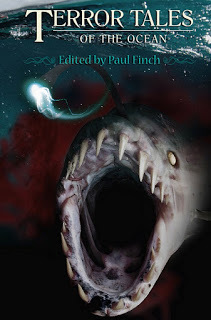 TERROR TALES OF THE OCEAN
TERROR TALES OF THE OCEAN
The rolling blue ocean. Timeless, vast, ancient, mysterious. Where eerie voices call through the lightless deeps, monstrous shapes skim beneath the waves, and legends tell of sunken cities, fiendish fogs, ships steered only by dead men, and forgotten isles where abominations lurk ...
The multi-limbed horror in the Ross SeaThe hideous curse of Palmyra AtollThe murderous duo of the Messina StraitThe doomed crew of the Flying DutchmanThe devil fish of the South PacificThe alien creatures in the English ChannelThe giant predator of the Mariana Trench
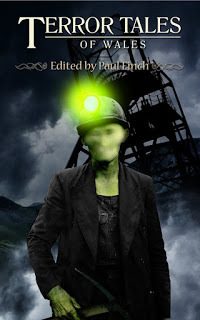 TERROR TALES OF WALES
TERROR TALES OF WALES
Wales – ‘Land of my Fathers’, cradle of poetry, song and mythic rural splendour. But also a scene of oppression and tragedy, where angry spirits stalk castle and coal mine alike, death-knells sound amid fogbound peaks, and dragons stir in bottomless pools …
The headless spectre of KidwellyThe sea terror off AngleseyThe soul stealer of PorthcawlThe blood rites at AbergavennyThe fatal fruit of CricciethThe dark serpent of BodalogThe Christmas slaughter at Llanfabon
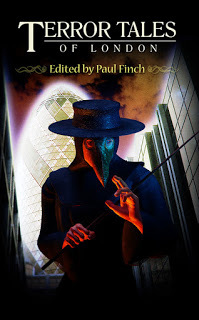 TERROR TALES OF LONDON
TERROR TALES OF LONDON
The city of London – whose gold-paved streets are lost in choking fog and echo to the trundling of the plague-carts, whose twisting back alleys ring with cries of ‘Murder!’, whose awful Tower is stained with the blood of princes and paupers alike …
The night stalker of HammersmithThe brutal butchery in HolbornThe depraved spirit of SydenhamThe fallen angel of DalstonThe murder den at Notting HillThe haunted sewers of BermondseyThe red-eyed ghoul of Highgate
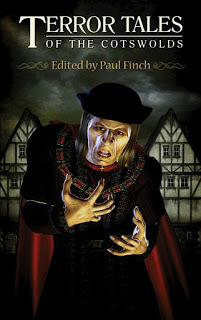 TERROR TALES OF THE COTSWOLDS
TERROR TALES OF THE COTSWOLDS
The Cotswolds – land of green fields, manor houses and thatched-roof villages, where the screams of ancient massacres linger in the leafy woods, faeries weave sadistic spells, and pagan gods stir beneath the moonlit hills …
The flesh-eating fiend of St. John’sThe vengeful spirit of Little LawfordThe satanic murders at Meon HillThe ghastly mutilation at WychavonThe demon dancers of WarwickThe cannibal feast at AlvingtonThe twisted revenant of Stratford-upon-Avon
If you like the sound of all this, folks, and you fancy dipping into the dark side of the Home Counties, just keep watching this space. As already stated, all the info you’ll need will be posted on here as soon as it’s available.
THRILLERS, CHILLERS, SHOCKERS AND KILLERS …
An ongoing series of reviews of dark fiction (crime, thriller, horror and sci-fi) – both old and new – that I have recently read and enjoyed. I’ll endeavour to keep the SPOILERS to a minimum; there will certainly be no given-away denouements or exposed twists-in-the-tail, but by the definition of the word ‘review’, I’m going to be talking about these books in more than just thumbnail detail, extolling the aspects that I particularly enjoyed (I’ll outline the plot first, and follow it with my opinions) … so I guess if you’d rather not know anything at all about these pieces of work in advance of reading them yourself, then these particular posts will not be your thing.
 THE SEVEN DEADLY SINS
by Lanyon Jones (1979)
THE SEVEN DEADLY SINS
by Lanyon Jones (1979)Keith Lanyon Jones, an author we haven’t heard much from since the mid-1980s, wrote in his spare time but by vocation was an Anglican vicar, and so inevitable similarities have been drawn between him and MR James, especially as both of them worked within the familiar English ghost story tradition and penned their terrors initially as Christmas entertainments for friends and family. However, while there is some resemblance between the two, that isn’t the whole story by any means, and Jones, while his writing career appears to have been relatively short-lived, was clearly open to other influences as well, not least Arthur Machen and even HP Lovecraft.
In 1979, he presented his publisher, William Kimber, with this ‘concept album’ of a collection: seven completely new supernatural tales, all linked together by the central theme of the Seven Deadly Sins, each story representing one of the sins in particular.
Here’s the blurb that originally appeared on the inside sleeve:
In this unusual book the author invokes a world of the macabre, of evil and the powers of darkness. But his world has a difference. For in it, evil is not brought about by malign outside forces acting with irrational and random blows against mankind, but by mankind’s own weaknesses. Pride, covetousness, gluttony, lust, sloth, anger and envy. To each is devoted a tale of force and power, demonstrating how from little beginnings man can be led down the primrose path to chaos and evil. Writing with perceptions of the working of men’s minds, the author has created seven tales around this ancient conception with modern application.
You’d have thought, perhaps from the outset, that with Lanyon Jones being himself a priest, he’d have a clear and tight grip on the concept of the Seven Deadly Sins, but one immediate weakness that struck me about this book was how irrelevant that central theme becomes once the story-telling actually gets going. The links between the stories and the sins are tenuous in almost every case, virtually invisible in a couple, and while that doesn’t detract from the stories themselves, given that there isn’t much else to the book – there is no encompassing central narrative concerning the Seven Deadly Sins, for example, and no connections between the stories themselves or the characters who appear in them – the overall concept is so undeveloped as to seem pointless.
In fact, I’d go as far as to wonder if Jones handed over a batch of new stand-alone ghost stories first, and possibly after some consultation with his editor, who wanted something a bit different, retitled it The Seven Deadly Sins afterwards, apportioning one sin to each story even if the emphasis of the story itself lay somewhere else.
As I say, though, this has no bearing on the seven stories themselves, which cover a range of subjects and demonstrate a variety of other influences. The quality, as you’d find with any collection of fiction, whether it all stems from the same author or is part of an anthology of tales by many authors, is variable. Some of the stories have dated a little, while others imply a vaguely innocent outlook on life (which the work of MR James never did, despite his scholarly bachelor background), but if the main purpose of a ghost story is to frighten its readers, then on the whole, Lanyon Jones does a pretty good job here, most of these forays into the supernatural packing in several extremely scary moments.
Given that there are only seven stories to consider, and that they are all, notionally at least, connected by the same theme, I won’t do my usual thing with collections of short fiction, which is pick out the handful I enjoyed most and talk about them in detail. Instead, I’ll run through them all in order. And as I always like to do some imaginary casting at the end, I’ll play that game here too, falsifying a Seven Deadly Sins TV series and putting together a minor cast for each episode (just a bit of fun, of course).
The Weirdwood (Pride)
Neilson, a new vicar in a rural parish considers himself too modern to indulge in such antiquated rituals as ‘beating the bounds,’ which alarms his rustic congregation. They have lost livestock recently, the bodies of sheep found torn and covered in slime. They blame whatever lurks in the so-called Weirdwood, a dense area of trees, which grows beyond the parish in a strange and unnatural hollow. Collins, vicar of the next parish along, advises that old customs should be respected, but still Neilson resists. Until one of his aged parishioners tries to beat the bounds himself, and promptly disappears …
A rather lengthy tale to open the collection, Jones immediately hitting us with a folk-horror vibe, implying that certain time-honoured parish rituals might have more than a ceremonial role in the unchanging village life of the English countryside. Lots of stuff about the druids in this one, tree worship and ancient spirits long thought suppressed by Christianity, along with some atmospheric descriptions of menacingly thick, leafy woodland, and a scary and unusual monster.
In our imaginary TV show:Neilson – David TennantCollins – Timothy Spall
The Collector (Covetousness)
Scheming academic, Casgil, travels to remote Woolminster Cathedral the week before Christmas, where he has convinced benevolent Canon Cedric that he wishes to examine a batch of medieval documents. In reality he is seeking the antique chess set that a former Woolminster canon, who was also a warlock, supposedly used in a match he played against the Devil. Canon Cedric doesn’t seem to know about this, and so graciously allows Casgil to commence his search in the cathedral’s old and eerie library …
The best and most frightening story in the book for me, and easily the most reminiscent of MR James. Lots of monkish terror, a snowy Christmas setting and a musty old cathedral archive that fills with spooky shadows worryingly early on December afternoons all add to the flavour, while the nasty twist at the end is a genuinely horrifying one. All round, an excellent and satisfying tale.
In our imaginary TV show:Casgil – Lennie JamesCanon Cedric – Hugh Bonneville
An Inheritance (Anger)
Old Harold attempts to dissuade his nephew, Mark, from buying an ornate house in his West Country village, claiming that the 16th century property has a troubled past. To try and prove his point, Harold tells Mark the story of Ralph Asher, who inherited the same house many years earlier, and was subjected to bizarre and hostile phenomena …
This one is a story within a story, and, in the first instance at least, is told in a confused, rambling fashion to represent the drifting concentration of Old Harold, but that doesn’t help the narrative much. In fact, it confuses things a little. We get there in the end, partly through dollops of expo, and though once again there are several effective Jamesian scares en route, this piece overall feels oddly imbalanced, which dilutes its impact.
In our imaginary TV show:Uncle Harold – Michael PalinRalph Asher – Christopher Eccleston
Hush-A-Bye, Baby (Lust)
Wealthy husband and father, Roland, brings his mistress, Miriam, to his family’s holiday home on the coast. Miriam has engineered this by deliberately leaving her last abortion late in the full knowledge it would make her ill, thus pricking Roland’s conscience so that he’d want to make it up to her. Miriam is a diehard gold-digger and convinced that all this will soon be hers. But old money isn’t easily available and both the aristocratic living and the aristocratic dead will have their own say on the matter …
In some respects, this story hasn’t aged well. The amoral mistress using the abortion of her married lover’s child to pressurise him into gold-plating her future (while he, though callous and distant, is depicted in a much less sinister light) is unlikely to win support in the age of the #MeToo movement. And this is a shame, because this is a tight and tense little story, sharply written, with believable characters and an effective setting, and once again some disturbing scare moments.
In our imaginary TV show:Roland – Richard MaddenMiriam – Gemma Arterton
Exorcism (Sloth)
A lower middle-class family buy the home of their dreams in the wilds of Cornwall, but straight away there are problems. The two cats that come with the house don’t like them, furniture moves around on its own, there are cold spots on the back stairs, and then they learn that it once belonged to an elderly lady who was regarded in the neighbourhood as a self-taught witch and who may well have been murdered in the house by her own husband …
The second haunted house story of the collection, but for me the most disappointing tale in the book, because while, like An Inheritance , it lays down an immediately dark and menacing atmosphere, a likeable family finding themselves in the grip of malevolence, their opponent an unknowable and implacable force from beyond that manifests itself in all kinds of bone-chilling ways, it all ends on a ridiculously twee and disappointing note about which, frankly, the less said the better. In addition to that, I still haven’t been able to work out where ‘sloth’ comes in.
In our imaginary TV show (though the ending would need a complete rewrite to make my TV version):Clare – Sara MartinsJohn – Ben Whishaw
The Coastguard (Gluttony)
An enthusiastic young biographer is assigned to work on the life story of a World War Two hero who has recently died. However, a series of weird events leads him to the tale of a mysterious character called Old Harry, and an isolated and mostly empty coastal village, which his desolate and fearsome spirit is still said to haunt …
Melancholy balances equally with supernatural chills in this meaningful and superior ghost story, which, though it deals with complex human weaknesses like failure, regret and guilt, works steadily towards its poignant conclusion, throwing in numerous jolts of terror along the way. Of all the stories in The Seven Deadly Sins , this one probably least deserves its overarching epithet. To talk about ‘gluttony’ in the context of this tale, while it’s not irrelevant, seems almost trite.
In our imaginary TV show:The Biographer – Dev PatelThe Editor – Martin ClunesLady Jeffries – Sheila Hancock
Tempus Memoret (Envy)
Covetous antiques dealer, Pither, is determined to have the miniature replica of the great cathedral clock at Silchester despite the gruesome story that a Tudor-age curse still lies upon it. The smaller clock is currently owned by aged shopkeeper, Norris, but Norris doesn’t appear to have long to live …
A slow-burner of a chiller, which again leads steadily towards a much anticipated climax, with lots of ultra-scary moments along the way, and some wonderfully eerie and atmospheric scenes, particularly inside Norris’s dust-shrouded Aladdin’s Cave of a shop. Sadly, though, despite the establishment of a genuinely intriguing mystery, I don’t think the pay-off is really there. But, as is often the case with weird fiction, satisfaction tends to be in the eye of the beholder.
In our imaginary TV show:Pither – Phil GlenisterNorris – Patrick Stewart
So, there we are. That’s The Seven Deadly Sins . If I’ve sounded so-so about this one, I still consider it a major stepping-stone in the ongoing drama of the English ghost story tradition. Despite being written in the 1970s, it harks back to an earlier, less cynical age, but most readers, I think, will thoroughly enjoy it. It’s left me feeling sorry that there aren’t lots more Lanyon Jones collections out there to snare my attention (there is one that I know about, When Dusk Comes Creeping In , which I’m on the hunt for next).
August 14, 2020
The big day approaches. Are you ready?
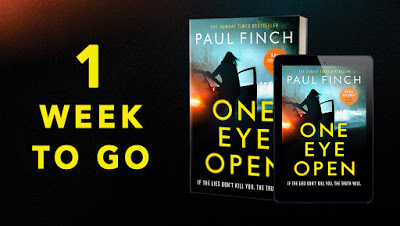
Okay, well I apologise in advance this week. With only a few days to go to publication of my next novel, ONE EYE OPEN, today’s blogpost is mostly going to be about that. I’ll discuss its background a little, but will also be throwing in a few choice quotes from the thirty-plus reviews that are currently sitting on NETGALLEY, along with a snippet or two from different parts of the book (just to hint at what you’re in for).
In addition, to maintain the hardcase crime theme, I’ll also be reviewing Lou Berney’s 1960s-set thriller, NOVEMBER ROAD . You’ve probably heard quite a bit about this one already. It was lauded almost from the day of its release and now has been shortlisted for both the Gold Dagger Award and the Ian Fleming Steel Dagger Award (which happens once in a blue moon, trust me). It you want to hear my thoughts on it, which I offer in some detail, you’ll find a full review at the end of today’s blog, as usual under the Thrillers, Chillers section.
If that’s the only reason you’re here, I can’t stop you scooting straight down there right now. Alternatively, if you’ve got a bit of spare time first, you might also be interested in …
One Eye Open
After what I like to think was a reasonably successful ten-book tenure at Avon (HarperCollins), I moved to Orion twelve months ago, and agreed with my new editor straight away that what was needed to kick off the new contract was a stand-alone thriller, something unconnected to either my Mark Heckenburg or my Lucy Clayburn series. (NB: That does NOT mean that those series are over. It just means that I’m taking a brief break from them).
 After several discussions down at Orion, during which we kicked around a lot of crime/thriller ideas, we eventually settled on the concept that has now become
ONE EYE OPEN
.
After several discussions down at Orion, during which we kicked around a lot of crime/thriller ideas, we eventually settled on the concept that has now become
ONE EYE OPEN
.The book is only published next Thursday (August 20), so is still only available for pre-order at present. However, as I’ve already mentioned, over thirty approving reviews now sit on NETGALLEY , and here I thought I’d clip a few juicy snippets from them just to get you going:
Gangland warfare erupts in the English home counties in this dazzling thriller. The twists in the plot come fast and furious and the pace never slackens. Robin P
Breathtaking, shocking and dark! All the things I love most from the fiction world! Samantha L
I’m sad that this is billed as a stand-alone as I really like DS Lynda Hagen who is a woman for our times. She’s smart and effective but stuck in a 9-5 job in Traffic so that she still has time with her kids. She is continually underrated both by her husband, a former Major Crimes detective, and her boss but she shows them here what she can do. You go girl. Elaine T
No spoilers here, just read it and enjoy, you won’t regret reading it. Beverley S
Obviously, responses like these put me on Cloud Nine. But what’s the story behind the new book? Where did it come from? What themes does it concern itself with?
Well, the first thing I wanted to do with ONE EYE OPEN was move away from the tightrope-walking crime-fighters that have featured in my previous works. It’s still a police thriller, but this time I opted to soften the edges a little bit, and so created the character, Lynda Hagen, a long-serving copper but no longer part of CID, because, in an effort to seek more regular hours and make life easier for her husband and children, she joined the Essex Roads Policing Division (in other words, Traffic), to work as an accident investigator.
So, she’s still a cop, still in plain clothes, and is still nominally a detective, but mostly Lynda concerns herself with traffic offences stemming from high-speed smashes. She tends primarily to work weekdays, and leads a fairly suburban ‘working mum’ existence. But then she is handed something completely out of the blue: a very serious but quite baffling accident. A car that shouldn’t exist found crushed to concertinaed wreckage in the middle of a frozen wood, the persons driving it both half dead, deeply unconscious and yet with no IDs on either of them. There are other anomalies too, all of which arouse the detective deep inside Lynda, leading her along a lonely path into a progressively more dangerous world of organised crime, armed robbery and murder-for-hire.
Is she up for it?, you may ask. Is the ace thief-taker she once was still latent within her? Well, I guess you’ll have to read it if you want to find out.
But ONE EYE OPEN doesn’t just focus on Lynda’s journey. For the first time ever in one of my crime novels, I run parallel storylines, taking a criminal’s perspective too, and, I hope, showing that not everyone who ends up on the wrong side of the fence wants to be there or ever intended to be.
 Never fear, by the way; I’m not making excuses for bad ’uns. Just pointing out that while my Heck books in particular might be famous for featuring antagonists who are utter grotesques, Batman or Bond-type villains of spectacular dementedness, that is rarely the case in the real world (but don’t worry; there are one or two of those in
ONE EYE OPEN
as well).
Never fear, by the way; I’m not making excuses for bad ’uns. Just pointing out that while my Heck books in particular might be famous for featuring antagonists who are utter grotesques, Batman or Bond-type villains of spectacular dementedness, that is rarely the case in the real world (but don’t worry; there are one or two of those in
ONE EYE OPEN
as well).Another question I’m increasingly asked these days concerns the subtext or themes of my writing.
In answer to that, I’m not sure that any of us set out intending to highlight certain themes, but perhaps we do it subconsciously. Most of us are usually writing with key issues in the backs of our minds, and if we bring these out in our work (preferably in non-heavyhanded fashion) then all the better. I suppose the one major theme I touch on in ONE EYE OPEN is the notion of individuals being what they were always supposed to be, or at least striving to achieve that. People of all creeds fulfilling not just their heart’s desire, but the purpose they consider themselves to have been put on this Earth for. If such a thing exists.
Heavy stuff, eh?
Perhaps I should cut the subtext chatter there then. Instead, let’s go to a couple of trailers, which hopefully you’ll find atmospheric:
‘One thing that puzzles me,’ Clive said. ‘How can this girl be a stripper and a junkie? Do needle tracks turn blokes on these days?’ ‘The way I hear it,’ Lynda replied, ‘a lot of them inject between their toes.’ He grimaced as they strolled along the park path, which now followed a broad curve. About fifty yards ahead, it brought into view a bench on which a figure in a grey hoodie top was sitting alone, the hood pulled up. ‘Excellent,’ Clive said. He made to walk forward, but Lynda halted him. ‘What’re we waiting for?’ ‘Leverage. Real leverage, this time.’ She nodded. ‘And here it comes.’ They ducked behind some skeletal bushes, watching as a spindly character sauntered from the other end of the path towards the seated figure. He’d come from a battered white van, which waited, exhaust billowing, at a distant gate. He was about sixteen or seventeen, wearing skinny jeans, a black puffer jacket and blue baseball cap. His fluorescent green and orange trainers somehow exacerbated the spider thinness of his legs. ‘Can’t be long out of school, that one,’ Clive muttered. ‘County Lines shithead,’ Lynda said under her breath. The kid stopped at the bench. There was an exchange of words, and then he passed something to the seated girl, she passed something back, and it was over. He strolled back towards the van, the girl pocketing her purchase and standing up. ‘Let’s move,’ Lynda said. They sidled out onto the path. At first the girl didn’t notice. Even though she was coming in their direction, her hands were in her pockets, her head down. But then, sensing their presence, she glanced up – in response to which Clive made a critical error. He stepped out and away from Lynda, expanding their line in the standard police way when approaching a suspect, though of course in this instance it clearly indicated to the subject who and what they were. She ran, veering left onto the grass, heading towards a distant hedge, on the other side of which lay the nearest road. Lynda veered the same way, trying to cut her off. Clive sprinted down the path to try and prevent her doubling back. ‘Anja, we’re police officers!’ Lynda shouted. ‘Stay where you are!’ But the girl turned and cut sharply back the way she’d come. ‘Clive!’ Lynda yelled, as she turned to give chase. She was briefly distracted by the kid at the far end of the path. He’d twirled around, spotted the police activity and now leapt into the van, which screeched away. Looking back, she saw the diminishing shape of the girl haring towards the far side of the park. In the foreground, Clive climbed to his feet, swearing at the mud streaked down the side of his trousers. ‘Clive!’ Lynda complained. ‘She’s a dancer!’ he protested. ‘She’s nimble on her toes!’
And now, in a slightly different tone:
As Elliot had already seen, the cars were draped with green canvas, but the white-haired older guy now whipped the cover off the one at the far end, revealing a sleek Mercedes-AMG in gleaming metallic maroon. ‘What do you think?’ Jim asked. ‘Beautiful,’ Elliot said. ‘Come around the back. I want to show you something.’ Elliot followed. The older guy was waiting at the car’s rear; he opened the boot. Inside, it had been loaded with four paving stones, two on the left, two on the right. ‘These slabs weigh fifty kilograms each, so that’s an extra two hundred kilos in this little beauty’s backside,’ Jim said. ‘What do you reckon, Elliot?’ ‘Tough to handle at high speed, that’s for sure.’ Jim nodded. ‘Which is what tonight’s all about.’ He glanced at the older guy, who plodded away across the chamber to the facing wall, where Elliot now noticed there was a large pair of wooden sliding doors. With a heavy clanking, a chain was removed, and the doors were pushed open along their tracks, one after the other. Jim slammed the boot. ‘Fancy taking her for a spin?’ ‘Sounds like fun,’ Elliot replied. He opened the driver’s door, seeing a key waiting in the ignition. To his surprise, Jim then climbed into the front passenger seat, Ray Lonnegan into the rear. ‘If you want a proper test drive,’ Elliot said, ‘I can’t guarantee anyone’s safety.’ ‘That’s okay,’ Lonnegan replied. ‘At no stage can we guarantee yours. So it all pans out.’ Elliot glanced at Jim, who arched a laconic eyebrow. They drove forward, trundling through the doorway and down a shallow ramp into a gritty siding, where Elliot braked, fascinated by what he was seeing outside of the car. Three electric floodlights on tall steel poles had been switched on about forty yards to his right, and now cast their silver radiance over what looked like a disused racing circuit. The hangar behind them had obviously been a repair and garage facility, while to the left of that was the boarded-up structure of an old clubhouse or pavilion, complete with an upper balcony. On the other side of that stood a row of decayed, wooden scaffold-like structures. Tiered seating, he realised; bleachers. The track itself swung away from them both to the left and right. As its central area was little more than strewn rubbish, rusty cars and broken-down buildings, it was visible almost in its entirety. It wasn’t a circle, more of a rectangle, but with curved, steeply banked corners, covering maybe a mile and a half’s circumference. Elliot marvelled. ‘Is this the old Tunwood Raceway?’ ‘Should’ve known an ex-Formula One guy like you would recognise it,’ Jim replied. ‘Didn’t realise it was still here, let alone intact enough to use.’ ‘It’s not very intact, as you’re about to find out,’ Lonnegan said.
*
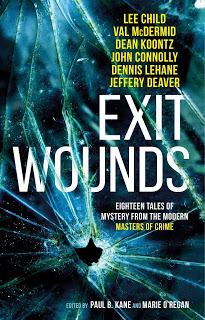 Now, just to prove that
ONE EYE OPEN
isn’t keeping me completely preoccupied this week, I also must thank everyone who had good things to say about my short story,
The New Lad
, which was published a year last May in the Titan Books’ crime anthology,
EXIT WOUNDS
.
Now, just to prove that
ONE EYE OPEN
isn’t keeping me completely preoccupied this week, I also must thank everyone who had good things to say about my short story,
The New Lad
, which was published a year last May in the Titan Books’ crime anthology,
EXIT WOUNDS
. It concerns a young bobby, the titular new lad, and his very first duty in uniform, which is to stand guard alone all night over a crime scene in the middle of a wood, quite close to a derelict mental hospital.
Well, I’m delighted to say that it’s now been shortlisted for the Short Story Dagger award by the CWA. This is a huge honour, the first time I’ve got anywhere near one of the Crime Writers Association awards, so I am more than grateful to everyone who had a word or cast a vote on my behalf. Apparently, the prizes are awarded in October, so I’ve no clue yet what the outcome might be, but if anyone’s interested enough to find out more, you just need to watch this space. I’ll trumpet it from the rooftops if I manage to win.
Not that I’m not up against tough opposition. Check some of these competitors out: Jeffery Deaver, Christopher Fowler, Lauren Henderson, Louise Jensen and Syd Moore.
THRILLERS, CHILLERS, SHOCKERS AND KILLERS …
An ongoing series of reviews of dark fiction (crime, thriller, horror and sci-fi) – both old and new – that I have recently read and enjoyed. I’ll endeavour to keep the SPOILERS to a minimum; there will certainly be no given-away denouements or exposed twists-in-the-tail, but by the definition of the word ‘review’, I’m going to be talking about these books in more than just thumbnail detail, extolling the aspects that I particularly enjoyed (I’ll outline the plot first, and follow it with my opinions) … so I guess if you’d rather not know anything at all about these pieces of work in advance of reading them yourself, then these particular posts will not be your thing.
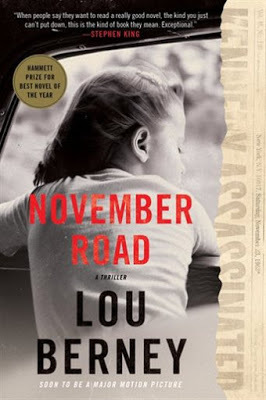 NOVEMBER ROAD
by Lou Berney (2018)
NOVEMBER ROAD
by Lou Berney (2018)
OutlineNovember, 1963. President John F Kennedy is shot and killed by a sniper while travelling through Dallas, Texas, in his open-topped motorcade. The whole of the US convulses with shock, but half a continent away, in New Orleans, the only things that matter to handsome, smooth-talking fixer, Frank Guidry, is drinking, enjoying life, getting laid, and staying tight with Carlos Marcello, the local Mafia don, for whom he hustles, grifts and evens scores on a daily basis, as a result of which he earns very nicely.
In the first few pages of November Road , we see Guidry at full power but deep in his own world, working both sides of Bourbon Street, watching the comings and goings, having sex with a drunken bar girl whose name he doesn’t even catch, turning over a fellow mob guy to his boss for fouling up (via the ever-cool and untrustworthy Seraphine, Carlos’s able and delectable lieutenant) and finally noticing that the President is dead.
It’s a national disaster, which is also having massive repercussions on the world stage, but even though the authorities already have the shooter in custody, an oddball nobody called Lee Harvey Oswald, Guidry, who has a personal-safety radar second to none, starts to wonder if it might become a problem for him in particular
He knows that his boss had a particular beef with the Kennedy brothers, both Jack and Bobby, for their crackdown on organised crime activities up and down the East Coast, and is now wondering about the blue Cadillac he was instructed to leave in Dallas only a couple of days ago. Even at the time, he assumed that it would be utilised by a hitman making a getaway after whatever job he was there to perform, but of course he could never have assumed that said job would be JFK himself.
Suddenly, this is ultra-serious stuff. If the FBI decide that this guy, Oswald, is a patsy, they might throw their net much wider. They’re already going to investigate far more robustly than if this was a regular hit. In addition, if Carlos was the man who gave the order, he won’t want any trails snaking back to him.
Was this the reason why Mackey Pagano, the fellow soldier recently served up to Carlos, has now met his end? Was Pagano what might be considered a loose end? Is it possible that Guidry, whose connection to the blue Cadillac may yet be discovered, could also be considered a loose end?
Suddenly, Frank Guidry decides that the Big Easy is about to get a mite too hot for him. But where can he flee to when the South’s boss of bosses is hot on his trail? Who can he trust to offer him cover when his role in the crime of the century is so plainly evident?
Meanwhile, in smalltown Oklahoma, spirited Charlotte Roy has finally had enough of her husband, Dooley. He doesn’t beat or abuse her, but he’s a chronic alcoholic who struggles through life, rarely achieves anything, and has no real hope of ever creating the future she seeks for her two young daughters, Joan and Rosemary. In a spur-of-the-moment decision, Charlotte packs the youngsters into the car, and leaves her hapless hubby, heading west, hoping to find refuge, at least temporarily, with a distant aunt who lives out in California and who she barely even remembers speaking to. Of course, it’s never as simple as that, and in due course, car trouble maroons Charlotte and her girls in Nowhereville (aka Santa Maria), New Mexico. Mired in a depressing motel and unsure where she’s going next, if anywhere, Charlotte then meets a good-natured and generous travelling man, who calls himself ‘Frank’ and who is apparently on his way to Los Angeles, and when all other alternatives are exhausted, who offers them a ride in his own car.
Guidry isn’t simply being generous by doing this. Nor is he looking to exploit the pretty young mother, even though he is attracted to her. But he can see the advantage of making the remainder of his journey (which will only be to Las Vegas, where an old underworld acquaintance may help him out) disguised as a homely husband and father. Carlos has eyes and ears everywhere after all, nearly all of which are looking out for Guidry the enforcer, Guidry the unmarried loner.
And it’s even more important to do this now. Because just to make matters much worse, just to raise the stakes dramatically, Paul Barone, the New Orleans’ boss’s deadliest assassin, is close behind him …
Review November Road has been widely praised since it was published in 2018, and rightly so in my opinion, though that doesn’t mean that it’s been without its naysayers. A couple of reviewers have called it clichéd, the hardbitten gangster who only realises that he’s got a heart of gold when he’s finally smitten by a smalltown girl who believes in honesty and integrity. Others have said that novels about Kennedy’s assassination and the aftermath are ten-a-penny, others that, as conspiracy theories go, this one isn’t particularly inspiring, yet others that the plot is simplicity itself, the book nothing more than a road trip.
Well … strangely, I’d agree with many of those verdicts, but at the same time I’d add that it’s also a whole lot more.
First of all, I always know I’m reading a good book, when, no matter how chunky it feels in my hand, I find that I’ve finished it in a couple of days, having rarely taken a break other than to put it down and say to myself: ‘Wow!’
November Road is slickly and succinctly written, Lou Berney never using a paragraph if a single sentence will do instead, though as sentences go, these are pretty special. Check out this description of Charlotte Foy, which completely illustrates her character in a few short words:
… a smalltown girl, as wholesome and dull as a field of corn, with a dog-eared New Testament in her purse and uncomplicated notions about right and wrong …
And then this portrayal of Nevada’s Lake Mead, as first seen by Charlotte:
Lake Mead was something of a shock, a rude and beautiful slash of iridescent blue in the middle of the dry desert, ringed by chocolate and cinnamon canyons.
And it’s pretty much like that all the way through. Simple, lyrical and lovely. Almost from beginning to end, November Road is economically but immersively written, every person and place vivid and real. It’s also a masterpiece of crisp, punchy character-work. The perfect example of this is Seraphine, who, for most of the narrative we only encounter as a voice on the telephone, but in each case she is silky smooth and deliciously deadly with her husky Creole tone and French Quarter accent.
It’s also a case that less is more with Paul Barone, the hitman, a character possibly based on real-life Mafia enforcer, George Barone (much as Carlos Marcello is the actual Carlos Marcello, a New Orleans kingpin who was genuinely suspected to have masterminded the Kennedy assassination). Berney consciously refrains from describing Barone in any real detail, presenting him to us as an ordinary looking man, who says very little (and rarely, if ever, issues anything so vulgar as a threat) but renders him a terrifying presence all the same, primarily by reputation but also because, somehow or other, the guy’s aura commands instant respect.
Of course, the real stars of the show are Guidry and Charlotte, both of whom embark as much on a voyage of self-discovery as they do a trip from east to west.
Guidry, who had a hellish childhood, has only ever been around mob people. But his natural wits and razor intellect have raised him above the general underworld herd. Additionally, they’ve left him wondering about that ‘other life’, the regular world of private citizens, which he’s always looked down on as something for suckers, though when he glimpses it through the prism of Charlotte’s safe and simple ambitions, looks for the first time as if it might be worth trying out. Of course, Guidry is still a killer. He thinks nothing of sending former buddy, Mackey Pagano, for the chop, and later on, when he makes dire threats to a couple of corrupt deputies in a hick town, you know that he absolutely means it.
So, it would indeed be a cliché if he then fell so head-over-heels in love with Charlotte and her children that his next move was to change sides, but of course life is never that simple. Not in reality and not in November Road . So no, what happens here isn’t a cliché at all. Very far from it.
Charlotte meanwhile goes on an even more complex journey, and like Frank Guidry, her direction changes half way through, and more than once. Yes, she is a hometown girl at heart, but the home she knows is boring, her husband unambitious, her opportunities limited. If she was just to take off and leave all that behind on her own, you might consider her selfish. But she does it with her children, specifically taking them to California, because in all the old stories of pioneers headed west, and in so many tales of drifters seeking the American Dream, California, the so-called Golden State, is their planned destination (even if most of them never make it). Ironically, though she gets to like Guidry a lot, is even smitten by him, the mother instinct will always come first with Charlotte. She’s not really looking for an adventure or romance. She’s looking for a new life for her two girls.
In this regard, the developing relationship between these two characters isn’t just beautifully written, it’s a powerful story all on its own, the intersection of their two roads a life-changing experience for the pair of them, and it’s all done so neatly and concisely that it’d be engrossing even without the underworld factor.
However, the underworld factor is there. And it’s there all the way through, and when you look at November Road simply as a hard-assed thriller, it’s pretty good on that level too.
The assassination of President Kennedy is really only the backstory, but it still unleashes a web of violence and intrigue all across the Southern States. There is tense drama as Frank Guidry makes slow but steady progress but is forever glancing over his shoulder, always wondering if the next person he meets on the trail will be someone looking to whack him.
Charlotte, of course, sails blithely through most of this, which makes you fear for her all the more, especially when she’s hooked up with Frank and yet remains unaware of his real past. And later on, when she’s in Vegas, her future dependent, it seems, on the whim of crazy gangster, Ed Zingle, your heart is in your mouth for her. There is one particularly chilling scene, which I won’t give to you in too much detail, but which sees the Vegas overlord and his minions making a half-hearted pretence of normality even though it is just sufficiently off-kilter to set all of Charlotte’s alarm bells ringing at once. Not to mention ours, the readers, because it’s scary stuff and for at least a couple of pages you really don’t know where it’s going to end.
The ‘live fast, die young’ Mafia lifestyle is nicely encapsulated in November Road . It’s set in the 1960s, when the Italian mob still dominated organised crime in North America, and there are strong reflections all the way through of gangster epics like Goodfellas and Casino : regular references to the bosses back home, constant awareness that in this world murderers come with smiles on their faces (either that, or they’re people you’ve known for thirty years), the idea that to rat out your friends is the worst thing you can do even though it’s painfully apparent that everyone has their price and no one can be trusted.
I’ll round off by saying that November Road is another of these crime thrillers that you just have to read to fully appreciate it. Lou Berney does a remarkable job here. The tone is perfect, the mood, the pace, everything is right on song. It’s much more than a thriller, but it’s taut and exciting and filled with characters you can easily relate to. Though deceptively simple, it’s written in accessible but poetic prose strongly reminiscent of some of the truly great American authors. You will not be disappointed.
As usual, I’m now going to attempt to cast this wonderful tale before a real casting director does it for an actual TV show or movie (one of which, I understand, is already in the works). Just a bit of fun, of course. Who would really listen to me?
Frank Guidry – Matthew RhysCharlotte Roy – Kerry BishéPaul Barone – Sebastian StanEd Zingel – Val KilmerSeraphine – Emayatzy CorinealdiCarlos Marcello – Chris Bauer



